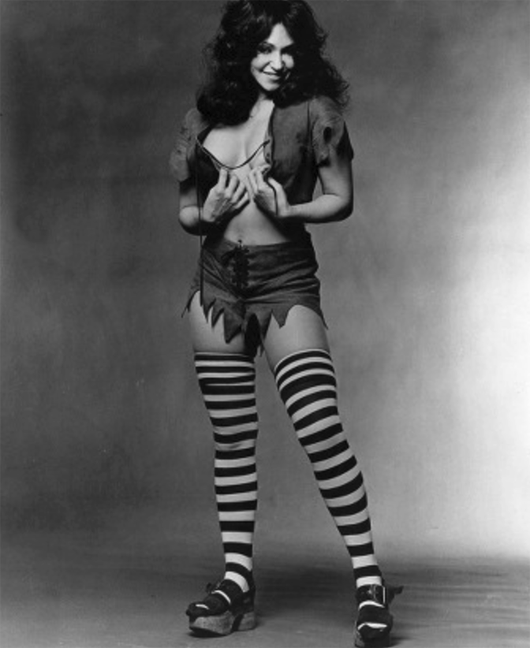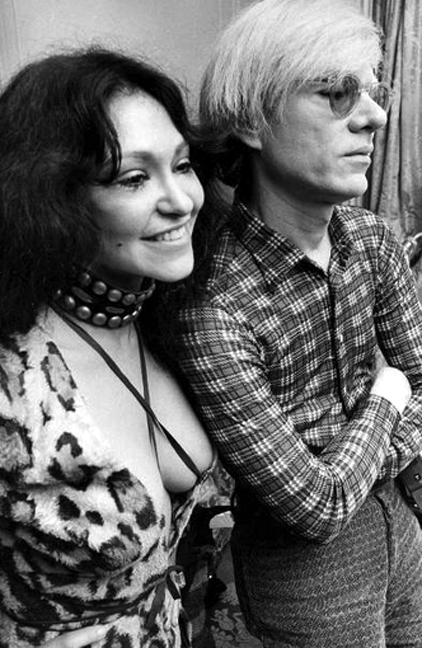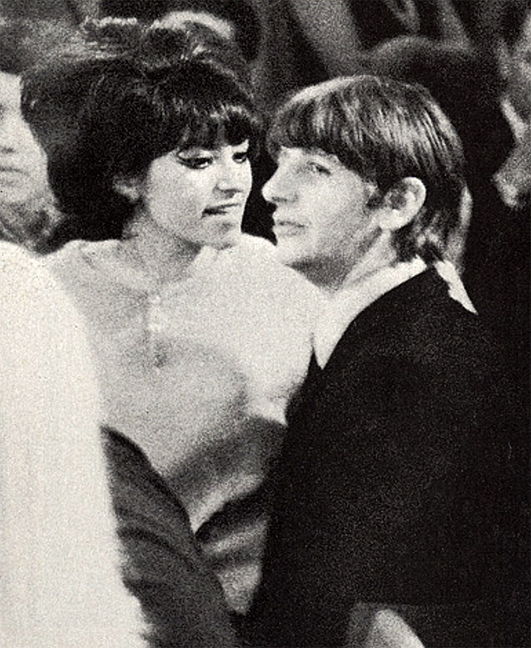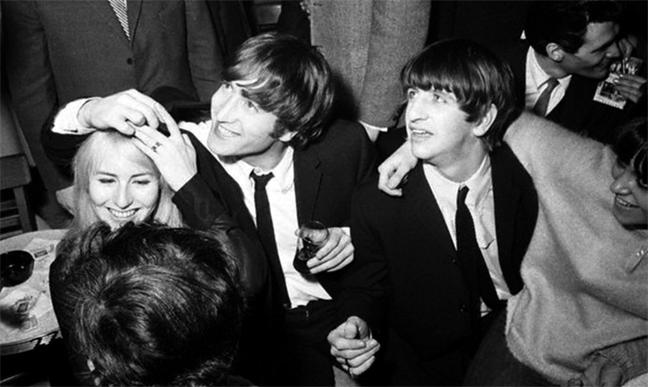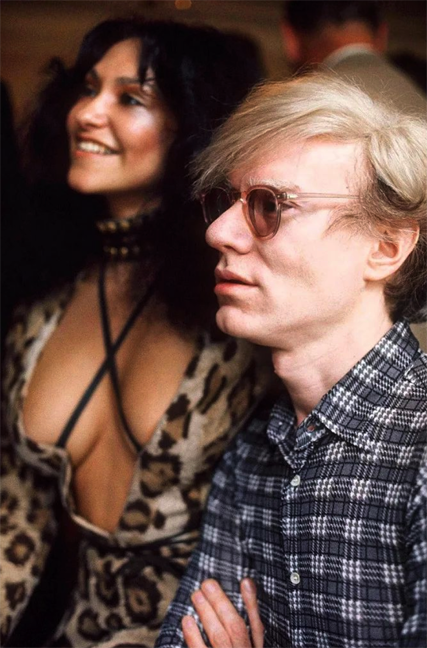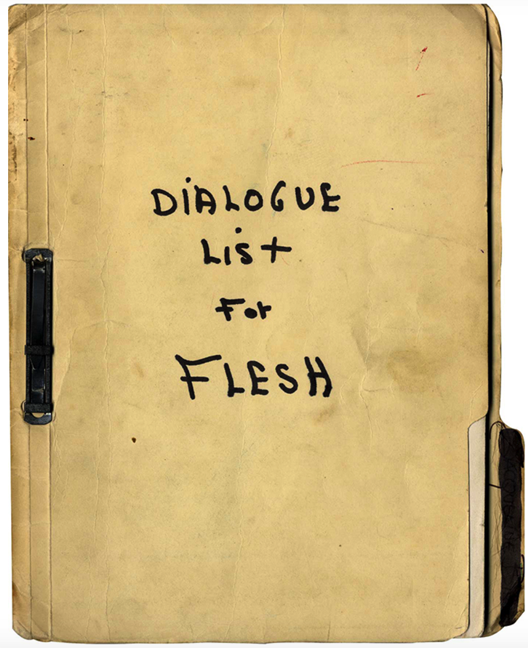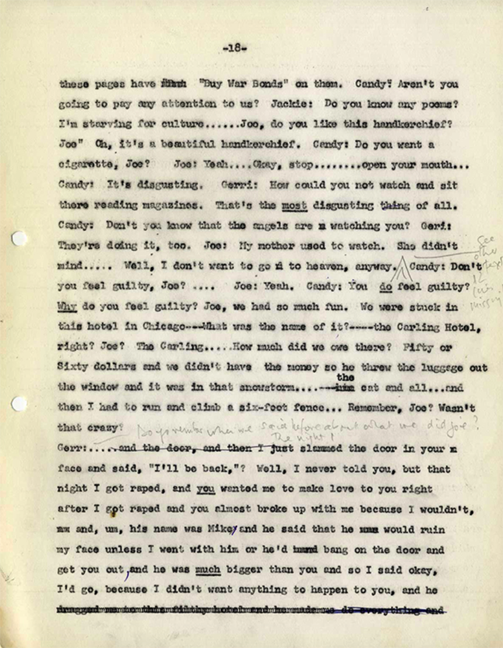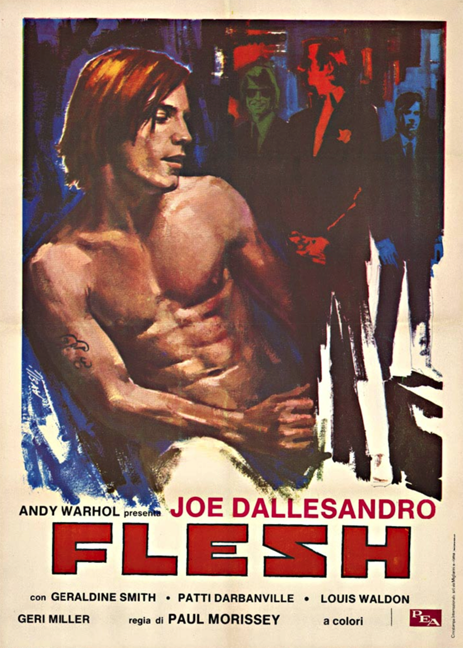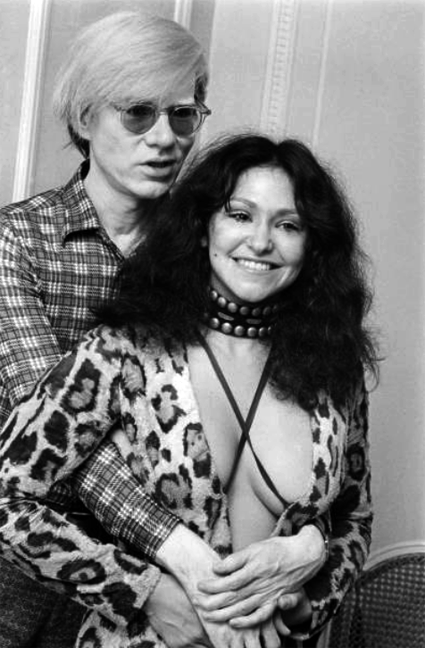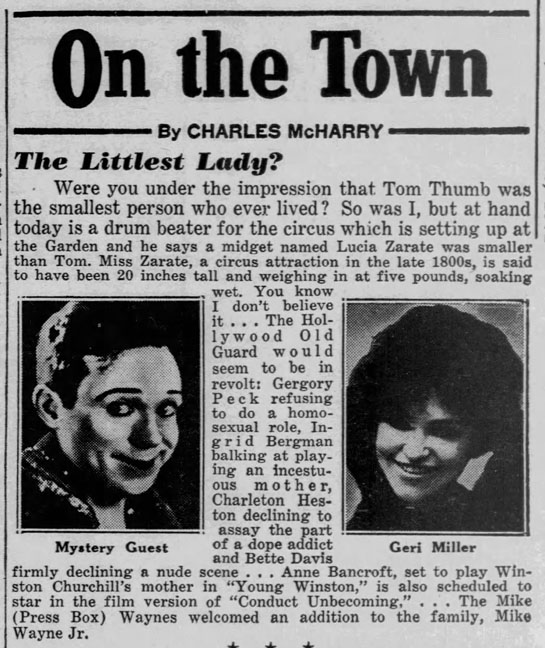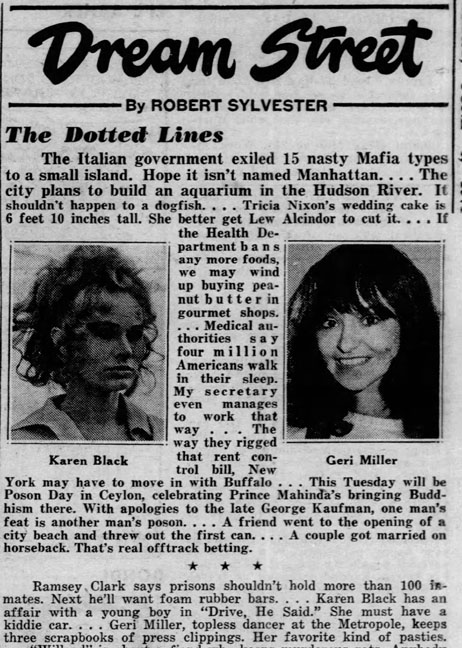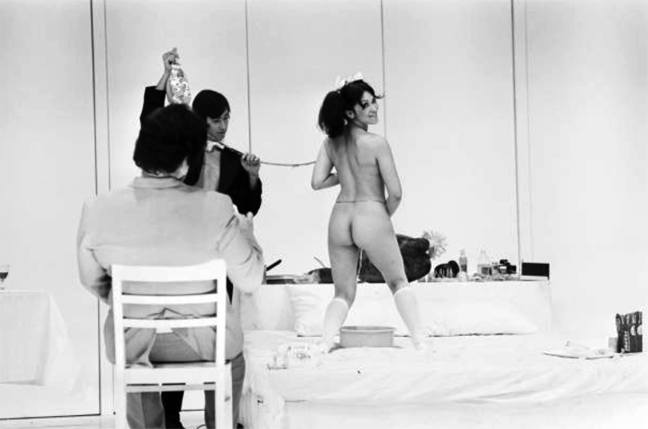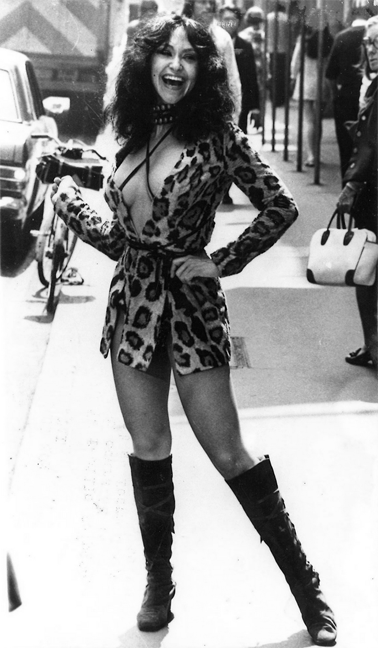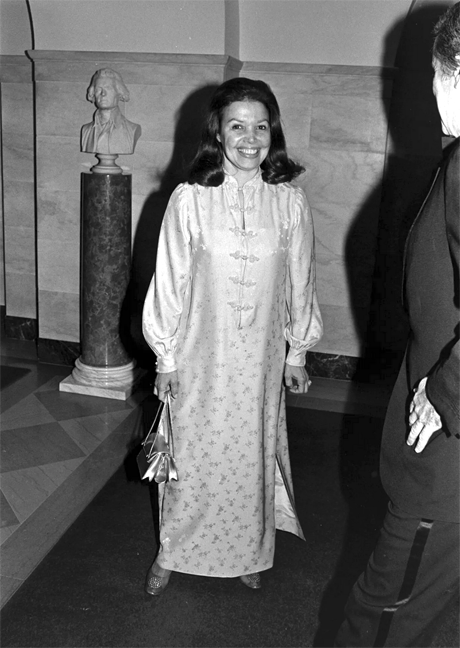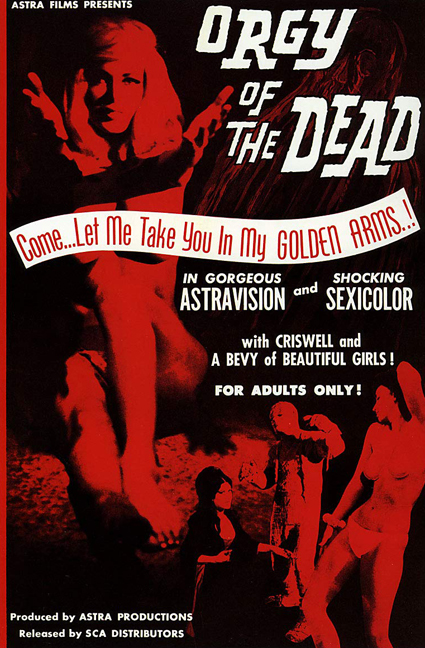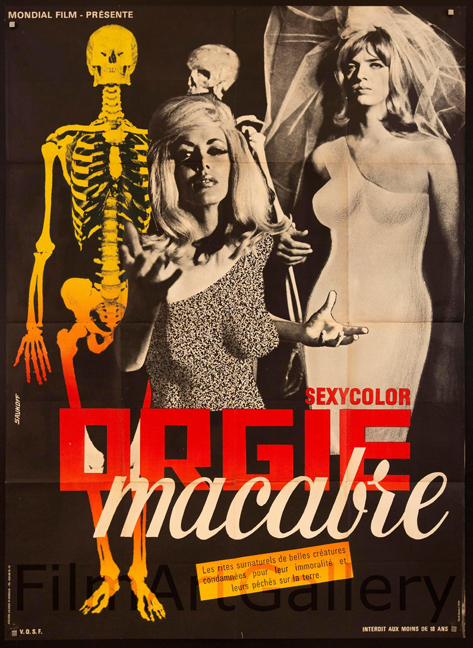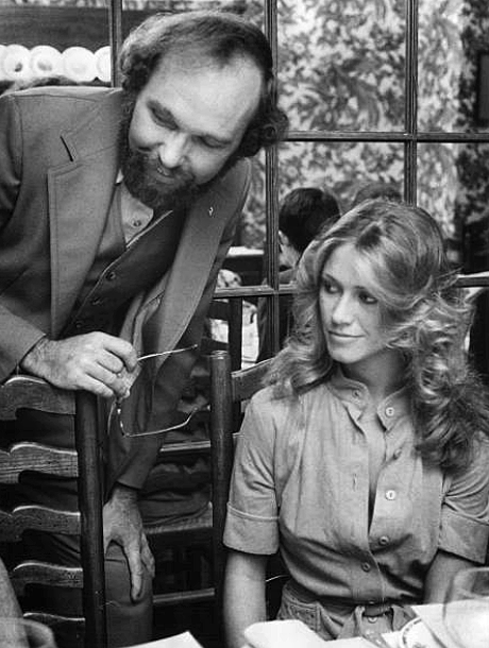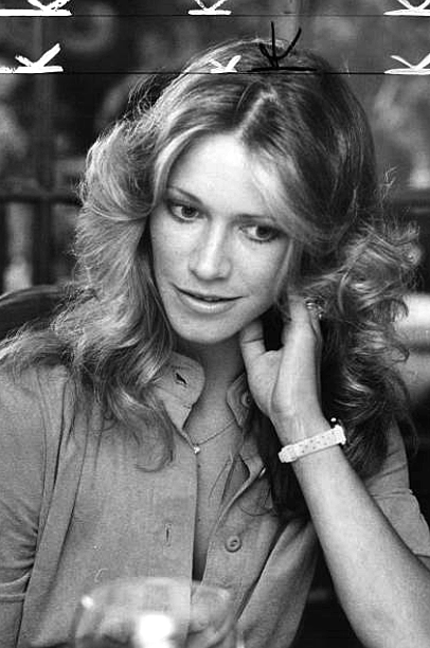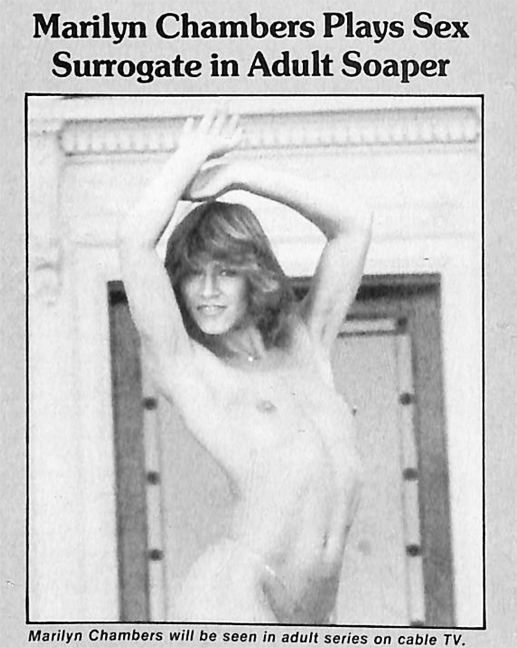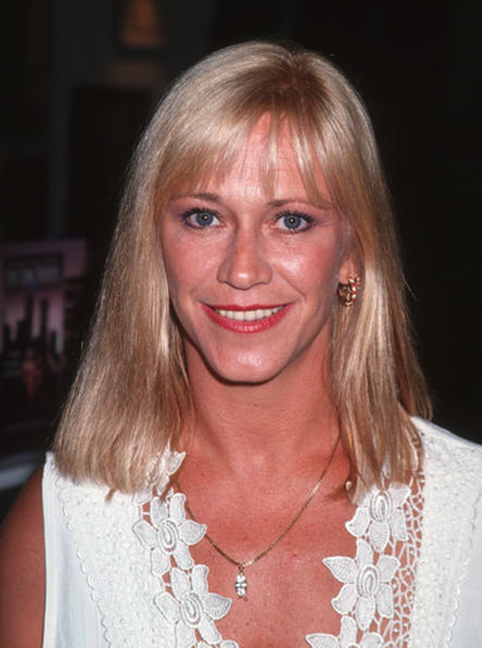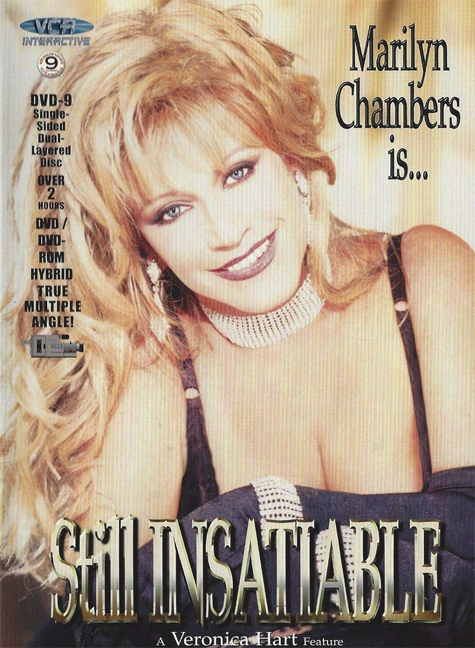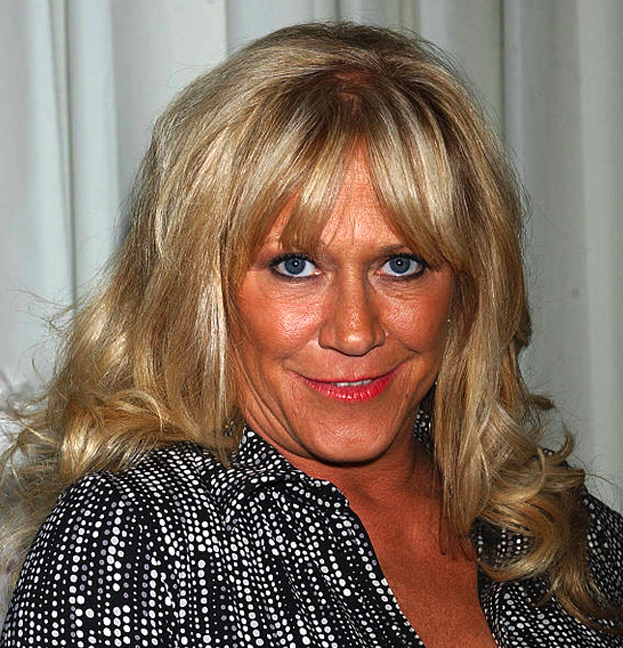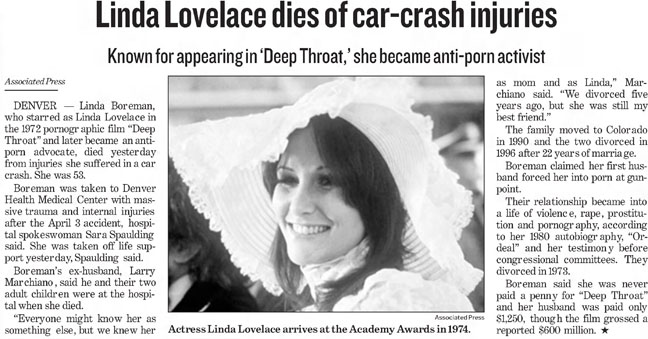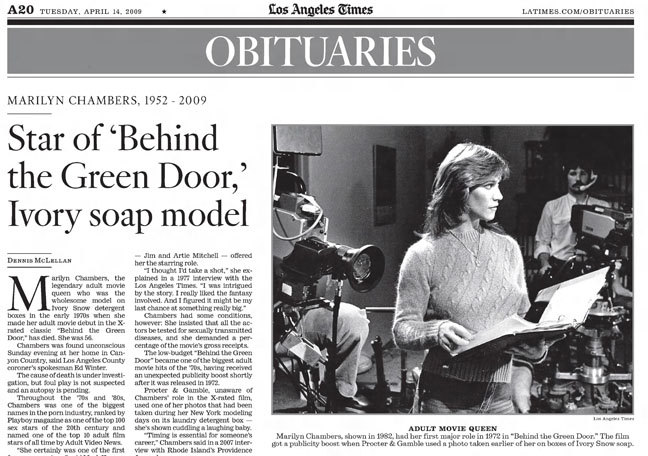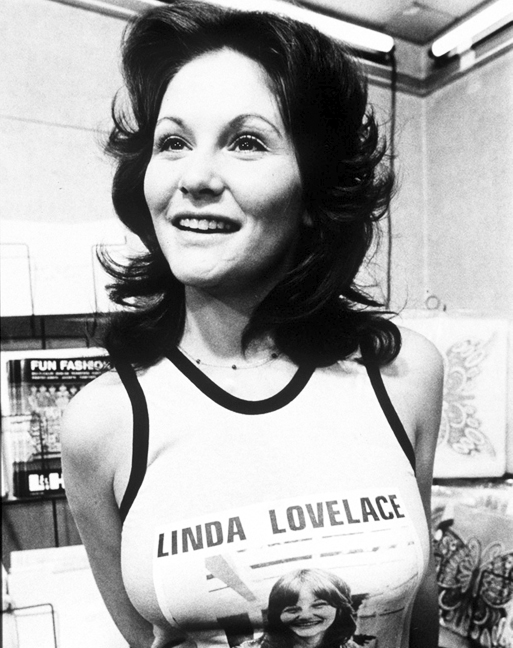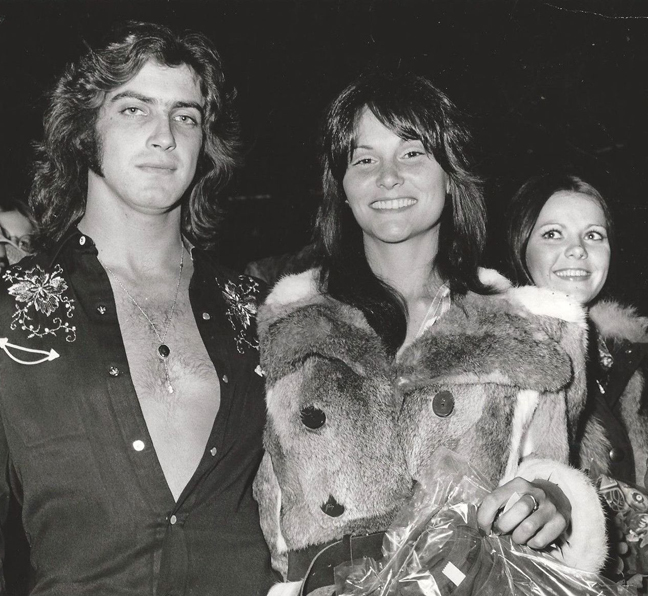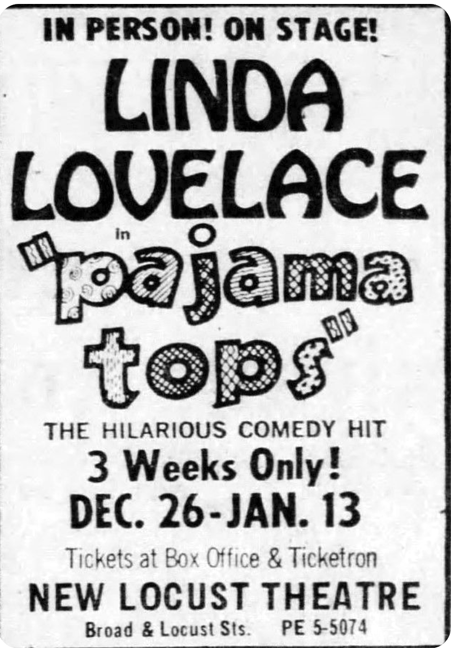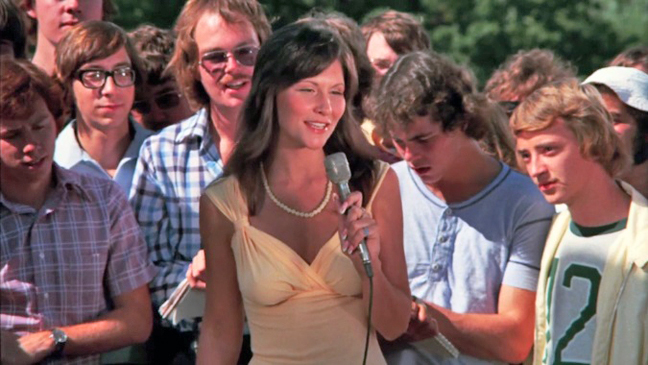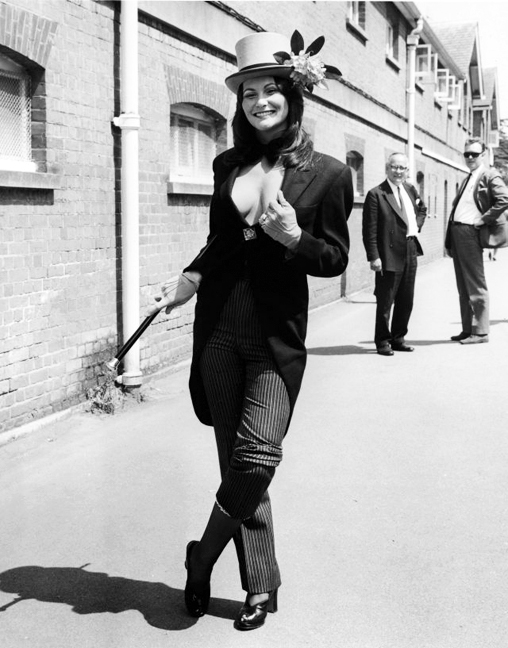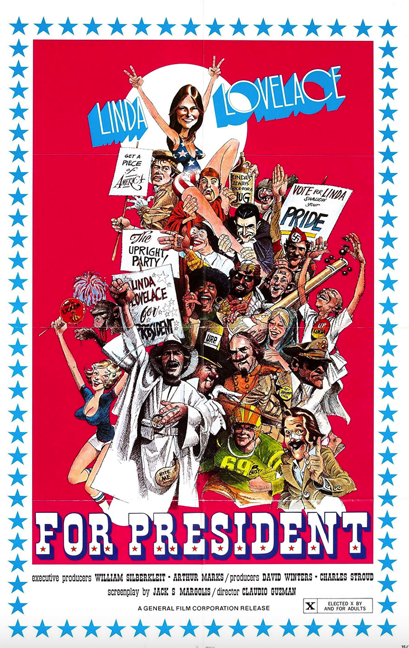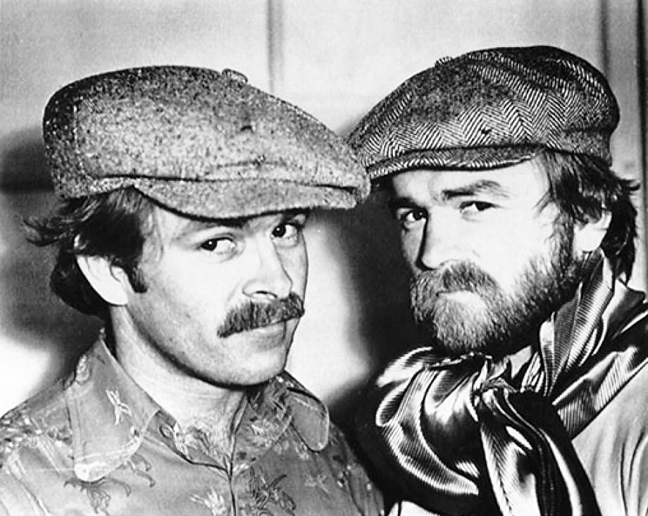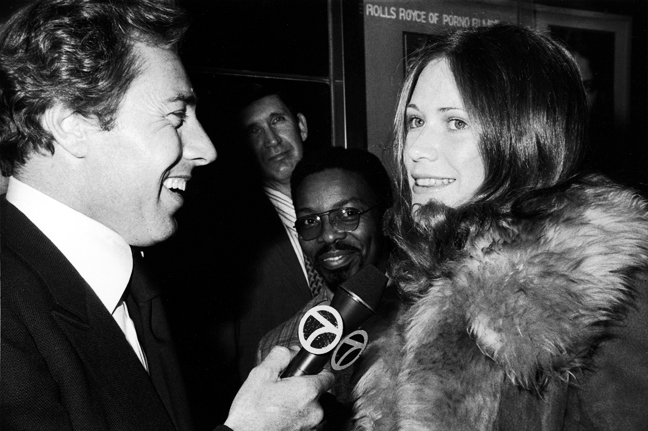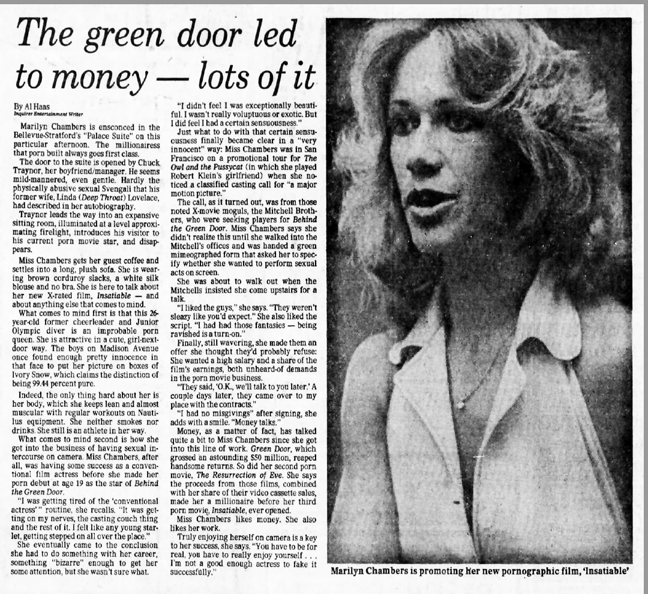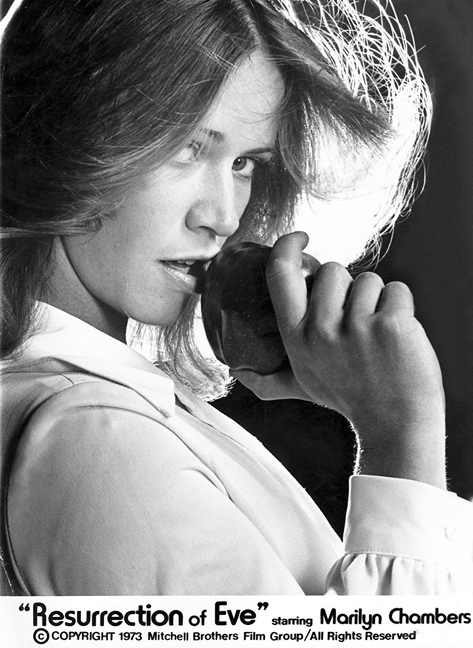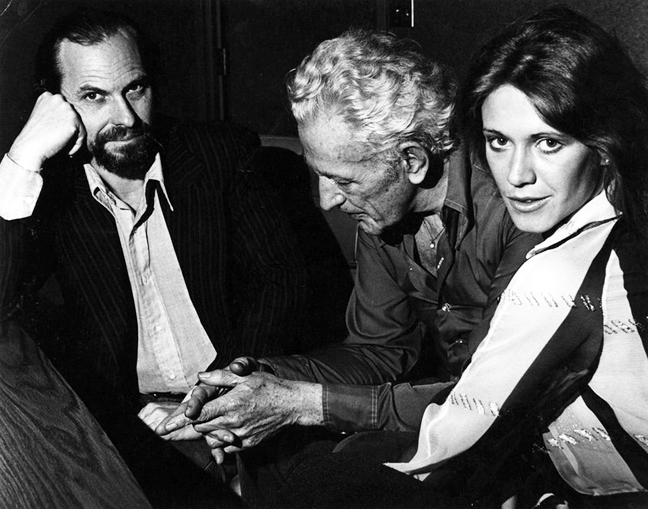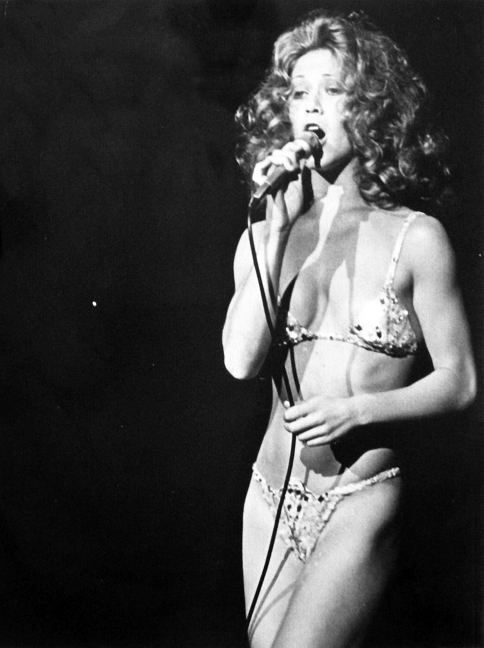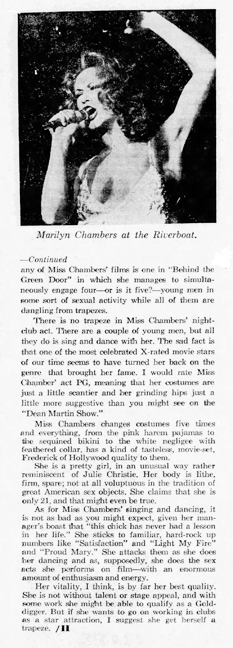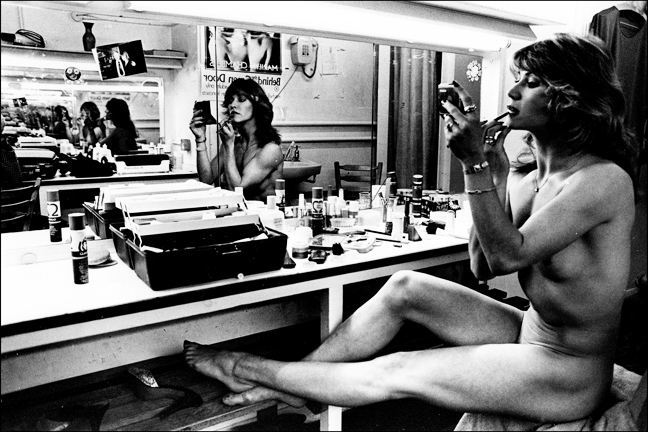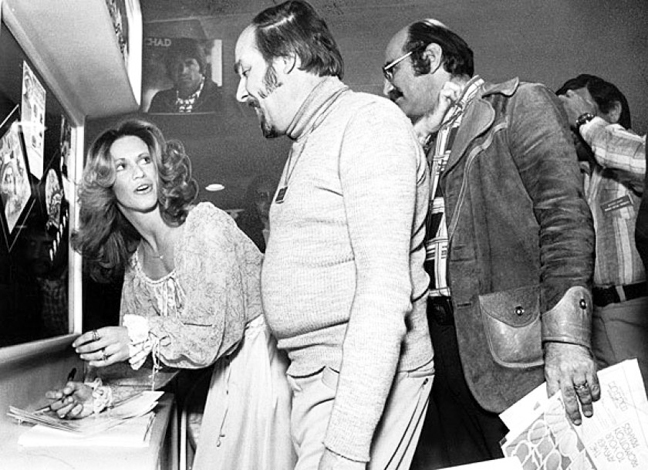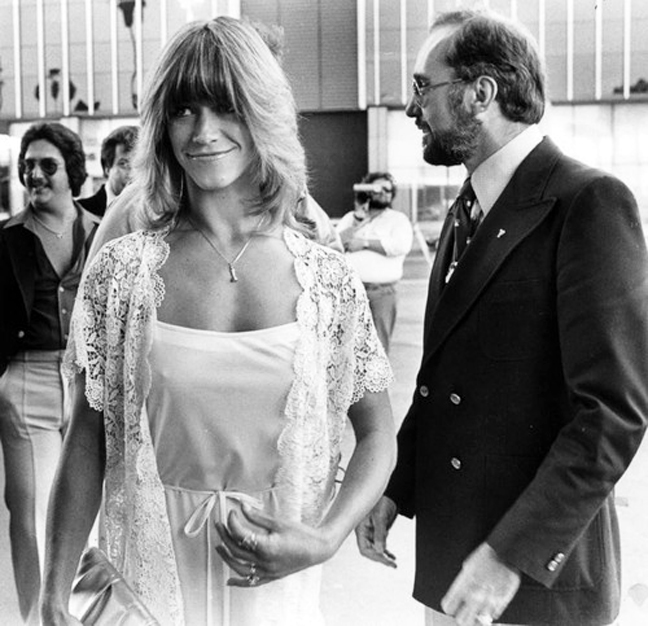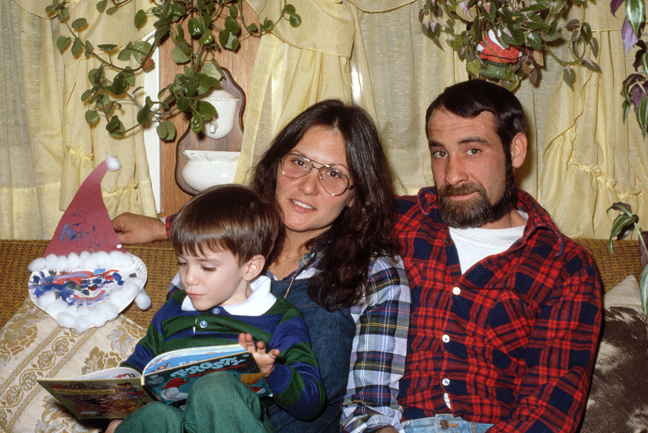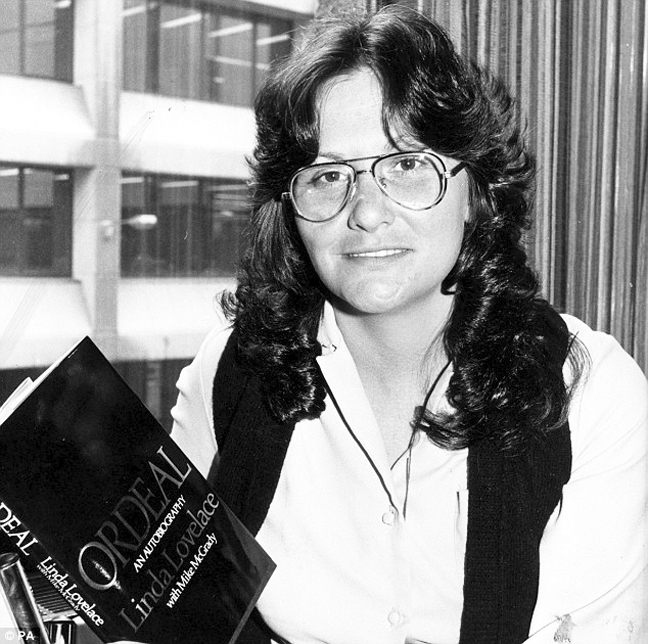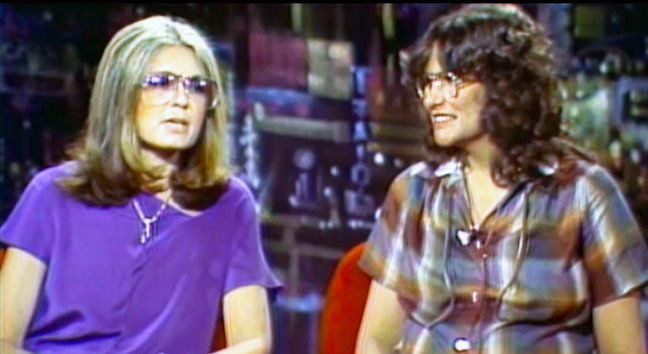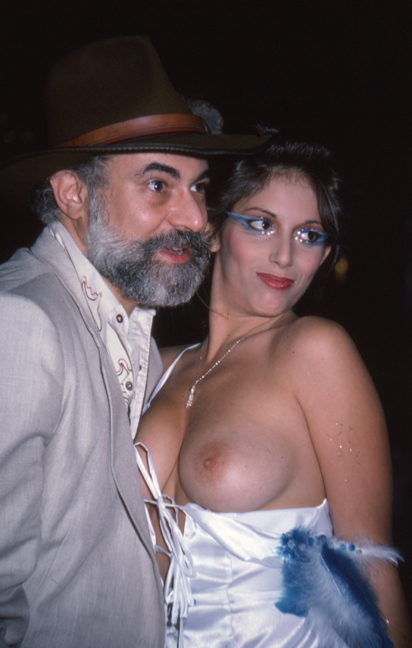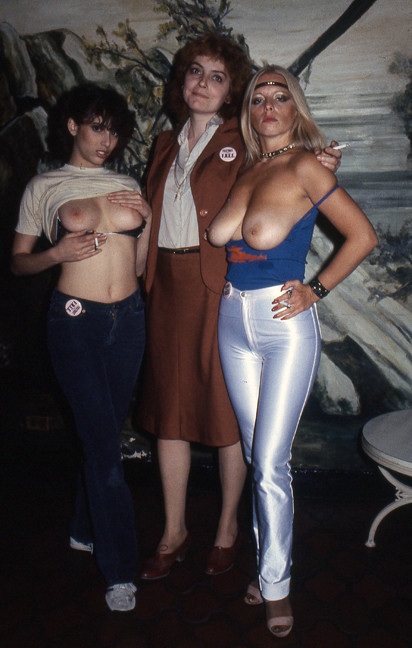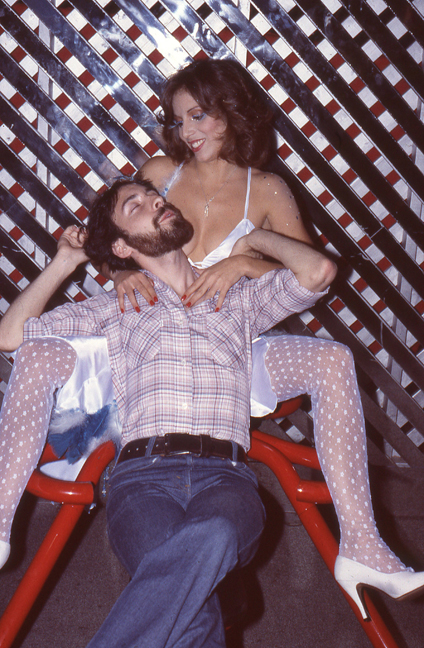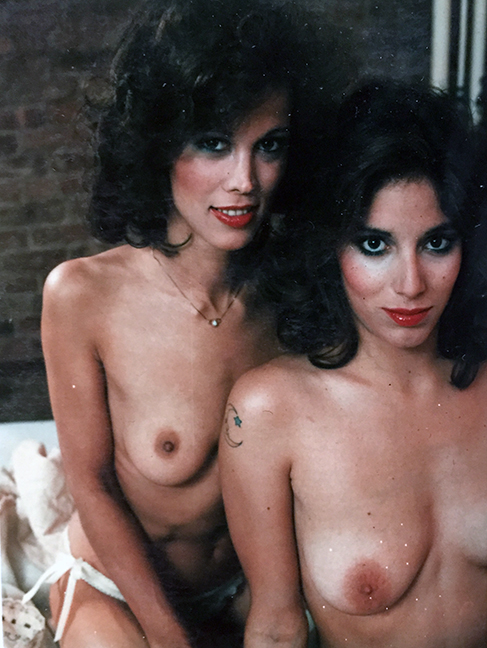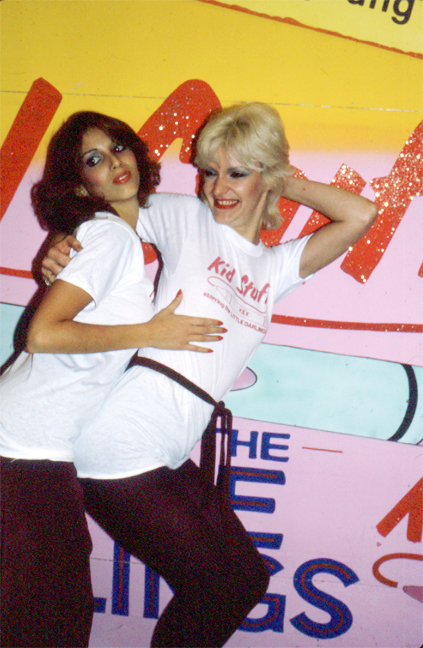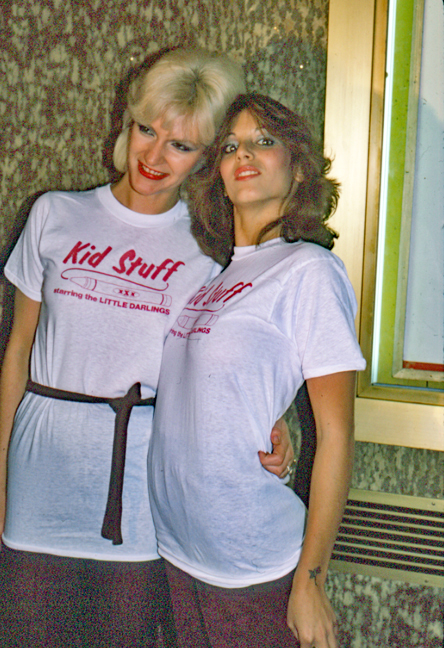- Publisher |
- Ashley West
- Media Type |
- audio
- Podknife tags |
- Interview,
- Movies,
- Pornography,
- Sexuality,
- TV & Film
- Categories Via RSS |
- Arts,
- Performing Arts,
- TV & Film
- People |
- Related Hashtags |
- #oldpornstarssmiling
- Frequency |
- Periodic
- Explicit |
- Yes
This podcast currently has no reviews.
Submit ReviewGeri Miller may not be the most famous name from 1960s sex films, but she may well be the most interesting.
With a story that includes Andy Warhol, David Bowie, Iggy Pop, Joe Sarno, the Peppermint Lounge, Ringo Starr, Joe Dalessandro, Mick Jagger, James Brown, Jimi Hendrix, the Young Rascals, and stripping in front of the Queen Mother’s house, Geri lived a technicolor life in a psychedelic era.
The Rialto Report went to visit her.
This episode running time is 43 minutes.
—————————————————
Manhattan, 2024. It’s three o’clock on a damp afternoon on the Upper West Side, and, from down the block, I see Geri Miller holding court for anyone who will listen.
She’s in an electric wheelchair, the result of a fall a year ago, but otherwise looks well for her 81 years, even if at times her mental state is prone to wander precariously toward the outer limits of rationality.
I sidle quietly into her small group, which today consists of an African street seller of knock-off earphones, two sullen college kids collecting money for autism, and a barely-dressed homeless woman from Lithuania.
Today Geri is warning her audience of the dangers posed by transsexuals. It’s based on personal experience, stemming from memories of the late Candy Darling, actress and one-time muse of both Andy Warhol and the Velvet Underground: “I knew Candy and his name was James, not Candy. Bet you didn’t know that, huh? I warned everyone back then. But did they listen? And now look what’s happening across the country.”
Her audience react to her triumphalism with a skepticism bordering on apathy, clearly ruing having selected to occupy that portion of sidewalk that day. Geri interrupts her flow when she sees me approach.
“Here’s someone who knows all about me,” she shouts triumphantly, pointing at me. “He knows the truth, and he’s here today to tell you all about it.”
*
It’s true. I’ve been fascinated with the life and times of Geri Miller for years. My interest started with her involvement in softcore sex films of the 1960s, though in truth, she wasn’t their biggest star: in fact, in sex movie history, she’s a minor footnote to other footnotes in a long-forgotten world. Yet paradoxically, it’s also true that Geri was possibly the most famous – and interesting – person who ever starred in sexploitation films.
She was a New York ‘It girl’ of her day, a B-level Edie Sedgwick, a precursor to Paris Hilton, a prototype Anna Nicole Smith, and a Gina Gershon-lookalike sexpot. She was glamorous, promiscuous, and ubiquitous, but above all, she was famous for being famous. Which usually means: famous for doing nothing in particular.
Except that Geri actually did stuff.
She was part of Andy Warhol’s Factory crowd, immortalized in his Polaroid art and appearing in his only play, the taboo-bending Pork (1971).
She was a self-described ‘Super Groupie’ – linked with members of the Beatles, and stars like Jimi Hendrix, David Bowie and James Brown. Her name was a staple in the syndicated newspaper gossip columns of the 1960s, which eagerly reported on who she was bedding that week.
She was frequently recognized on the streets, in diners, museums, and hotels, and hers was one of the first names added to any exclusive New York party list. (“Is Geri Miller coming to my birthday bash?” Mick Jagger once rhetorically queried, before rhetorically answering, “Would it really be a party without her?”)
She was a movie star of sorts: from small-time roles in big time movies (Stanley Lumet’s Fail Safe (1965) alongside Walter Matthau and Henry Fonda) to bit parts in highly-regarded but highly invisible films (The Magic Garden of Stanley Sweetheart (1970) – Don Johnson’s gender-bending counter-cultural debut). She had starring turns in fleshy, trashy Warhol-conceived films, like Flesh (1968) and Trash (1970). And she was in fourteen sex films by the likes of luminaries (Joe Sarno) and ordinaries (Joel M. Reed and assorted anonymous one-film blunders.)
From the first time I saw her, furiously dancing the twist in a Maysles brothers’ documentary about the Beatles, I was hooked.
I wanted to know more.
1968-Flesh-0016.png">1968-Flesh-0016.png" alt="Joe Dallesandro" width="648" height="489">Geri and Joe Dallessandro in ‘Flesh’ (1968)
*
I pry Geri away from her congregation suggesting we go grocery shopping. She eventually agrees, expertly operating the controls of her motorized wheelchair like a fighter pilot in an F-15 cockpit. She speeds down the block, starting conversation fragments with passersby and completely ignoring red traffic lights when she crosses the busy avenues (“don’t worry, the cars always stop when they see a wheelchair.”) Today she seems melancholic but grateful for the company: “I’m a star,” she says, “but no one believes it. I need you to prove it to people.”
I ask a question about the Peppermint Lounge, the legendary discotheque and celebrity hangout at 128 West 45th St where Geri was a regular house dancer. Is that where the Geri Miller story began – go-go dancing at the Peppermint in the 1960s? It wasn’t a good opener.
Peppermint-01.jpg">Peppermint-01.jpg" alt="Peppermint Lounge" width="648" height="410">
“It was not a go-go dancer!” she shrieks, bringing her chariot to an abrupt stop, glaring at me. “I was in the chorus line. I was a dancer. Trained in modern jazz dance because my parents were worried that I had knock knees! At the Peppermint, there were just four of us. There was Marlene, Misty, Janet, and me. And I was the only one who had formal dance training. We had two gay choreographers. Wake and Tom.” (A note for the curious: ‘Wake’ was Wakefield Poole. Yes – choreographer, dancer, and theatre director, but more notably, future director of Boys in the Sand (1971) and other groundbreaking gay porn films of the next decade.) The dancers developed a cult following in the club, formed a girl group, The Peppermints, for a hot moment, and cut a single, ‘We All Warned You’ for RSVP Recording Co.
Geri sets off again, grumbling – without any evidence – that she can’t talk and drive at the same time.
I ask her about the night of February 9, 1964, the occasion of the Beatles’ first Ed Sullivan appearance. The immediate aftermath of the Fab Four’s seismic performance was captured by Albert and David Maysles for a cinema verité documentary, ‘The Beatles: The First U.S. Visit,’ that covered the arrival of Beatlemania in the U.S. After the band dined at the Playboy Club, they made a pilgrimage to the Peppermint Lounge. The visit had mixed success: George left early with a sore throat, John and Paul looked cool relaxing at a table watching the house band, but for once, Ringo looked cooler, diving enthusiastically onto the dance floor, where he was joined by an equally energetic Geri.
Geri-and-Ringo-01.gif">Geri-and-Ringo-01.gif" alt="Geri Miller" width="325" height="241">Geri and Ringo, at the Peppermint Lounge
I ask Geri what she remembers about Ringo?
“Ugly and not very smart. That’s ok, I’m not smart either, but that’s why I like someone with a brain. All the girls wanted Paul, but I liked George. Too bad George left early is what I say. But I danced with Ringo, and then he asked me to join him at their table for the rest of the night. We had fun. Next day, I was all over the newspapers and magazines. I got calls, did interviews, the works.”
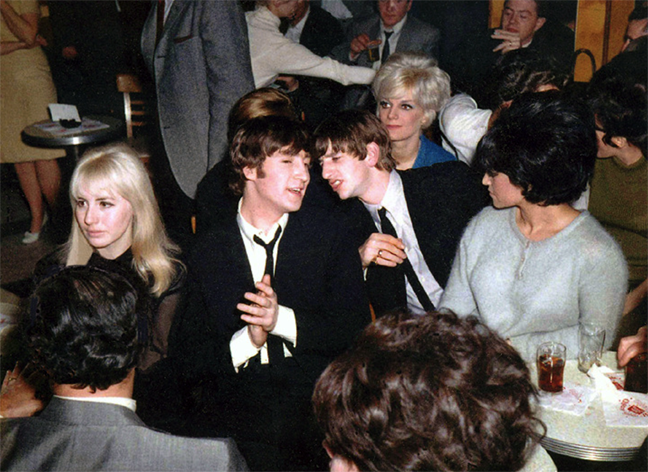 Cynthia & John Lennon, Ringo Starr, and Geri
Cynthia & John Lennon, Ringo Starr, and Geri
I read Geri an article published in Photoplay Magazine in 1964 entitled ‘7 Days & 7 Nights With the Beatles’: “(The Beatles) especially enjoyed the Lounge. ‘We got a chance to talk to the chaps in the band and the dancers in the show,’ said John. Paul added, ‘It was good to be out with real people for a change.’ It was Ringo, however, who made out the best. He met pretty twister Geri Miller. He managed to keep her a secret, but it was Geri whom Ringo took home.”
I ask Geri if that was true? That she took Ringo back to her apartment that night? I quickly regretted the indiscreet question, given that, by now, we were being served at the salad bar of the local deli.
“Of course I took him back to my place. He may have been ugly and dumb, but he was still a Beatle! I didn’t have sex with him though. I just sucked his dick. I learned to do that with men I didn’t like much. A mob guy taught me. If it’d been George, I’d have gone all the way. Or maybe Paul. But not Ringo.”
Geri, I say. Keep your voice down, we’re in public.
She cackles hysterically. “What do I care? I sucked off a Beatle. Dick, dick, dick, dick, dick, dick!”
*
Geraldine Miller was born in April 1942. Her birth certificate records her parents as Mr. and Mrs. Morris Miller of Clifton, New Jersey, though Geri isn’t so sure. She says she doesn’t remember much about them, expressing indifference bordering on angry contempt when I ask for details. She spins vague yarns about Morris having been connected to the British royal family and emigrating to the States from England where he’d been a Charlie Chaplin impersonator. She points to her dark complexion as evidence that she is perhaps of mixed race. To listen to her theories about her parentage is bewildering, but it’s clear that the identity of her father is an anguished, recurring question that still exercises her.
Geri attended Clifton High School, graduating in 1960 (“I wasn’t popular: the girls were jealous of me because the boys wanted me, and the boys were intimidated by me”), and then she started a business and secretarial course at the local campus of a private school, Berkeley College. An only child, she was stifled and bored in Jersey. Worse, she felt unseen and ignored, and longed to perform under the bright lights of the big city. She frequently hopped the train and turned up in Manhattan where she put together a portfolio and auditioned for anything where she could be seen. Modeling, dance, theater, film work. Sometimes her efforts paid off: she got work as a ‘Seventeen’ model, and was chosen as ‘Miss Star of Tomorrow’ at Palisades Amusement Park from a group of over 500 girls.
In 1961, management at the Peppermint Lounge offered her a job as a dancer – correction, as a chorus line girl. She accepted on the spot, and kissed goodbye forever to New Jersey, Berkeley College, not to mention her disputed parents.
The timing of Geri’s arrival at the Peppermint was serendipitous: when she started work there, it was an unexceptional gay club, tucked away in a non-descript corner of Times Square. Relatively small (when full, the room catered to a capacity of 178 people), its primary purpose was to launder mob profits under the watchful eye of Genovese capo, Matty ‘The Horse’ Ianiello. (Sidenote: according to Geri’s personal experience, Matty’s nom-de-mob could not have been the result of his male endowment.)
Pepppermint-Lounge-01.jpg">Pepppermint-Lounge-01.jpg" alt="Peppermint Lounge" width="648" height="418">
And then, in a quirk of showbiz fate, The Peppermint exploded: the nationwide Twist craze hit, and the club’s house band, Joey Dee and the Starliters, released ‘Peppermint Twist.’ It spent three weeks at No. 1 in January 1962 which brought the club wide recognition, reinforced later in the year when Sam Cooke referred to it in his hit ‘Twistin’ the Night Away’ (“a place, somewhere up New York way, where the people are so gay”.) Overnight, celebrities swarmed into the club – real A-list celebrities too: Jackie O, Audrey Hepburn, Truman Capote, Marilyn Monroe, Judy Garland, Liberace, Noël Coward, Frank Sinatra, Norman Mailer, even the elusive Greta Garbo – all turning up to dance to Joey Dee’s hot twistin’ band.
In the blink of any eye, Geri was at the epicenter of New York night life, and she was as happy as a tornado in a trailer park. She was featured in gossip columns (“a 5’2”, 110-pound firecracker”) and offered modeling work. When film director Sidney Lumet went to the club, he approached her and offered her a blink-and-you’ll-miss-it part in his claustrophobic brink-of-doom, cold war drama, ‘Fail Safe.’ The Peppermint wasn’t just a magnet for glitterati: music bands were keen to play on its intimate stage, and soon the Beach Boys, the Four Seasons, the Isley Brothers, the Ronettes, the Crystals, even Liza Minnelli all played there.
1964-Fail-Safe-0005.png">1964-Fail-Safe-0005.png" alt="Fail Safe" width="648" height="365">Geri’s first screen appearance, dancing in Sidney Lumet’s ‘Fail Safe’ (1964)
One night in late 1962, James Brown stopped by and took a shine to Geri. He invited her to his show at the Apollo the following week where he was appearing with his band, the Famous Flames. It proved to be a landmark event: the show was recorded, and the resulting live album, ‘James Brown: Live at the Apollo’ (1963) became one of the biggest commercial and critical hits in recording history. Geri remembers the night well: “It was wild and loud in the theater. I’d never seen anything like it. And I was the only white girl there. I didn’t care. James showed me around, and I danced all night.”
James-Brown-01.jpg">James-Brown-01.jpg" alt="James Brown" width="648" height="648">
James Brown and Geri started an on/off relationship which continued for years whenever he was in town: “I heard stories that he beat women, which was probably because his mother left him when he was small, but I never saw any of that. He was always good to me.” It was, however, a contentious liaison on both sides. Brown, who Geri remembers having a predilection for large-breasted girls, was often critical of his fellow black musicians when they consorted with white women, so he kept Geri hidden in hotel rooms. For her part, Geri knew that that the management at the Peppermint Lounge also frowned on interracial relationships because the goombahs feared negative publicity and… well, because they were just racist too. Geri remembers enduring low-level harassment at the club as a result.
When James Brown wasn’t around, she started dating Dino Danelli, drummer in a struggling rock group, The Young Rascals: “He had the blackest hair and the bluest eyes you’ve ever seen. Like if Paul McCartney came from Jersey.” Dino liked big-breasted girls too, but he said he’d make an exception for Geri. He moved into her apartment at 310 West 47th St – her Peppermint Lounge tips were more than his gig money after all. But then his band started having success, with number one hits like “Good Lovin'” (1966), “Groovin'” (1967), and “People Got to Be Free” (1968), and the Young Rascals became young rascals. Groupies started showing up, and Dino found it difficult to resist them: “He was the first guy to break my heart. I was so sad. We split, and he moved out and into his own place.” Today Geri still recites his 1964 phone number, still fresh in her mind.
Young-Rascals-01.jpg">Young-Rascals-01.jpg" alt="Young Rascals" width="648" height="648">The Young Rascals, with Dino Danelli, front right
Then James Brown asked her to marry him. Geri turned him down: “I said no, even though I loved him. The reason was that I was ashamed of my drug habit – which he knew nothing about. I was taking uppers all the time because I needed to keep up with… life. I was sad to turn him down, but I didn’t want him to find out.” Brown sent her a telegram, care of the Peppermint. It was intercepted by one of the managers who’d warned her against seeing Brown. Geri was dismissed the same day.
As for the Peppermint Lounge, it didn’t last much longer, closing down when it lost its liquor license on December 28, 1965.
*
Geri’s electric wheelchair sets off on the ten-block trip back to her apartment. She’s warming to the conversation, though she’s easily distracted by the street vendors. She crashes into a hat seller, and suggests I buy a fedora: “You need a hip new look,” is her sales pitch to me. I deflect, and ask about what she learned from her time at the Peppermint.
It turns out the Peppermint Lounge was formative in defining who Geri would be: She’d seen big stars first hand at the club – and slept with her fair share – and envied the money, adulation, and glamor. Now she wanted in. She wanted to be famous. For Geri, celebrity meant visibility, just as visibility meant celebrity. And visibility was what she craved after a life of anonymity. What she would be famous for was irrelevant: there was no need to create a brand in order to become a celebrity. Celebrity itself would be her brand.
So perhaps it was no surprise that Geri’s path would cross with that of Andy Warhol, crown prince of modern celebrity culture. He’d stopped by the Peppermint Lounge a few times to see what all the fuss was about, and whispered a question in her ear that resonated: how can something truly exist if no one is looking at it? Geri wanted to be seen, and so she and Andy formed a mutual appreciation group. Andy suggested she come to The Factory, his studio salon at 231 East 47th Street, creative home to various artists, musicians, and assorted eccentrics. Geri fit in perfectly and became part of the scene: she was a minor Warhol superstar perhaps, but a key component of the clique of idiosyncratic personalities promoted by Andy nonetheless.
Geri-Miller-04.jpg">Geri-Miller-04.jpg" alt="Andy Warhol" width="517" height="648">
Shoes-01.jpg">Shoes-01.jpg" alt="Andy Warhol" width="496" height="648">Polaroids of Geri by Andy Warhol
In the meantime, Geri found work at the Metropole, the once-respected bebop jazz club which added strippers to its menu in the mid-1960s when patrons tired of its progressive music. This time, Geri admits, she wasn’t a chorus girl: she became a stripper. “I didn’t like it at first. I hated being topless, and so I took more uppers just to give me courage. It was difficult for me. I became promiscuous too. Oh boy, was I promiscuous. Especially when I did uppers. Everyone was just so glamorous.”
Metropole-Cafe-1967-01.png">Metropole-Cafe-1967-01.png" alt="Metropole" width="648" height="429">The Metropole (and three underwhelmed customers)
Conscious of James Brown’s and Dino Daneli’s preference for large breasted women, Geri paid for silicone injections: “I didn’t get implants. That’s when they put something in your chest. I just had injections. It wasn’t a big deal.” It didn’t stop the New York Daily News later describing her as “the lady with five pounds of silicone in each breast.”
For publicity, she targeted Earl Wilson, celebrity gossip journalist, respected and widely read. His column titled ‘It Happened Last Night’ ran in 175 newspapers nationwide. Wilson wrote about Geri for the first time in September 1966: she was a contestant for the prestigious ‘Miss Night Beat’ title and she’d heard that Wilson was one of the judges. So Geri dressed up in a daring outfit and turned up uninvited at his office, handing him pictures of herself in the buff. Wilson was tickled and charmed by her flirtatious chutzpah: whoever was awarded the ‘Miss Night Beat’ title is lost to irrelevant history, but Geri was the moral winner when Wilson described her racy visit to his estimated eighty million readers.
Flasher-Geri-Miller-02.jpg">Flasher-Geri-Miller-02.jpg" alt="Geri Miller" width="648" height="443">
Andy Warhol approved of the risque’ publicity, and in 1968, he offered Geri a part in Flesh (aka ‘Andy Warhol’s Flesh’), the first of a trilogy of movies that would include Trash (1970) and Heat (1972). Directed by Paul Morrissey, it starred Joe Dallesandro as a bisexual street hustler who does tricks so that he can pay for his wife’s lover’s abortion. Geri played the part of… a topless dancer, appearing in a scene with fellow Warhol superstars Candy Darling and Jackie Curtis. She is strangely charismatic and compelling, giving Dallesandro head (shot from behind Dallesandro’s fully clothed standing body) and then delivering a lengthy story about being raped. Her monologue feels natural and improvised, even if the script reveals that she was closely following the dialogue written by Morrisey. In a memorable moment, Geri’s character admits she isn’t the smartest but is fine with that: “If I learn too much, I won’t always be happy. The more you learn, the more depressed you’ll be.” Today Geri insists: “That was my line! Andy overheard me say that, and so they added it to the script.”
‘Flesh’ falls somewhere between Factory home movie and early pornography. Predictably, it proved controversial, and was confiscated by New York police during early screenings at Warhol’s Garrick Theater. All publicity gravy to Andy and Geri.
1968-Flesh-0036.png">1968-Flesh-0036.png" alt="Geri Miller" width="648" height="489">Geri and Joe Dallessandro, in ‘Trash’ (1968)
Today, Geri’s memories of the film are less rosy. In fact, they’re overshadowed by the money she received. Or rather, the money she didn’t receive: “Andy only gave me $250 for that movie. Can you believe it? He ripped me off. He robbed me blind. And do you know how much money that film made? Millions probably. I was one of the stars. I get nothing today, and that film is still making money.” It’s a Hollywood grievance as old as the hills, but that doesn’t make it any easier for someone who’s fallen on hard times. Geri claims she pursued Warhol in later years, demanding an additional cut of the profits, but he wouldn’t even meet her.
“At least, I had sex with Joe D,” she says ruefully. “We took it home after the shoot. We had chemistry. Big time. You can see it in ‘Flesh’. Look at us kissing. That was art, and that was real.”
Geri throws back her head and laughs again.
*
And then came the sex films.
Admittedly they were softcore – black and white, pretty women/old men, bras cast off/panties kept on, giant Y-fronts and socks pulled up the knees – but still scandalous for the day. I ask Geri if she had any reservations making the racy films. The question feels naïvely ill-judged the moment I ask it. As if I hadn’t been paying attention. “Why would I care?” she replies. “I was a star, it was money, and it was easy work. I was a celebrity and I was good on screen.”
Geri’s right. There’s no such thing as bad publicity, and she’s always irresistibly watchable. She started in 1968 with a handful of bit parts: a pair of Joe Sarno moody melodramas, one of them called The Wall of Flesh in which she’s a hesitant participant in a group therapy orgy. Then there was Sex by Advertisement where she is raped and blackmailed in a lengthy scene (while trying, and failing, to keep a straight face.)
1968-Wall-of-Flesh-0008.png">1968-Wall-of-Flesh-0008.png" alt="Joe Sarno" width="648" height="535">Geri in Wall of Flesh’ (1968), with (l-r) Janet Banzet, Irene DeBari, Cherie Winters
1968-Sex-By-Advertisement-0009.png">1968-Sex-By-Advertisement-0009.png" alt="Geri Miller" width="648" height="503">Geri in ‘Sex by Advertisement’ (1968)
In 1969, there were three more films: Meeting on 69th Street where, dressed in a mini-skirt and white go-go boots, she seduces her girlfriend’s man – at the same time that her girlfriend is schtupping him, no less. In Monique, My Love, she performs her Metropole stripping routine before playing with a coke bottle. And in Fly Now, Pay Later she’s a Moroccan courtesan seducing 1960s skin flick regular, Alex Mann.
1969-Meeting-on-69th-St-0013.png">1969-Meeting-on-69th-St-0013.png" alt="Geri Miller" width="648" height="504">Geri in ‘Meeting on 69th Street’ (1969)
1969-Monique-My-Love-0031.png">1969-Monique-My-Love-0031.png" alt="Geri Miller" width="648" height="502">Geri in ‘Monique, My Love’ (1969)
1969-Fly-Now-Pay-Later-0002.png">1969-Fly-Now-Pay-Later-0002.png" alt="Geri Miller" width="648" height="491">Geri in ‘Fly Now, Pay Later’ (1969)
I ask Geri about each one in turn but the memories have long departed. She never saw any of them she says, and has no recollections to share. She expresses surprise and delight at the movie scenarios that I describe for her but shrugs. Filming each one took less than an afternoon, she insists, and they were shot almost sixty years ago: “How in the fuck should I fucking remember them?” she reasons in an unreasonable way. “To be honest I doubt it is actually me on the screen. They do that, you know? They put your face on someone else’s body. That happens a lot. I never made all those films. That’s a lot of movies. No way I was in them all.”
There is one film that angers her, however. A while back, she saw her IMDb filmography and one item stood out: Daughters of Lesbos (1968), a movie in which she had starred as a dominatrix, ‘Dominique.’ “Impossible!” she shouts. “I never made that film!”
How do you know, I ask? After all, you don’t remember any of the others, so why is this one different?
“Because I’m not a lesbian!” she bellows in frustration. “I never did sex acts with another woman! So I was never in that film. It’s slanderous!”
She asks me to write to IMDb and have the film removed from their site. I try to reason with her: the films’ salacious names were often not matched by their content. Just because this particular title refers to ‘Lesbos’ doesn’t mean that Geri is engaged in sapphic fumbling. Geri is unconvinced.
I tell her I have copies of all her films on my laptop in case she has an interest in seeing any of them. She appears concerned to be confronted by the idea of seeing the evidence, before dismissing the idea: “Why would I want to see them anyway? Looking back at when I was young and beautiful isn’t going to do me any good.”
We’re standing outside a Chinese restaurant that has caught her eye. “This serves some of the best Chinese food in the city,” she says. “Why don’t we have some food?”
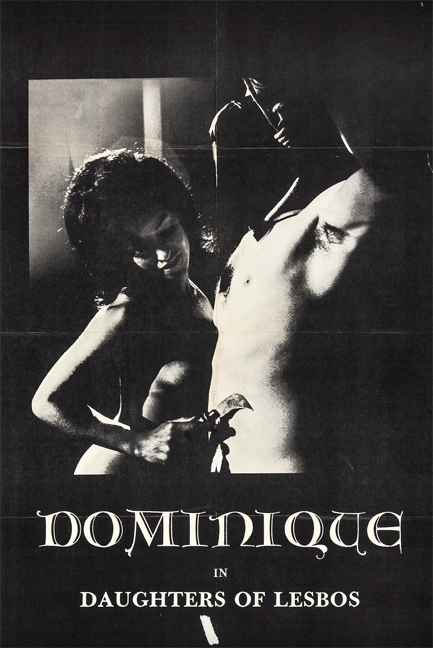 Geri on the one-sheet for ‘Daughters of Lesbos’ (1968)
Geri on the one-sheet for ‘Daughters of Lesbos’ (1968)
*
If the late 1960s had been a dress-rehearsal for Geri, the early 1970s were her coming-out party.
First she appeared in Trash (1970), the second in the Warhol/Morrissey trilogy. Once again, Dallesandro stars, portraying a day in the life of a heroin addict, this time overdosing in front of an upper-class couple, attempting to fool welfare by having his girlfriend fake a pregnancy, and frustrating women with his drug-induced impotence. And once again, Geri is a highlight: she’s in a lengthy scene, unsuccessfully trying to arouse the movie’s anti-hero by dancing and singing ‘Mama, Look At Me Now,’ a song that would become a trademark theme for her. Geri claims her pay was the same as the first Warhol/Morrissey film: a meager $250.
1970-Trash-0003.png">1970-Trash-0003.png" alt="Trash" width="648" height="483">Geri and Joe Dallessandro in ‘Trash’ (1970)
She did get better pay for appearing in other critically acclaimed films, such as The Magic Garden of Stanley Sweetheart (1970) about a New York gender-bending college dropout seeking his identity during the sexual revolution. It starred Don Johnson in his movie debut, and Warhol was so impressed with it, that he declared it represented “the quintessential, most truthful studio-made film about the ’60s counterculture”. Then Geri showed up in Pound (1970), Robert Downey Sr’s surreal, experimental film about eighteen dogs waiting to be adopted. And you can see her in a wild dance sequence in The Telephone Book (1971), where a victim of an obscene caller becomes obsessed with her fantasy of him. All small roles, but they generated enough stories to keep her name in the gossip columns for months. (In one newspaper article, she complained that she was profoundly ashamed of new naked photographs she’d had done – not because of the nudity but because she had an ugly hairdo.)
Geri was appearing all over town: she joined a cabaret show featuring fellow Warhol superstar, Eric Emerson, and his band the Magic Tramps, where she reprised ‘Mama, Look At Me Now’ from ‘Trash.’ She appeared on David Susskind’s investigative chat show where she was interviewed about life as a groupie. She upstaged the premiere of the Monty Python film, ‘And Now For Something Completely Different’ (1971), in a publicity stunt with a man in a gorilla costume. Tennessee Williams took her fishing. (Where does a playwright take a dancer fishing, I ask? “Fucking Brighton Beach, obviously!” is the answer.) And seriously, do you know anyone else who went on dates with David Cassidy and Jimi Hendrix?
Geri-Miller-01.jpg">Geri-Miller-01.jpg" alt="Geri Miller" width="648" height="428">
She was still part of Andy Warhol’s Factory crowd too. Warhol gave her a walk-on in the latest Paul Morrissey effort Women in Revolt (1971) that starred fellow superstars Candy Darling, Jackie Curtis, and Holly Woodlawn. More importantly, Geri scored a role in Pork, the first and only Warhol theater play. ‘Pork’ opened on May 5, 1971, at La MaMa Experimental Theatre in New York City for a two-week run. As usual, a Warhol-sponsored event caused a furore, and the New York Times’ review commented on the excess “fornication, masturbation, defecation and prevarication.”
Geri was asked to reprise her role when ‘Pork’ transferred to London, playing at the Roundhouse for a six-week run in August 1971. The Brits largely panned the play, though some critics insisted that its over the top obscenity wasn’t the problem but rather the point of the whole farrago. As one journalist wrote, “Pork’s redeeming essence is that it finds itself so ridiculous, that from start to finish, it demands not to be taken seriously. It’s Warhol people debunking themselves.”
Geri-Miller-Pork-01.png">Geri-Miller-Pork-01.png" alt="Geri Miller" width="567" height="648">Geri, in a publicity still for ‘Pork’
The U.K. production had some notable admirers: David Bowie went to see it several times and was impressed enough to hire several of the ‘Pork’ cast members to join his management firm, MainMan. Bowie even invited Geri to be his personal guest at his first New York show. (Sure enough, in October 1972, when Bowie made his New York debut at Carnegie Hall, Geri stormed the stage armed with gladioli to welcome him.) But probably the most press ink related to the play was spilled over a publicity stunt that Geri orchestrated: during a photo session in front of Clarence House, the Queen Mother’s residence, she exposed her breasts. Nudity in front of royalty? The local tabloids were outraged and joyfully lapped it up. Geri was arrested and threatened with deportation. Mission accomplished.
Back in New York, Geri was on a roll. In 1972, she jumped out of a cake at Mick Jagger’s birthday party at the St Regis (“the cake had three tiers, Geri was nude,” it was reported) before a guest list that included Count Basie, Muddy Waters, and Stevie Wonder.”Mick was good looking, but very average in bed,” is her volunteered report card.
Then she taunted Iggy Pop. Iggy and Geri had history: the previous year, Iggy had performed at Ungano’s in New York and grabbed Geri’s face, pulling her and her metal folding chair across the floor in a bizarre piece bit of stage theatre. The next time their paths crossed was at the Electric Circus where Iggy told the crowd they made him feel sick. “Let’s watch you puke then,” Geri shouted at him from the front row. Mr. Pop obliged – and threw up all over Geri.
Geri’s credits kept on coming: she was a featured attraction in The Flasher, a one-night Broadway show based on a porn film. She sang with glam-rock, satin-suited rock band Angel. Eric Burdon, formerly lead singer with the Animals, shipped her to Los Angeles to appear on his album. Each one of these events is a separate story of its own, but they’re just another day in Geri’s world.
Not that Geri ever stopped stripping. Her agent, the exotically-named Brooklyn Jew, Mambo Hi, made sure of that. Her list of ecdysiast employers reads like a history of 1970s burlesque in New York: she was still dancing topless at the Metropole on Seventh Ave., and in the afternoons, she found a gig at the M&M Lounge at 51 Little West 12th St (“a moribund area” said one newspaper.) It was a tiny club, with a 4×4 stage, catering to meat-packing workers. When she needed extra money, she danced at the Carnival at 146 West 45th St, former site of the Great Wall, a Chinese restaurant. From time to time, you could find her at Club 45, the Wagon Wheel, the Mardi Gras, the Rolling Stone, and the Coventry, on top of her occasional bar work at CBGB’s and Max’s Kansas City.
Flasher-Geri-Miller-03.jpg">Flasher-Geri-Miller-03.jpg" alt="Geri Miller" width="438" height="648">
Geri also gave birth to a daughter who she put up for adoption. In the years ahead, regretting her decision, she would try to track her daughter down, but without success. It remains a source of sadness and frustration.
*
Somewhere along the road, the threads of Geri’s life started to unravel like a cheap sweater. Warhol’s generation of superstars were being ravaged by overdoses, suicide, or indifference. Party invitations slowed to a trickle before disappearing completely. Chat shows and gossip columns looked away, seeking new provocateurs. Rock stars found a new generation of groupies to have sex with. And strip clubs turned to younger women, asking them to do more than just strip.
So Geri took a radical and subversive step: she found a full-time nine-to-five job with crisp white collar legal firm, Shearman & Sterling. It may have been less fun, but the paycheck was regular and healthcare was an added bonus. Geri claims she was put to work on interesting cases, including the last will and testament of Winthrop Rockefeller, son of John D. Rockefeller. The job didn’t last: you can take the girl out of the limelight, but you can’t take the limelight out of the girl. One day, she revealed her back story to a paralegal at the firm. All of it, from Warhol, Jagger, and James Brown, to stripping, sex movies, and Super Groupie sex. Next day she found herself without employment. A complementary letter of recommendation from one of the legal partners who’d taken a shine to her wasn’t much of a consolation.
Then Geri got a job as assistant to Alice F. Mason, the legendary New York real estate broker and socialite. Mason was a powerbroker in the world of luxurious Manhattan apartments, advising the rich and wealthy on how to navigate the exclusive world of the city’s co-ops, particularly the upscale buildings lining Park and Fifth Avenues. Marilyn Monroe, Henry Kissinger, and Gloria Vanderbilt were among of her closest friends and dedicated clients.
Today, Geri has a way with a conspiracy theory like a prisoner has a way with a file, so when she told me that Alice Mason had been hiding a secret life, I was skeptical: “Alice was the queen of white society. But I bet you didn’t know she was a black woman from a black family in a black neighborhood. She came from Philly. She started out as a dancer like me in the 1950s. And she only called herself ‘Mason’ because she liked the actor, James Mason. The ‘F’ in her name stood for ‘Fluffy’. Bet you didn’t know that.”
After Geri started work for Alice Mason, Alice confided to Geri that she’d been “passing” as white for decades so she could live her life in exclusive white New York social circles without facing the era’s prejudices toward people of color. It was a big secret, and one that Alice never shared with even her closest friends. It was a tall tale, but when I looked Alice F. Mason up I found that Geri’s story was correct – though the secret hadn’t been revealed until recently. It’s a pattern that reveals itself time and again with Geri: she tells a tall story usually involving a famous person and an unlikely situation. Like being James Brown’s secret lover or jumping out of a cake for Mick Jagger or appearing on stage with David Bowie or fishing with Tennessee Williams. And then I find a newspaper article substantiating it, or I speak to someone who was there and saw it happen. Geri’s certainly prone to flights of imagination, but she’s also had a surprising life.
Back in the 1970s, Geri liked Alice Mason, and the feeling was mutual. Alice encouraged Geri to get a real estate license and pursue a business career. “Time is of the essence,” Alice told her. Geri signed up, but their relationship ended one night when Alice told her to come over to her Upper East Side apartment and pick up some papers. When Geri arrived, Alice was waiting for her in bed. Geri spurned her advances and found herself unemployed again.
*
I ask Geri what happened next. She’s not one for self-reflection or self-pity, but admits that sometime in the following years, life became difficult. For whatever reason, she found it hard to hold onto a regular job and started living in homeless shelters. She remembers some of them (a battered women’s home in Park Slope in Brooklyn, a refuge on Park Avenue and another in the Village) but has forgotten most.
The intervening years have been a blur, more about survival that being a celebrity. She’s struggled with money and health, and in that respect is no different than many Americans. But occasionally, Geri returns to being an It girl again, albeit fleetingly, still attracting unexpected publicity. In 2021, Dave Davies, lead guitarist for the Kinks, tweeted his memory of a waitress “who had huge tits and she used to wiggle them around – an Andy Warhol actress – who moved her tits with muscles like a bodybuilder at Max’s Kansas City.” It went viral in a small-time way becoming Davies’ most popular tweet. A couple of years later, he followed up with a brief, sheepish video of himself imitating this waitress’ striptease routine, and this time, he revealed her identity: “Her name was Geri Miller, and she was good fun and a nice person.” I tell Geri about it. She shrugs and smiles: “Does he want to send me some money?” she sighs.
Today she lives in a sparsely decorated one-room apartment in an housing building for low income seniors with disabilities. As I prepare to leave, Geri returns to the subject of her father. I ask if she has any idea as to who he actually was?
“I have some ideas,” she offers. “Maybe Sammy Davis Jr. Or perhaps Frank Sinatra or Jerry Lewis. It could have been Charlie Chaplin, I suppose. I don’t know, but he’s out there somewhere.”
We pause as an ambulance passes, siren blazing loudly. Geri stares at it intently: “What if that’s my father coming to look for me? Can you can help me? We could look for him together.”
She sighs: “Or perhaps it’s true after all: the more you learn, the more depressed you’ll be.”
*
The post NYC Starlets – Part 3: An Afternoon with Geri Miller, Warhol Super-Groupie and Sexploitation Actress – Podcast 138 appeared first on The Rialto Report.
The Rialto Report recently acquired a collection of behind-the-scenes photographs and stills from the Stephen C. Apostolof/Edward D. Wood Jr. film Orgy of the Dead (1965) which we are sharing below.
Many of them feature Pat Barrington, which gives us the chance to revisit our podcast about her remarkable life
If you’ve never heard of her, Pat was big in the 1960s, when she was a popular actress, model and stripper. She was a stunning and statuesque woman, a mess of high cheekbones, flashing dark eyes, and long limbs. And somehow she managed to look different every time you saw her. She could be dark haired, a redhead, or a bleach blonde. She could look seductive or matronly, playfully sexual, or innocent. Actually not so much innocent. Pat Barrington looked like sin on fire. And she had a great screen presence too without even being a great actor.
So who was Pat Barrington? About the only thing anyone knew for certain was that Pat had a short film career in the 1960s. Over a five-year period, she made memorable appearances in films by cult filmmakers like Russ Meyer, Ed Wood, Bill Rotsler, Harry Novak and others. She also appeared on television in the series The Man From U.N.C.L.E. and got a part in a big budget film Marlowe (1969) starring James Garner.
And then in 1969, after her last appearance in front of a movie camera, she disappeared from public view, and became this mysterious and elusive figure. I tried tracking her down for over 20 years but had no success. No one seemed to even know much about her. Old movie friends remembered her beauty and professionalism, but they all drew a blank when I asked them the big, burning questions: where did Pat Barrington come from, and where did she go? Sure, I found a few details about her, but much of it seemed contradictory. For example, I stopped counting the number of different names she used, not to mention the conflicting birth dates she claimed.
And that was about it. I could never find out much more than that.
And then, in 2013, I made a breakthrough, and I was able to write a profile of her entire life for The Rialto Report website. It was a wild tale of sexploitation films, a serial killer, go-go dancing, sexual assault, Hollywood, nude modeling, Sam Fuller, Lenny Bruce, Robert Mitchum, and much more.
But a few weeks after I posted the story online, I withdrew it – amidst threats of violence, involving an aging mobster and a boyfriend who were both unhappy that Pat’s story had finally been told.
This podcast tells the fascinating life of Pat Barrington, but also the story behind the search for her.
This podcast is 71 miniutes.
The music playlist for this episode can be found on Spotify.
————————————————————————————————————————————————————
Pat Barrington in Orgy of the Dead
03-0164.jpg">03-0164.jpg" alt="Pat Barrington" width="441" height="648">
03-0154.jpg">03-0154.jpg" alt="Pat Barrington" width="441" height="648">
03-0173.jpg">03-0173.jpg" alt="Pat Barrington" width="648" height="441">
03-0161.jpg">03-0161.jpg" alt="Pat Barrington" width="648" height="636">
03-0139c.jpg">03-0139c.jpg" alt="Pat Barrington" width="578" height="648">
03-0130c.jpg">03-0130c.jpg" alt="Pat Barrington" width="648" height="525">
03-0133c.jpg">03-0133c.jpg" alt="Pat Barrington" width="624" height="648">
03-0145b.jpg">03-0145b.jpg" alt="Pat Barrington" width="565" height="648">
03-0136b.jpg">03-0136b.jpg" alt="Pat Barrington" width="632" height="648">
03-0145a.jpg">03-0145a.jpg" alt="Pat Barrington" width="468" height="648">
03-0148.jpg">03-0148.jpg" alt="Pat Barrington" width="648" height="444">
03-0139b.jpg">03-0139b.jpg" alt="Pat Barrington" width="537" height="648">
03-0139a.jpg">03-0139a.jpg" alt="Pat Barrington" width="477" height="648">
03-0141a-Sally-Dixon.jpg">03-0141a-Sally-Dixon.jpg" alt="Pat Barrington" width="501" height="648">
03-0134b.jpg">03-0134b.jpg" alt="Pat Barrington" width="536" height="648">
03-0134a.jpg">03-0134a.jpg" alt="Pat Barrington" width="518" height="648">
03-0135a.jpg">03-0135a.jpg" alt="Pat Barrington" width="475" height="648">
03-0130a.jpg">03-0130a.jpg" alt="Pat Barrington" width="648" height="574">
03-0175.jpg">03-0175.jpg" alt="Pat Barrington" width="503" height="648">
03-0136c.jpg">03-0136c.jpg" alt="Pat Barrington" width="544" height="648">
03-0134c.jpg">03-0134c.jpg" alt="Pat Barrington" width="589" height="648">
03-0149.jpg">03-0149.jpg" alt="Orgy of the Dead" width="648" height="445">
Stag-03-0165-a.jpg">Stag-03-0165-a.jpg" alt="Pat Barrington" width="648" height="445">
03-0130b.jpg">03-0130b.jpg" alt="Pat Barrington" width="534" height="648">
03-0159.jpg">03-0159.jpg" alt="Pat Barrington" width="440" height="648">
03-0131c.jpg">03-0131c.jpg" alt="Pat Barrington" width="530" height="648">
*
Other Orgy of the Dead pictures
03-0174.jpg">03-0174.jpg" alt="Orgy of the Dead" width="441" height="648">
03-0163.jpg">03-0163.jpg" alt="Orgy of the Dead" width="442" height="648">
03-0160.jpg">03-0160.jpg" alt="Orgy of the Dead" width="434" height="648">
03-0137c.jpg">03-0137c.jpg" alt="Orgy of the Dead" width="504" height="648">
03-0136a.jpg">03-0136a.jpg" alt="Orgy of the Dead" width="470" height="648">
03-0144d.jpg">03-0144d.jpg" alt="Orgy of the Dead" width="442" height="648">
03-0144c.jpg">03-0144c.jpg" alt="Orgy of the Dead" width="417" height="648">
03-0141b-Sally-Dixon.jpg">03-0141b-Sally-Dixon.jpg" alt="Orgy of the Dead" width="542" height="648">
03-0131a.jpg">03-0131a.jpg" alt="Orgy of the Dead" width="517" height="648">
03-96a.jpg">03-96a.jpg" alt="Orgy of the Dead" width="648" height="648">
03-0151.jpg">03-0151.jpg" alt="Orgy of the Dead" width="437" height="648">
03-0171.jpg">03-0171.jpg" alt="Orgy of the Dead" width="648" height="440">
03-0140b.jpg">03-0140b.jpg" alt="Orgy of the Dead" width="458" height="648">
03-0115.jpg">03-0115.jpg" alt="Orgy of the Dead" width="559" height="648">
03-0168.jpg">03-0168.jpg" alt="Orgy of the Dead" width="552" height="648">
03-0162.jpg">03-0162.jpg" alt="Orgy of the Dead" width="648" height="639">
03-0135c.jpg">03-0135c.jpg" alt="Orgy of the Dead" width="594" height="648">
03-0144a.jpg">03-0144a.jpg" alt="Orgy of the Dead" width="547" height="648">
03-0144b.jpg">03-0144b.jpg" alt="Orgy of the Dead" width="327" height="648">
03-0155.jpg">03-0155.jpg" alt="Orgy of the Dead" width="648" height="637">
03-0156.jpg">03-0156.jpg" alt="Orgy of the Dead" width="441" height="648">
03-0132c.jpg">03-0132c.jpg" alt="Orgy of the Dead" width="526" height="648">
03-0132b.jpg">03-0132b.jpg" alt="Orgy of the Dead" width="540" height="648">
03-0132a.jpg">03-0132a.jpg" alt="Orgy of the Dead" width="563" height="648">
03-0133b.jpg">03-0133b.jpg" alt="Orgy of the Dead" width="574" height="648">
03-0133a.jpg">03-0133a.jpg" alt="Orgy of the Dead" width="485" height="648">
03-0172.jpg">03-0172.jpg" alt="Orgy of the Dead" width="510" height="648">
03-0152.jpg">03-0152.jpg" alt="Orgy of the Dead" width="648" height="637">
03-0150.jpg">03-0150.jpg" alt="Orgy of the Dead" width="648" height="629">
03-0153.jpg">03-0153.jpg" alt="Orgy of the Dead" width="648" height="640">
03-0158.jpg">03-0158.jpg" alt="Orgy of the Dead" width="648" height="439">
03-0157.jpg">03-0157.jpg" alt="Orgy of the Dead" width="648" height="636">
03-0167.jpg">03-0167.jpg" alt="Orgy of the Dead" width="648" height="634">
*
*
The post Pat Barrington in ‘Orgy of the Dead’ (1965) – Unpublished Photographs and Podcast (reprise) appeared first on The Rialto Report.
On the previous episode of Svengali – The Chuck Traynor Story:
On the heels of a very public divorce, Chuck Traynor and Linda Lovelace were finally separated and began to forge their own paths. Chuck wasted no time partnering with up-and-coming adult star Marilyn Chambers, becoming both her manager and her husband. Linda combined a professional and romantic relationship with producer and choreographer David Winters, combing the U.S. and U.K. for financial opportunities.
But while Linda’s relationship with Winters fizzled after a couple of years, Chuck and Marilyn continued strongly. Together they booked everything from Vegas stage shows and mainstream plays to spreads in men’s magazines and adult film roles.
Then, in the early 1980s, Linda dropped a bombshell. She released a new autobiography titled ‘Ordeal’ that went into graphic detail about her abuse at Chuck Traynor’s hands. It was a bestseller, and its success brought Linda into contact with Women Against Pornography, a feminist group determined to take down the adult industry. The book’s popularity also led to yet another autobiography, ‘Out of Bondage’, which went even further in criticizing both Chuck and the porn industry.
How did this negative publicity affect Chuck – and his new partner Marilyn Chambers? Apparently, not one bit. In fact, the general public reacted by criticizing Linda Lovelace, and the couple seemed tighter than ever. But were they as happy as they made out to be – or was it just a matter of time before Marilyn, like Linda, would change her tune and turn on Chuck?
On this final, wild episode of ‘Svengali’… we hear about David Cronenberg’s ‘Rabid’, Linda Lovelace providing testimony for the U.S. government, the infamous Survival Gun Store in Las Vegas – the largest seller of machine guns on the west coast, Chuck leaving Marilyn for an underage stripper, how Chuck became involved with the Nicaraguan Contra rebels, drug and alcohol addiction, Marilyn’s arrest and comeback at the age of 50, and much more…
Welcome to the final episode in our series ‘Svengali – The Chuck Traynor Story’.
Marilyn-Chambers-04.png">Marilyn-Chambers-04.png" alt="Marilyn Chambers" width="529" height="648">
This episode running time is 61 minutes.
—————————————————————————————————————————————————–
1. Chuck and Marilyn
In the mid-to-late 1970s, Chuck and Marilyn were splitting their time between their ranch just outside Las Vegas and Los Angeles, as well as traveling the country so that Marilyn could work the club circuit and do promotional spots.
Then, in 1976, Chuck and Marilyn got offered a taste of what they’d been looking for. They were contacted by film director David Cronenberg who was casting the lead role in his new horror film, Rabid (1977). Producer Ivan Reitman suggested Marilyn, as Cronenberg was a relatively new director and Marilyn’s fame could be helpful to the project. To be fair, Cronenberg’s first choice to play the role was Sissy Spacek, but Reitman convinced Cronenberg to choose Marilyn arguing they needed someone with more sex appeal.
Here’s how Cronenberg remembered Marilyn:
“When I met her, she was a lot harder than I’d hoped. She had plucked eyebrows and her hair was very pre-Farrah Fawcett. She’d been doing shows in Las Vegas. Chuck Traynor, her husband/manager, was not my favorite kind of guy. Very tough. They were both into trading gold-plated revolvers with Sammy Davis Jr., that kind of thing. It’s a world totally foreign to me; not one I’ll ever get to know too well.
“But Chuck was very protective of Marilyn, and very supportive of the movie as well. As for Marilyn herself, she was very shrewd and sharp, and worked really hard. She’d obviously had some rough times since that first little movie that I saw of hers, Behind the Green Door (1972). But she was a real trouper, and invented her own version of method acting. When she had to cry, for example, it wasn’t a problem, because Chuck would say, “Remember when Fluffy died” – Fluffy was her cat – and then she’d cry. I thought she had real talent.”
Rabid-02.jpg">Rabid-02.jpg" alt="Rabid" width="648" height="510">
When ‘Rabid’ came out, it met with mixed reviews, Variety saying that it was “an extremely violent, sometimes nauseating, picture”. Commercially however, it was a big hit. It grossed $100,000 in the first ten days after opening in Montreal, and became one of the highest-grossing Canadian films of all time, making $1 million in Canada alone.
Cronenberg was pleased with Marilyn’s contribution. He said, “I expected her to go on and do other straight movies, but after ‘Rabid’ I think she went back to adult films. I don’t know if it was Chuck, or that the mainstream industry still wouldn’t accept her, but that’s what happened. And it was a shame.”
Rabid-01.jpg">Rabid-01.jpg" alt="Rabid" width="497" height="648">
Cronenberg was right: Marilyn’s profile increased dramatically after ‘Rabid’ was in cinemas, but before long she was back on the adult circuit. The good thing was that it was a steady stream of easy income for not doing much. The problem with it was that it wasn’t helpful for Chuck’s long-term vision. Nevertheless, Marilyn liked meeting her fans and soaking up their adoration.
Here’s Marilyn’s close friend Peggy describing Marilyn’s mindset when she doubled back down and re-emerged in the adult industry:
“Everybody loved you. Crowds lined up around the block to see you, talk to you, be near you. She loved it. Chuck loved it because he was like, “Look what I made. I made this.””
1.jpg">1.jpg" alt="Chuck Traynor" width="506" height="648">Marilyn and Chuck
Chuck and Marilyn’s relationship seemed to work for them, but it wasn’t a typical husband-wife partnership, so let’s take a moment to dig deeper. To start with, Chuck was controlling with Marilyn just as he had been with Linda. Marilyn herself described the dynamic, saying:
“I had a dominant-submissive relationship with Chuck. He was definitely the stronger one. I relied on him for everything.”
But there was a key difference between Marilyn and Linda, in that Marilyn seemed to willingly submit to Chuck’s control, even actively seeking it out. And that didn’t necessarily mean that there was an imbalance of power. In fact, as Marilyn’s friend Peggy describes, Marilyn was always the one keen to set the boundaries:
“You say he dictated and made her suck dick and made her do this and this and this. Untrue. Marilyn never did anything she didn’t want to. I don’t think anyone ever was responsible for Marilyn other than Marilyn.”
1.jpg">1.jpg" alt="Marilyn Chambers" width="414" height="648">
Adult film director and performer Jane Hamilton, another friend of Marilyn’s, echoed Peggy’s point of view:
“Marilyn was never a victim. She was nobody’s victim for anything. He was good for her. And like I said, I think she attributed a lot of her success to Chuck. She was smart. And he must have done a lot of great things for her or she still wouldn’t have him as a friend. Marilyn wouldn’t do that.”
Marilyn herself agreed:
“A man that I really can fall in love with is somebody who is very sure of himself, has a good sense of humor, definitely has to, but is also the more dominant one. I like to be the woman, and I like to be, you know… I like a guy to take care of me. And he has to feel secure with himself and in his career.
“Well, I mean, I’ve been with Chuck for what, 10, 11, whatever is years, and he’s a… I hate to ruin his reputation, but he was one of the nicest guys I’ve ever met. [chuckle] And he’s a very good manager because it’s… You know, in any business, I mean, as any realm of show business, you have to be able to take criticism as an entertainer, and that’s not always easy, it’s not always pleasant, but it’s a fact. And in order to become a better person, not just as an entertainer…I felt he’s made me become a better person in general.
“You know, we set goals for me to become a better person… When I met him, I was an ex-hippie from San Francisco. [chuckle] And I think that he kind of made me a little bit more polished and certainly taught me a lot as far as dealing with people.
“I never felt exploited by Chuck or anybody else. I exploited me.”
So why would a strong, capable woman like Marilyn sign up for what she herself described as “an Eliza Doolittle thing”? Her friend Peggy thinks there was a moral dimension to it for Marilyn:
“Marilyn needed somebody to check her. She always was looking for a moral compass. I mean Marilyn was self-doubting a lot. But she was such an astute businesswoman. I mean financially she really was so good. She was the good girl. Persona or not, she was that person.”
Jane Hamilton confirms Peggy’s point of view:
“She liked to be dominated. She needed to be made to do it, because she always wanted to be the good girl. God she was as dirty as they come. But she never wanted to have the responsibility of being the bad girl.
“This is not my fantasy but it’s a common fantasy of women: to be taken, to be had, to be made to. They’re good girls and they were made to do it. Cause it relieves the responsibility of choosing sex. So how do you portray that in a positive light that doesn’t send out a message that women want to get raped?
“That’s the relationship that worked for Marilyn – but didn’t work for Linda.”
It did work for Marilyn – and for Chuck – for quite a while. For years, the two were inseparable. But they lived in a world that could be difficult for a regular couple, and by the late 1970s, cracks were beginning to form in their relationship. Marilyn was sharp and extremely capable, but she also demanded a lot of attention. Her friends believe this was fueled by insecurities that bubbled just below the surface. No matter how famous and adored Marilyn was, there was part of her that made her never feel good enough.
And Marilyn’s needs continued to grow just as Chuck was beginning to explore entirely new avenues of his own. In the mid 1970s, the survivalist movement emerged with force. It was driven by a fundamental fear of Communism, fueled by the Cold War, and amplified by the prospect of nuclear annihilation. Publications like Soldier of Fortune magazine glorified the military, guns, and survival gear. And as a self-described Florida hick with a love of firearms and country, Chuck wanted in. He loved the macho, alpha male, kick-ass bravado of the new right. And he felt Vegas was the perfect place to build his long-term dream of opening a gun store.
But first, Chuck was looking for another business opportunity. Another sex-oriented starlet opportunity. With Marilyn’s blessing, Chuck was on the lookout for a new, young, aspiring performer who he could mold into another sex symbol using his well-honed managerial skills. Sure enough, in 1980, he hit paydirt when he met 17-year-old Bo Bozlee. Just like Linda and Marilyn before her, Bo was pretty and pliable, and she had the figure of a 1950s pin-up model too. Or in Bo’s words:
“When I was 15, I wanted to be a ballet dancer, so I starved myself so I wouldn’t get breasts. When I didn’t want to be a ballet dancer anymore, I forced my breasts to grow, and they did.”
1.jpg">1.jpg" alt="Chuck Traynor" width="416" height="587">Bo
On one of their first dates, Chuck took Bo to the gun range, one of his favorite hangouts. It turned out Bo’s father was also a gun lover who’d started teaching his daughter to shoot when she was just five years old. Of that first day at the range with Chuck, Bo remembered:
“Chuck showed me the Uzi, and two days later, I went to a machine-gun competition and placed. Beat all these guys.”
1.jpg">1.jpg" alt="Chuck Traynor" width="591" height="648">Bo, and friend
At this point, we need to address the fact there was an age gap between the two of them. A big one. Chuck was approaching 45 while Bo was 17, but that didn’t stop the two from getting involved in a sexual relationship soon after they met.
If Chuck was starting to move away from Marilyn, Marilyn too was beginning to feel stymied in their romantic relationship. She told Chuck she was thinking about going back to school part-time for nursing, but his response was a hard no. He argued that Marilyn was still sexy, still in demand, and could still make good money on the sex circuit. He said they should milk it for as long as it lasted. He argued that, while the two of them still loved each other, their marriage had morphed into more of a friendship. This would make things easier, he said: their partnership would now be platonic, professional, and free of sexual jealousy.
DSC00091.jpg">DSC00091.jpg" alt="Chuck Traynor" width="648" height="432">
So when Marilyn met a guy named Bobby D’Apice on a trip back east to see her family and do some performing, she had no reservations going home with him. Bobby was a professional bodyguard, a strapping Italian American, and the type of man’s man that Marilyn was attracted to. Bobby also happened to be the son of Andre D’Apice, a notorious soldier for the Colombo crime family who was third in command at Star Distributors, the east coast’s largest porn dealer. Star controlled a bunch of adult bookstores, movie theaters, and publishing houses. For decades, Star’s biggest customer was Reuben Sturman, aka the ‘Walt Disney of Porn’. But Star Distributors deserves its own Rialto Report story, so let’s get back to Marilyn and Bobby.
Here’s how Bobby remembers getting together with Marilyn:
“I met Marilyn in the late 1970s when she came to New York for a week to do some commercials for a company called Private Screenings. Chuck arranged for me to pick Marilyn up in Connecticut where she was visiting her family and bring her into the city.
“She told me she and Chuck were getting a divorce. When I came into the picture it was like Chuck was glad to have someone else take the burden – let’s put it that way. I think I was his knight in shining armor at that point. And Chuck had already taken up with Bo. And Bo was a baby – she was so young.
“About a month after I first met Marilyn, she got back in touch with me to say she and Chuck wanted to hire me to be her road manager. Chuck had decided to stop going on the road with Marilyn, in part because he’d already started grooming Bo for the business.”
And so started a new phase in Chuck and Marilyn’s relationship. Still close, still business partners, still married – but now both of them living with other people.
DSC00011.jpg">DSC00011.jpg" alt="Chuck Traynor" width="648" height="432">
Here’s how Bobby describes things when Marilyn called him with a job offer from Chambers Traynor Enterprises:
“First, I moved with Marilyn to California so she could do TV spots. I remember one in Sacramento where representatives from Women Against Pornography showed up and asked Marilyn how she could have sex for money. Marilyn calmly said, “If your husband comes home on a Friday night and refuses to give his paycheck over, I bet you wouldn’t sleep with him.” Marilyn put them in their place. Marilyn was sharp. She had a very high IQ and was very intelligent. It was funny.”
While out in California, Marilyn got an acting part in a TV series titled ‘Love Ya Florence Nightingale’ in which she played a sex therapist, helping couples through their troubles.
Pitched for the cable TV market, ‘Love Ya Florence Nightingale’ was a vehicle intended to showcase Marilyn’s legitimate acting chops while at the same time also leveraging her adult notoriety. Marilyn, Chuck and Bobby had high hopes for it, but as with other projects over the years, the show never delivered the cross-over success that Marilyn and Chuck craved. So Marilyn and Bobby packed up and headed back to Vegas.
Based in Nevada, the two couples lived together in an unusual arrangement. Chuck continued coaching Bo, booking her into local strip clubs to build up her performing skills. Bo was a willing student, describing the focus of Chuck’s curriculum:
“It was like etiquette, and how to be perky so people will like me, and how to be the cutest and glamour-est I can, so I can turn on an audience.”
While Chuck tutored Bo, he also continued to arrange all of Marilyn’s gigs. And, as Bobby recalled, Chuck was good at it:
“I worked for Chambers Traynor Enterprises for about ten years, and all that time Marilyn and Chuck were doing business together. Chuck would arrange everything for Marilyn, and Marilyn and I would travel. Chuck was one of the best managers in the industry. He got Marilyn top dollar for all her appearances and points on every video of her that sold.”
The adult business wasn’t the only thing Chuck and Marilyn were involved in. In 1982, they finally decided to invest in Chuck’s dream, a Las Vegas gun shop and shooting range, called The Survival Store. He’d approached a life-long gun enthusiast, named Bob Irwin, with the proposal, offering to not only financially back the venture but to leverage Marilyn’s popularity to promote it. The combination worked – it didn’t take long for The Survival Store to boast that it had sold the most machine guns west of the Mississippi.
1.jpg">1.jpg" alt="Chuck Traynor" width="648" height="481">Chuck & Marilyn
Bob Irwin and Chuck were two very different people. Bob, for example, was more of a law-and-order traditionalist, conservative to his core, and with a strong idea of right versus wrong. Of the partnership, Bob jokingly said:
“Christmas parties were interesting. Chuck’s friends were bikers, porn queens, and mob people. Mine were mostly cops.”
But Bob and Chuck became friends as well as business associates. And for years until his passing in 2021, Bob had nothing but good things to say about Chuck and Marilyn. Bob confirmed that long after Chuck and Marilyn separated romantically, they continued to stay close friends, often meeting in the store. Marilyn’s boyfriend Bobby worked at the store too when he wasn’t on the road with Marilyn. And, like Marilyn, Bo promoted the business too – and took it farther than perhaps even Chuck could ever have anticipated.
Bo’s marketing activities began as might be expected. She was photographed seductively clutching automatic weapons for local advertising. She became a regular at Soldier of Fortune magazine’s annual conventions, where attendees wore t-shirts with slogans like ‘Nuke Jane Fonda’, ‘Eat Lead, You Lousy Red’, and ‘Kill a Commie for Mommy’. But then, somehow, Bo found that she had become the official pinup girl for the Contras, the right-wing rebel group that fought against the government in Nicaragua.
1.jpg">1.jpg" alt="Chuck Traynor" width="447" height="648">Bo – and The Survival Store
Let’s take a step back to explain. Since 1979, the Nicaraguan government had been run by a Marxist group that emerged from a guerrilla organization, the Sandinista National Liberation Front. When Ronald Reagan became U.S. president in 1981, he perceived the Sandinistas to be a threat to American values, so he started financial and military backing of the Contras, who were anti-Sandinista guerillas.
In 1983, some of the Contras showed up at the Soldier of Fortune convention in Vegas, and they introduced themselves to Bo, asking for autographs on her pin-up posters that they could share with their commandantes back home, Chuck was pleased with the attention from these righteous freedom fighters. Fiercely anti-communist and pro-capitalist, he also sensed an opportunity – which he positioned as patriotic self-sufficiency of course:
“Bo really believes in the anti-communist movement. She’s not just a pretty girl on a poster. She’s been trained as a parachutist, a scuba diver. She’s certified by the NRA as a weapons instructor, and is quite competent with a wide range of sophisticated automatic weapons.
1.jpg">1.jpg" alt="Chuck Traynor" width="648" height="594">
Bo leaned into the opportunity, proudly stating:
“I was thinking while I was making the last poster, what if this poster could brighten the day of the men fighting this crucial war? Let me make this a great one – for the Contras.”
And so it came to pass that Bo’s face, and her gun-toting posters, spread like wildfire across the south American country, and she became the face of freedom all over Nicaragua for the rest of the decade.
As Chuck stated proudly: “If the contras ever take power in Nicaragua, Bo will be their first lady.”
1.jpg">1.jpg" alt="Chuck Traynor" width="454" height="648">Bo – and The Survival Store
DSC00009.jpg">DSC00009.jpg" alt="Chuck Traynor" width="452" height="648">
While Chuck and Bo were reaching for new heights, Marilyn was experiencing some lows. She was aging out of the sex industry that had made her a star, and that didn’t feel good. Then there was her ex-husband Chuck clearly more interested in his new underage obsession. Marilyn had always had a weakness for drugs and alcohol, but while she and Chuck were living together, Chuck had kept Marilyn on the straight and narrow – or at least the pretty straight and the pretty narrow. But once Marilyn and Chuck split romantically, she began to party in earnest. As boyfriend Bobby remembered:
“When Marilyn and I became a couple, alcohol, and drugs went together with everything we did. It was make love, not war… mixed in with sex, drugs, and rock and roll.”
During this period, cocaine became Marilyn’s most reliable and constant companion, and a number of those around her felt it darkened her normally playful personality. One of those was adult film actress Juliet Anderson, also known as Aunt Peg. By the end of 1983, Aunt Peg was ready to make her last adult film and so she signed on to co-star with Marilyn Chambers. The film was Insatiable 2 (1984) and Marilyn was set to reprise her role from the first installment, playing an heiress seeking sexual fulfillment. It was meant to be Aunt Peg’s swan song, a heartfelt goodbye to an industry that she loved. But that wasn’t quite how it turned out. Here’s how she remembered the episode:
“That last movie, ‘Insatiable 2’, with Marilyn Chambers, was one of the most disappointing experiences I ever had. I thought it would be a nice final film experience to be able to finally make a film with Marilyn Chambers.
“So I’m really looking forward to it, and I was sitting alone getting my hair and make-up done, and she comes in with an entourage which consisted of her lover, her make-up artist, and her gopher assistant. She walks in like a queen, with this holier-than-thou look on her face. I said, “Oh, Marilyn, hi, I’m Juliet. I’m in the movie with you.” She barely hesitated and walked out the room. That was it!
“I was just stunned, and the make-up artist, David, said to me: ‘Don’t pay any attention, she gets in these moods sometimes. That’s just the way she is, she can be a real prima donna. She brings all her entourage with her because they make her feel like she’s really important.
“I was devastated. And then to make matters worse, she had insisted that her current lover be the leading man. He’d never been in a film before – which was completely against the way things were done. But she wouldn’t make the movie unless this man could star with her. However, and I give her credit for this, she was still a fine actress.”
Marilyn’s current lover whom Aunt Peg refers to was, of course, Bobby D’Apice, credited in the film as Bobby Dee. By this point, not only was Marilyn’s relationship with Bobby infused with drugs and alcohol, it was also steeped in emotional and physical abuse. It felt as if Marilyn was fighting everyone around her, and sure enough, in 1985, Marilyn asked Chuck for a divorce.
There are lots of stories that say Marilyn and Chuck’s split was contentious and acrimonious. But her close friends say Marilyn never saw it that way. Like the kids say nowadays, it’s complicated.
Close friend Peggy remembers:
“The love of her life was never Chuck. It was never Chuck. She left Chuck – it wasn’t the other way around. She was glad to move on.
“Marilyn and Chuck had a history. They had a history. And it was so good. It was the highest of highs. The best time of her life was with that man. The way they were treated. The boundaries they stomped on. Boy wasn’t that the funniest time. You just want to hold on to it. It’s like the baseball player that hits a grand slam in the World Series.
“People will rarely remember what you said but they will definitely remember how you made them feel. And 90% of the time Chuck made her feel like she was a queen.
“Did he knock some doors down? Sure. Was he her Svengali? Probably. Chuck and her were on the same wavelength. We’re doing this for the outcome of this. You know what I mean? That’s why their divorce wasn’t nasty.”
DSC00139.jpg">DSC00139.jpg" alt="Chuck Traynor" width="648" height="432">
In May 1985, Chuck and Marilyn’s divorce became official. But their business partnership continued, as evidenced by one of the biggest events in Marilyn’s professional life, her return to the Mitchell Brothers’ O’Farrell Theater where she’d started her adult career over a decade earlier. It was a gig Chuck orchestrated, and Marilyn remembered it like this:
“I felt I still had to fulfill my reputation when I came back to the O’Farrell. I wanted to be the best. Chuck always told me, “You’ve got to give the audience what they don’t expect.” He said, “Tina Turner starts wild and ends wilder. That’s what you’ve got to do.” That was some of the best advice I ever got. I always wanted people to go out of a show saying, “My God! Did you see what she did? I can’t believe it!””
Marilyn’s performance was no longer just a simple burlesque strip show. Now she prided herself with how far she could push herself. As she remembered:
“It was a question of showing them how much I could take. I showed them that I could take a fist up my butt and have hot candle wax dripped all over me. People would go, “Oh my God! That’s amazing! How could you do that?” I loved people telling me that I was amazing.” Onstage, being ‘the best’ meant putting on a show that had been choreographed by Chuck Traynor.
Billed as ‘Feel the Magic,’ the O’Farrell program touted Marilyn as “a touchable fantasy.” Chuck ensured the Mitchell Brothers fully promoted her run to draw the biggest audience possible – and it did. The trouble was that alerted the authorities as well: Dianne Feinstein, today thought of as an avid supporter of liberal causes like abortion rights and gun control, was then San Francisco’s mayor and well known for campaigns against adult entertainment. Mayor Feinstein had police officers arrest Marilyn right in the middle of her performance, and Marilyn was taken naked from the theater, and booked on charges of soliciting sex for money. Marilyn responded with the following statement to a local television news reporter:
“I’ve never been arrested in my life for anything, ever, so this is kind of a big shock for me, not only as a performer but as a human being.”
Marilyn ended her statement by turning to the camera and addressing her mother, saying, “Mom, I’m not a prostitute.” She then turned back to the TV reporter to qualify her statement, explaining: “My mom has only just got over the X-rated films.”
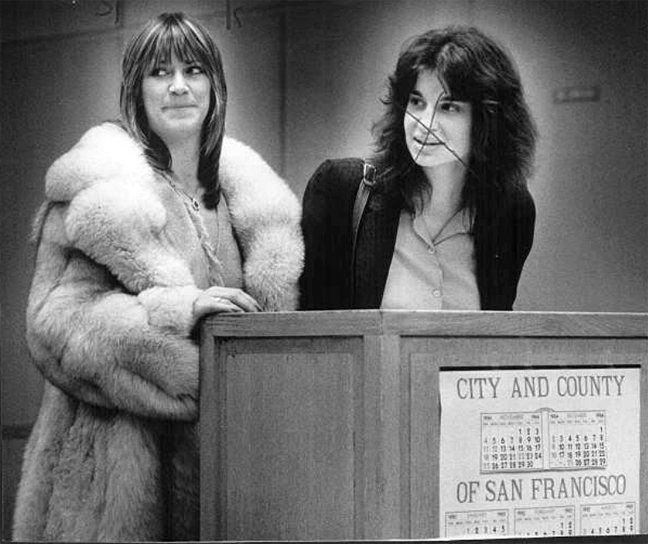 Marilyn makes a statement after her arrest
Marilyn makes a statement after her arrest
The city prosecutor ultimately dropped the charges against Marilyn, citing lack of evidence of any crime. In vindication, the Mitchell brothers posted Mayor Feinstein’s unlisted phone number on the O’Farrell’s marquee along with the invitation “For a good time, call Dianne.”
The arrest. The drug-induced lows. The explosive fights with Bobby. Marilyn was approaching her mid 30s and running on empty. Realizing her lifestyle wasn’t sustainable, Marilyn decided to cut things off from Bobby and checked herself into rehab. She needed to clear her head – and her veins – and get her life in order. She canceled all appearances and started to take care of herself. Chuck was reasonably supportive: it may have been money leaving the bank account but he could see that Marilyn was in a bad way, and she was only headed for worse if she didn’t do something about it.
While in rehab, Marilyn met Bill Taylor, a freight-trucking salesman trying to kick a heroin habit. The two hit it off and fell for each other. Not that it was plain-sailing: Bill was wary. He was well down the road to recovery while Marilyn was still in the early stages, and he worried that she might jeopardize his sobriety – so he took a step back. But Marilyn stuck it out, continuing with Narcotics Anonymous meetings after she got out of rehab, and eventually the two became a couple. After that, events moved fast: within months, they were talking marriage – and about Marilyn retiring from the adult business so they could start a family.
While Marilyn was considering stepping away from the adult stage, Chuck’s other ex – Linda Lovelace, now Linda Marchiano – was getting ready to give her final grand performance. Feminist Catharine MacKinnon had arranged for Linda to present testimony at the 1986 Attorney General’s Commission on Pornography. Established by President Ronald Reagan, the Commission’s stated objective was to “determine the nature, extent, and impact on society of pornography in the United States, and to make specific recommendations to the Attorney General concerning more effective ways in which the spread of pornography could be contained, consistent with constitutional guarantees.” In truth, the commission was a partisan, rigged, set-up job. It was far from an impartial study – anyone could see that by noticing that Meese had appointed many well-known anti-pornography crusaders to the panel.
As for Linda, she used her appearance at the hearings less to campaign against pornography and more to reinforce her story of Chuck Traynor, her abuser. She testified:
“My name today is Linda Marciano. Linda Lovelace was the name I bore during a two-and-a-half-year period of imprisonment. For those of you who don’t know the name, Linda Lovelace was the victim of this so-called victimless crime. Used and abused by Mr. Chuck Traynor, her captor, she was forced through physical, mental, and sexual abuse, often at gunpoint and with threats on her life, to be involved with pornography.
“I literally became a prisoner. I was not allowed out of his sight, not even to use the bathroom. At night, what he would do is put his body over my body so that if I did try to get up, he would wake up. And he was a very light sleeper. If I did attempt to move or roll over in my sleep, he would awaken.
“I have no rights as a victim. The only right I have is to be able to tell my story and hope that someone listens.”
Away from the public spotlight, Linda’s health was suffering. She had an acute case of hepatitis – the result of a drug transfusion after the car crash back in the 1960s that led her to meet Chuck. She was awaiting a liver transplant and still struggling financially – two facts that kept her looking to capitalize monetarily on any notoriety she retained.
She was also suffering from depression which led her to alcohol addiction. It was a dependency feminist Andrea Dworkin diagnosed as a response to the post-traumatic stress disorder that Linda carried from her time with Chuck. To make matters worse, Linda’s husband Larry was also an alcoholic by this point. Larry began attending AA meetings and was able to quit, but though Linda gave AA a try as well, she was less successful at fighting the battle against addiction.
While both Linda and Marilyn were struggling, Chuck was thriving. The Survival Store gun and gear sales remained strong, boosted by regular appearances from a group of scantily clad women known as the “Traynettes” in tribute to their manager. As for Bo, Chuck’s latest protege and romantic partner, she continued to gain popularity on the stripping circuit, thanks in part to a manipulative promotional tactic Chuck came up with.
DSC00350.jpg">DSC00350.jpg" alt="Chuck Traynor" width="648" height="423">
Chuck realized that Marilyn wanted to step back from the limelight, so he came up with the concept of an adult changing of the guard. He asked Marilyn to perform in a series of strip shows with Bo to help position Bo as the next Marilyn Chambers.
Recently married and newly sober, Marilyn was rather hesitant. She said:
“I used to love the order of going on the road, of doing each show at a certain time. But now, that’s an intrusion into my order as a housewife. Cooking and vacuuming are a joy to me for the first time. I love taking care of my husband. It’s more fun to make real love to one man than the fantasy of making love to 500. That’s all I want from Chuck, his blessing. I want to show him I can make the transition from pleasing all those men to just pleasing one man. Maybe that’s why I always need a man to take care of me. To be Daddy’s girl. That’s the way it was for me with Chuck, and that’s why I need his blessing now with my new husband.
But Chuck wasn’t put off by Marilyn’s lack of enthusiasm. He knew Marilyn, and he knew three things were still true: Marilyn loved the adulation, she appreciated the money, and she never wanted to let Chuck down. He was right of course, and eventually Marilyn relented, so she hit the road with Chuck and Bo, who was billed as “the next Marilyn Chambers.” The tour was popular, but there was no doubt who the men were coming out to see. They liked Bo alright, but they absolutely adored Marilyn. Sure, she was older and a bit heavier than the early days, but she still put on a great show for audiences nostalgic for one of the legendary adult film performers of the golden era. In truth however, it was a pretty cruel gimmick for Marilyn. She was effectively being marketed as a ‘has-been’ in order to promote the career of her ex’s new lover. It wasn’t a great way to bow out.
1.jpg">1.jpg" alt="Marilyn Chambers" width="503" height="648">Chuck and Marilyn
While Bo may not have been Marilyn, she was devoted to Chuck, and in 1986 she became his wife – Chuck’s sixth, in case you lost count. Why did the two marry? Well, Bo admitted she liked having a father figure. But what was the appeal in another marriage for Chuck? Here’s what Marilyn thought:
“Chuck has lived out most of his fantasies, but he still doesn’t know what’ll make him happy. Bo seems to have helped him there. He’s lost that angry edge he always had. I just hope she doesn’t hurt him. He says she’s his slave, but he dotes on her. It’s cute the way he fixes the bow in her hair. He sews all her costumes himself, by hand.
“I think he’s more interested in holding on to her than making her a star now. That’s why he’s on the road again. To keep her happy. She’s not inclined to be barefoot and pregnant. He needs to keep her needing him without her becoming famous. I just hope he hasn’t lost his perspective after all these years.”
Chuck continued to manage Bo’s career just as he still managed Marilyn’s. Eventually, Chuck and Marilyn sold their stake in the Survival Store to partner Bill Irwin and, in its place, Chuck and Bo tried their hand at horse breeding, starting the Mountain “T” Ranch Quarterhorse Club in 1992.
For Chuck, the 1990s were perhaps as close to settled as he could get. He bred the horses, did some firearm training, and Bo performed on the local stripping circuit. There was still some money trickling in from Marilyn’s career, mostly residuals from her movie sales. Marilyn had backed away from the adult industry, and finally had the baby she’d always wanted. Her relationship with Bill ended in 1994, but she was clean, sober, and she relished being a new mom.
And then in 1999, Marilyn dropped a bombshell. As she approached her 50th birthday, she announced she was returning to perform at the Mitchell Brothers’ O’Farrell Theatre. What’s more, she signed a contract with the adult film company, VCA Pictures, to make three X-rated films. These were Still Insatiable (1999), Dark Chambers (2000), and Edge Play (2000), each of them to be directed by Veronica Hart, aka Jane Hamilton.
Times had changed however – in some ways for the good, in others less so. On the positive side, when Marilyn returned to San Francisco with a new strip show, she was greeted like a hometown hero. Mayor Willie Brown proclaimed a ‘Marilyn Chambers Day’ for her unique place in San Francisco history, and he praised her for her “artistic presence”, her “vision”, and her “energy”. It was all a far cry from the days of ‘Behind the Green Door’ when she’d been the notorious of queen of California counter culture.
The films however were less well-received. They were big sellers, but critics savaged her older, heavier appearance, and advised her to retire – this time for good.
When the final film was released, Marilyn retreated into adult entertainment retirement. Not that she disappeared from the limelight however. Marilyn found a career in independent films, one that she enjoyed, claiming that the more laid-back pace of these roles suited her as there was a lot less pressure on her to perform, and she didn’t have to be young and skinny either. She embarked on a political career as well, running for vice president on the Personal Choice Party ticket, a libertarian political party, in the 2004 and 2008 U.S. presidential elections.
If Marilyn was staying busy and reasonably relevant, Chuck was slowing down. He was approaching 60 years old and his love of southern cooking was catching up with his arteries. The climate and culture of Las Vegas worked for him, so he figured he’d stick around there to see out his days. But in January 1999, Chuck got a call from his brother Bernard in Florida. Their mother, Elaine, was seriously ill. Bernard said he didn’t know how long Elaine had left, and that Chuck might want to get down to Florida sooner rather than later.
The prospect of Elaine dying was a wake-up call for Chuck. Whether by force or by choice, Elaine had abandoned Chuck as a child and only came back into his life when he was an adult. But once she was back, she doted on Chuck. In her eyes, he was a military vet, a successful businessman, and a loving son who could do no wrong. And while he tried not to show it, Chuck always craved his mother’s validation. Linda had witnessed it back in the early 1970s, and Marilyn saw it whenever they visited Elaine.
DSC00006.jpg">DSC00006.jpg" alt="Chuck Traynor" width="648" height="429">
So when the call came letting Chuck know that Elaine was failing, it hit him hard. Sure, he had some things going in Vegas, but he reasoned that perhaps he could get things going in Florida, just like he had decades earlier. And if it all went to shit in Florida, well, Vegas wasn’t going anywhere. So Chuck told Bo they were moving to Florida. Bo wasn’t thrilled with the idea, in part because she liked the west coast, but also because there was a new man in her life. Chuck had introduced Bo to a guy named Grant Stapleton and she’d taken a real shine to him. Like Chuck, Grant was a vet, a gun-loving survivalist, and he was older than her – though still ten years younger than Chuck. And while Chuck was pretty reserved, Grant was an extrovert with a magnetism that Bo found attractive. Bo felt conflicted, but she’d vowed to honor and obey Chuck, so, as the dutiful wife that she was, she followed Chuck to Florida.
Chuck’s reunion with his mother Elaine was short-lived. In March 1999, Elaine died at the age of 79. She left her house to Chuck’s brother Bernard, but Chuck asked his brother if he and Bo could stay there while they found their footing. It’d been years since Chuck had lived in Florida, so he set off to go around the old strip joints and see if he could find work for Bo. He became an active member of the local rifle club. He even began checking out local horse farms to get a sense of commercial opportunities. It was a far cry from when he lived there back in the 1960s when he’d smuggled drugs into the country, and ran a live sex joint.
Bo-01.jpg">Bo-01.jpg" alt="Chuck Traynor" width="648" height="482">Bo – publicity still
For Chuck, it felt good to be home. His mother was no longer around but Bernard and Elaine’s brother John were family and they lived locally. Chuck began hanging out with a few of his old pals and re-establishing his roots. It was familiar territory, and he still knew how to play it.
But Bo struggled. She felt isolated in the small town of Williston, population 2,500. She didn’t know anyone, and took a back seat to Chuck as he tried to get things going. She spent more and more time on the phone to Grant and came to rely on those calls like a lifeline. She felt a distance growing between her and Chuck while at the same time feeling more dependent on him than ever.
Then on April 22nd 2002, Chuck opened the morning newspaper and saw the day’s headline: Linda Boreman – formerly Linda Marciano, Linda Lovelace, and Linda Traynor – was dead. She’d been in a car accident and died of the injuries that she sustained.
The last years of Linda’s life had been difficult and complicated. In 1996, suffering from alcoholism and depression, she’d divorced Larry Marciano after 22 years of marriage. She’d taken on a number of secretarial jobs after that, but none stuck. Her hepatitis worsened, and her kidneys were failing.
What’s more, she’d soured on the anti-pornography feminists whom she’d once seen as her allies. She’s started to feel used by them, especially as they reached out to her less and less. Linda changed her tune once more, saying again that she was against censorship of any kind. She conceded that there were willing female participants in the sex industry and that not everyone was coerced into the business. To make some money, she even posed for the men’s magazine Leg Show, albeit fully clothed, and began signing Deep Throat memorabilia.
Lovelace-Legshow.jpg">Lovelace-Legshow.jpg" alt="Linda Lovelace" width="487" height="648">
This latest chapter in Linda’s changing attitude towards the sex industry caused more people to turn against her. They called her a hypocrite and discredited her statements. But to be fair to Linda, there was one topic where she stayed absolutely consistent throughout her life, and that was her assertion that Chuck had abused her. On that, she never wavered.
So how did Chuck react when he read the news that the woman he once claimed to love, even when she came out against him, was dead? Asked for his feelings by a reporter, his answer was short: “She didn’t have much luck with cars.”
When Linda died in 2002, it had been over 30 years since she’d met and married Chuck and over 28 since the couple had divorced. But while decades had passed, their lives had remained inextricably entwined. Up until her death, Linda had been publicly defined by her short-lived relationship with Chuck and the abuse that occurred. And the same applied to Chuck. Every obituary of Linda cited him as an abuser, a misogynist, and a sadist.
With Linda’s death, Chuck was suddenly back in the news again. But just three months later, home after a training session with Bo to keep her fit for performing, Chuck suffered a massive heart attack. Bo rushed him to the local hospital, but it was too late. Chuck died on July 22, 2002.
So what happens when the man who helped create two of the biggest female stars in the history of the adult film business passes? Actually, very little, at least as far as media coverage is concerned. None of the major papers noted his death. In fact, the only obituary that appeared was placed by his family in the local Florida Gainesville Sun. It read simply:
“WILLISTON – Charles Everett Traynor died Monday at Nature Coast Regional Hospital. He was 64.
“Mr. Traynor was born in Mount Vernon, N.Y., and moved to Williston from Las Vegas three years ago. He was a rancher and a pilot. He was an expert rifleman and a member of the Williston Shooters Club. He was a member of Holy Family Catholic Church.
“Survivors include his wife, Bo Bozlee Traynor of Williston; and brothers Bernard Metcalf of Homestead and John M. Traynor of Bronson.”
chuck005.jpg">chuck005.jpg" alt="Chuck Traynor" width="648" height="447">
So Chuck’s wife Bo became a widow at the age of 39, stuck in a town where she knew few people and still felt like an outsider. She turned to Grant, leaving Florida for Pennsylvania to get married to him – with the wedding taking place just five months after Chuck’s death. Bo’s marriage to Grant turned out to be a volatile one. Friends said that when it came to violence and threats, Grant was Chuck on steroids. Seven years after Bo married him, Grant committed suicide, leaving Bo a widow once again. Since then, Bo has stayed away from the adult industry and, when I contacted her for this series, she told me she had no interest in revisiting the time she spent with Chuck.
Unlike Bo, who rebounded quickly from Chuck’s death, Marilyn was devastated by his passing for a long time. While she’d stopped being Chuck’s wife many years before, she remained his business partner and a friend who valued and loved him. Marilyn slid back into drug and alcohol use, and Chuck’s death intensified her relapse.
Eventually, Marilyn got clean again and rebuilt her life. She set up in a mobile home outside Los Angeles and began selling cars at a local dealership. To supplement her income, she’d go to the occasional convention and sign photographs. It was a quiet life for a former porn star, but it suited Marilyn just fine.
Then, in 2009, Marilyn’s daughter found her mother dead at home. Marilyn had died of heart disease, and was just 56.
Up to her death, Marilyn remained loyal to Chuck, defending him to anyone who questioned his character. As her friend Peggy remembered:
“She liked people that she trusted, and what they did for her. ‘You would do that for me? That must mean you really love me, you really care for me.’ He made that all happen. She never forgot people that helped her. She never said anything other than she loved him. Never.”
In the years since his passing, popular culture hasn’t been kind to Chuck. And there have been a slew of productions that feature him. In September 2002, there was a UK television special ‘The Real… Linda Lovelace’, made quickly in the wake of Linda’s death, that featured an interview with Chuck making the case for the important mark he left on the adult industry. Then there was a short-lived 2003 rock opera, named ‘Lovelace, The Musical’, created by Charlotte Caffey and Jane Wiedlin of the Go-Gos and starring former ‘Family Ties’ actress Tina Yothers. The 2005 hit documentary ‘Inside Deep Throat’ told the story in colorful details. There was a play, ‘The Deep Throat Sex Scandal’, in which Marilyn Chambers was initially cast but never performed in due to her death. And then there was the 2013 biopic ‘Lovelace’, starring Amanda Seyfried as Linda and Peter Sarsgaard as Chuck.
In all these productions, Chuck is either a derided side note as in ‘Inside Deep Throat’ or the central bad guy, as in ‘Lovelace’. At the ‘Lovelace’ premiere, actor Peter Sarsgaard who played Chuck, felt he had to give a lengthy justification about why he had accepted the role. He said:
“[I]…just profoundly did not want to do the role. I kept dragging my feet. It took weeks to decide. And then it was tough the entire way. It was like every day I was going on the set, looking on the call sheet and I was doing something awful. I would try to be in the head of this person and it wasn’t nice. I also knew the film was not interested in fully understanding what made him tick because it’s Linda’s story.”
But Svengali has been Chuck’s story. It may seem strange for a woman to investigate this story – and to tell it through the eyes of its most maligned, male figure. But I made the series because I was interested in understanding what made him tick and how he helped create two of the biggest names in golden age pornography. I also made this podcast series in response to the times we’re living in. The world feels more polarized than ever. Fueled by mainstream and social media, tribalism overshadows empathy, and people are always either good or bad rather than the mix of both that we all are.
So, in the end, what do we make of Chuck Traynor? It’s clear he abused Linda Lovelace – that was confirmed by Chuck himself. Linda claimed he did it out of sadism, actually taking pleasure in harming her. Psychologists might say he did it as a result of childhood injury – the fact that he felt rejected and abandoned by his parents and so he never developed a healthy ego.
Here’s Chuck saying why he did it:
“I’m sort of a redneck, you know. Raised down south. I believe broads have to be submissive. I don’t believe in equal rights, but I’m probably not as abusive or as abrasive as Lovelace would make me out to be. I believe women have a place. I think beautiful women should be adorned and adored as long as they stay in their place and stay beautiful.
“I don’t consider it beating if you slap your old lady for something. To me that’s almost a sign of feelings, of closeness. When your old lady does something wrong or when she’s giving you too much lip or something – I don’t really consider that beating up.
“At the time, Linda seemed like she liked it. She seemed like a lot more together person when she was with me than the person she wrote about in her book. But she was emotionally fucked up a long time before I met her. She was no kept prisoner, nailed to the wall. I would tell her not to leave, probably forbid her to leave, just as I would imagine most boyfriends or husbands or managers or pimps from the South would. If she actually left and stayed away, I would be very pissed off about it, but it would have died.
“I just don’t believe that the time that we spent together and the time she was involved, she hated every minute of it.”
Then there’s Chuck and Marilyn Chambers. According to both Marilyn and Chuck, violence did not play a role in their relationship. There was what Marilyn referred to as “rough play”, but she says she was more often the one to initiate it. And until the day Marilyn died, she said she loved Chuck and valued their friendship:
“You know, Chuck is pictured as this creepy guy. But he’s not. He’s one of the nicest men I’ve ever met in my life. I rely on Chuck for everything, absolutely everything at all. I know that I need it. I know that I am not really good on my own. I need Chuck. I need guidance.
“People say he exploited me, but I exploited myself because I wanted to.”
With both Linda and Marilyn, Chuck played a huge role in their adult careers. Chuck made Linda Lovelace a household name, though she never wanted to become one. And he helped propel Marilyn’s fame and fortune, which was exactly what she longed for. Was Chuck just in the right place at the right time?
Maybe – but he was also a guy who was a hustler that actively saw opportunity in the sex industry. In the 1960s, this insight drew him to Bunny Yeager and Joe Sarno. And in the early 1970s, it brought him to Times Square, New York with his new wife Linda, a path that led them to ‘Deep Throat’ – the defining event in both their lives.
I’ve spent hundreds of hours researching Chuck’s story, and I’m glad I did. It led me to sixties sexploitation, prostitution, and international drug running in Miami, the early loop days in New York, Sammy Davis Jr’s Hollywood and Hugh Hefner’s Playboy mansion. It’s taken me to the notorious O’Farrell Theater in San Francisco, the theaters of London, famous Las Vegas casinos, and strip clubs all across America.
In the end, with Chuck, what you see is what you get. A boy abandoned by his parents and growing up in the macho South of the 1940s and 50s. A young adult with a chip on his shoulder determined to get what he was brought up to believe a man deserves. An opportunist who prioritized himself first, especially when it came to women.
And he was always – as welcomed by Marilyn Chambers but most definitely not by Linda Lovelace – a Svengali.
*
DSC00446-slide.jpg">DSC00446-slide.jpg" alt="Chuck Traynor" width="648" height="430">
Svengali
/svenˈɡälē,sfenˈɡälē/
noun: a person who exercises a controlling or mesmeric influence on another, especially for a sinister purpose.
*
The post Svengali – The Chuck Traynor Story: Part 7, Endgame, Podcast 137 appeared first on The Rialto Report.
On the previous episode of Svengali – The Chuck Traynor Story:
To everyone’s surprise, the sex film Deep Throat (1972) had become a financial hit and a cultural phenomenon. And everybody involved was determined to capitalize on the film’s success – and that included Chuck Traynor, husband and manager of Linda Lovelace, the movie’s leading lady.
When the film blew up, Chuck put Linda through his self-styled media training, positioning her as a small-town, sex-fueled hippie who’d hit the jackpot in the Big Apple. And he got busy putting together deals: he negotiated a lucrative contract for her in the sequel Deep Throat II (1974). He secured a healthy advance for Inside Linda Lovelace, a pseudo-autobiography. He convinced Linda to move to California with him where they ingratiated themselves with high profile figures like Sammy Davis Jr. and Hugh Hefner. And keen to expand Linda’s profile beyond the adult world, Chuck landed her a stage show at Miami’s Paramount Theater.
But as Linda’s star rose, so did her self-confidence. She began to realize that she was drawing the attention and money, not Chuck. And as Linda’s esteem grew, Chuck’s attempts to control her weren’t quite as powerful as they had been.
Finally, in September 1973, after almost three years under Chuck’s thumb, Linda decided to stand up for herself. She filed for divorce, citing abuse and irreconcilable differences. She had a new man at her side too: she was dating David Winters, an English-born dancer and choreographer.
She was free from Chuck and could start a new life. Chuck was ancient history, and would now disappear into the rear-view mirror, right?
Wrong.
Welcome to Episode Six in our series ‘Svengali – The Chuck Traynor Story’.
You can hear the last episode of the Svengali series here.
This episode running time is 66 minutes.
—————————————————————————————————————————————————–
1. An(other) Autobiography
In early 1974, a second autobiography of Linda Lovelace hit the shelves. It was called ‘The Intimate Diary of Linda Lovelace’. This is how it begins:
“I am taking my life in my hands by writing this. That may sound like a dramatic way to start a book, or just a joke, but it is true. If my arms are broken or I end up in a ditch somewhere, if acid is thrown in my face or I am shot, I want it in black and white.
Once and for all, I have got to be free. Maybe if I tell the whole story, the true story, I will finally get if off my chest and out of my system, and I will be able to forget it forever.
“I have been threatened by a man who is very sick. He is full of violence. He has threatened the lives of my brilliant attorney, my business manager, the man in my life, David Winters; my secretary Dolores and her daughter; and, of course, myself.
“Sometimes I think I will go live in a different country and just never be heard from again. But that would be giving up my life in another way and I am not going to do that either. I am a star now. Here I am, the sex symbol of the seventies, the woman who really believes in giving love and enjoying it, and who is “really free.” The truth is that there was a time when I wasn’t allowed to go for a hamburger by myself. Now I am working to become really free. Free in every way.
“If you noticed the black and blue marks on my body in the movie ‘Deep Throat’, you might have wondered where they came from. I’ll tell you. My husband. Little souvenirs, reminders that he was the colonel and I was the private. From the time I met him, I never did anything, said anything, or went anywhere that was not his idea. That might have been okay if I had been willing. But I was doing terrible things that I didn’t want to do. Not ‘Deep Throat’. I enjoyed doing what I did in ‘Deep Throat’ – it’s what happened sexually with Chuck that I hated.
“The reason I married Chuck wasn’t because of moonlight and violins and love; I married him because he swore to beat the shit out of me if I didn’t. When I refused, he threw me to the ground and kicked me. Somehow, I was persuaded.
“You might wonder how I finally put it all together to get away from Chuck. When I became a big name, everybody wanted to meet me. I began to be myself again. I was around people who were sensitive and kind and treated me like a person. Before I met Chuck, I had been carefree and happy.
“Let me say one final word to my ex-husband. I don’t have any hard feelings anymore. As a matter of fact, I wish you only what you wish yourself: Shit.”
linda-lovelace-01.jpg">linda-lovelace-01.jpg" alt="Linda Lovelace" width="648" height="485">Linda Lovelace
*
2. Chuck Responds
‘The Intimate Diary of Linda Lovelace’ was written in three days by a ghost writer, Mel Mandel. Mel had got to know Linda and her new boyfriend, David Winters, and spent hours with her listening to her account of years of abuse suffered at Chuck’s hands. The resulting book was part manifesto, part financial gambit.
When the book was published, Chuck was predictably livid that Linda had gone public with her story. When contacted by reporters, he alleged that the book was paid for with money that was actually his. As Chuck said to one reporter:
“All I know is that I gave David Winters $10,000 to teach her to dance for Linda’s big show. Next thing I know, all of a sudden, Linda, David, and my $10,000 disappear.
“Anybody in his right mind is not going to take that sitting down. Suddenly my creation walks out with some schmuck because she thinks he’s the biggest hustler in Hollywood.
“But none of them realized that I was Linda Lovelace. That body, that throat, and those silicone tits walking around were bullshit, you know? Linda was nothing. But David thought she was a gold mine.
“And Linda bought it, you know? She just listened to everybody telling her what a big star she was and how I was handling her all wrong. That was her mistake.”
When asked about Linda’s claims that he’d started harassing her after she left, Chuck pretty much admitted it:
“I heard from her attorneys that she was filing for divorce and that she wouldn’t honor any of the contracts – she said she considered them illegal because she’d been forced to sign them.
“So I was left in a real bad position by Linda because we were doing pretty good. We’d made about $100,000 in a little less than a year. So, yeah, I was flabbergasted because not only had somebody stolen my old lady, but because I was president of our corporation too.
“So of course, I reacted. I wanted her back. In fact, we have a commitment in Miami that a friend of mine has put up a $10,000 bond on. As you know, somebody is going to suffer if these contracts are broken.”
Linda-and-David-01.jpg">Linda-and-David-01.jpg" alt="Marilyn Chambers" width="475" height="648">Linda and David Winters
*
3. D-I-V-O-R-C-E
And so Chuck kept on pursuing Linda, using every trick in the book. Linda wrote about Chuck’s pleas in her autobiography:
“Look, I love you and you are my wife,” he said. “I do not think you have sufficient reason to stay separated from me. I was kind enough – and am kind enough – to put up with it for a little bit. I have not given you grounds to stop loving me. And you better not fucking act like I fucking have. I have done nothing wrong. If you go to court with me, you’re going to look like a complete asshole. I haven’t fucking run out on you. I don’t drink. I supported you well. And I’ve taken care of you.”
Linda was adamant however, and when she made clear that there was no way she would remain Chuck’s wife, he changed tactics, trying to appeal to her business sense. Now he’d say: “If you don’t want nothing else, just fake it, babe. If you hate my guts, fine, sleep in the next room. But don’t fucking blow the whole business. That’s all I ask.”
Whatever Chuck said, Linda wasn’t listening any more. In fact, she wanted nothing to do with him. But Chuck retained an ability to surprise. And just as she was bracing herself for a long, drawn-out divorce battle, all of a sudden, Chuck seemed to have a change of heart. He stopped fighting the divorce and said he was willing to let her go. There was one catch: he just wanted what he was entitled to. He filed papers stating that he alone had made ‘Linda Lovelace’ and thus was about to lose out on substantial contractual agreements like their upcoming Paramount theater show in Miami. He argued that he deserved most everything they had as a couple. Yearning to be free of Chuck, Linda relented and gave it all to him.
So Chuck and Linda met at the lawyer’s office and played out the dynamics of their relationship one last time. Chuck recalled: “Linda kept coming on like I was the enemy. I was going to give her a check and started to make it out to Linda Traynor, and she said, “My name’s Linda Lovelace.” I said, “Hey, you’re still my wife, and your name’s Linda Traynor.” But she insisted the check be made out to Linda Lovelace. So I said, ‘Fuck you. It’s going to be Linda Traynor or no check.’”
After finalizing the divorce, Linda recalled Chuck turning to her, and for one brief moment, Linda thought she saw a flash of vulnerability: “He said, ‘Just remember that I love you. And if you ever change your mind, I’ll always be there.’
For Linda, it was too little, too late. All that mattered to her was that she was finally going to be free of Chuck Traynor. To celebrate the divorce, Linda went down to the Los Angeles Superior Court, and legally changed her name to Linda Lovelace, finally claiming the only part of her that Chuck wanted to hold on to.
Announces-Nightclub-Act-1973.jpg">Announces-Nightclub-Act-1973.jpg" alt="Linda Lovelace" width="557" height="648">
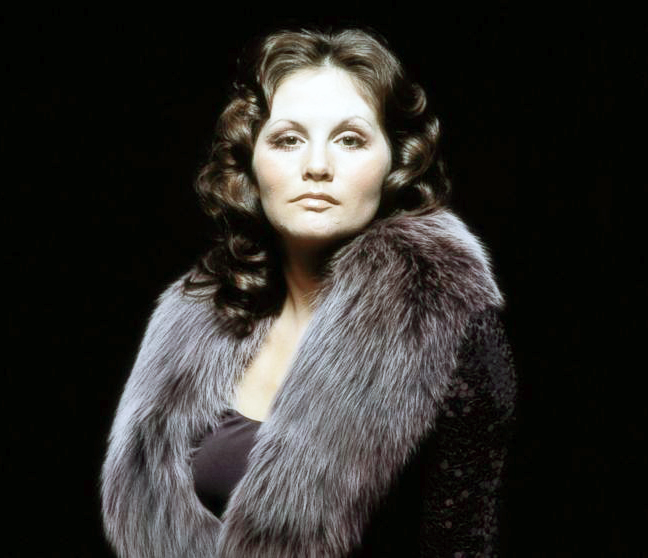 Linda, photographed by Milton Greene
Linda, photographed by Milton Greene
*
4. Moving On
The Traynor divorce may have been final but the legal battles were far from over. Linda’s scheduled show at the Paramount Theater in Miami was under threat – largely because Linda was spending all her time with David Winters. When it was obvious that the rehearsals were going to be delayed, the show’s producer agreed to push back the opening date by a month. But even with the added time, Linda wasn’t ready – or perhaps willing – to go ahead with the performance. So in the end, she decided to break the contract. David suggested that they use illness as the reason, but the organizers weren’t buying it, and they sued Linda Lovelace Enterprises for breach of contract. Rumor was that it was Chuck behind the scenes who was pushing for Linda to be sued.
That was only the start of her legal problems. Remember Phil Mandina from the first part of our Svengali series? He was the lawyer who represented Chuck in his 1971 drug smuggling case. The same lawyer Linda said was actually Chuck’s partner in the drug smuggling operation.
Well, he’d stuck around. In fact, he’d helped Chuck and Linda set up Linda Lovelace Enterprises and acted as their representative for almost all legal matters. When Linda and Chuck divorced, Chuck encouraged Mandina to sue Linda for nonpayment of legal fees for services rendered in 1973.
Linda tried to fight back by revealing sleazy details she knew about Mandina’s past – which didn’t just include being a possible accomplice to drug smuggling. She declared:
“The story of Philip J. Mandina is particularly juicy, as intricate as any espionage novel. In fact, his background is an open cesspool. It involves grand larceny, tax dodges, a wealthy heiress, a call girl, and a cast of sleazy secondary characters that would make any TV writer drool.”
Linda’s lawyers tried to use the information to discredit Mandina’s legal case against Linda but to no avail. Linda ultimately was ordered to pay $32,000 to settle the case.
Linda needed new income streams to pay her bills. She no longer had Chuck making deals for her, so she turned to her boyfriend David Winters. In December 1973, Winters signed a contract for Linda to appear in a touring production of a bedroom farce called ‘Pajama Tops.’ Linda was nervous about signing a long theatrical commitment as she had little acting experience, but she needn’t have been worried: the play closed after just a week due to dismal ticket sales.
Pajama-Tops-01.jpg">Pajama-Tops-01.jpg" alt="Marilyn Chambers" width="648" height="266">
Next Winters signed Linda up for a tour of college campuses. Linda spoke at 25 schools in the first six months of 1974 for a fee of around $4,000 a pop. In reality, while Linda did the talking, it was actually Winter’s words she was speaking. He’d written a script for her which was essentially a defense of sex films, and included statements like: “We show action and dying in movies, so why can’t we show love? And sex is a part of love, so why can’t we show sex and why can’t we show love? Why is that banned?”
While Linda worked the university circuit, Winters was also keen to maintain a profile in Hollywood that they could exploit – and sure enough, Linda was invited to attend the Academy Awards. Linda wanted to make a splashy entrance, so they hired a coach drawn by white horses and accompanied by footmen to take her there. When Linda stepped out onto the red carpet, she was wearing a leopard-skin bikini walking a great Dane. Later that evening they partied at the Playboy mansion – a place they visited regularly, often staying for several nights.
But while Winters was working hard to exploit Linda’s name, things weren’t moving fast enough for his liking. So in early 1974, he decided they should make an extended visit to his home country of England. Linda would be a huge hit across the pond, Winters reckoned. Sex comedy films had grown in popularity there, and Brits were hungry for more. ‘Deep Throat’ had been banned from theaters in England, but bootleg copies of the film were still circulating and stories of the film’s popularity in the U.S. were legendary.
Winters started the trip by contacting the English tabloid, the News of the World, and made a deal for front page coverage of Linda. He invested in a campaign that featured photos of Linda on the back of a London double-decker bus. He even rented two Rolls Royce cars for them to drive around and be seen in – one with a license plate that read ‘penis’, the other emblazoned with ‘womb.’ Tasteful, no? Unfortunately, the PR blitz didn’t make much of an impression, and before long they returned to the States, tails between their legs.
Back in California, David tried to secure funding for a production of a comedy about a young inn keeper in the Midwest who murdered her guests and buried them in the backyard. It was a bust – and the play went nowhere. So he came up with another idea: a film called Linda Lovelace for President (1975).
The movie’s plot would be simple and fun. Linda would run for president on a platform of free love, touring the country along a route shaped like an erect penis. Er, and that was it. Remarkably, Winters raised $800,000 for the movie and assembled a respectable cast and crew: the screenplay was by a regular writer for ‘Rowan & Martin’s Laugh In.’ The director was well known for his work on ‘I Dream of Jeanie.’ And the supporting cast included comic Chuck McCann, actor and musician Scatman Crothers, and Micky Dolenz of the Monkees.
Winters arranged for Linda to get a salary of $125,000 and 15% of the film’s profits. And after convincing Hugh Hefner to devote ten pages in Playboy magazine to the movie, Winters was confident those profits would be sizable. But then the film was released.
Reviews appeared quickly and they weren’t kind. Here’s an example from The Boston Globe in early 1975:
“’Linda Lovelace for President’ is rated X, presumably for Xcrutiating. This is, without question, the most witless piece of trash ever made, so bad, in word and deed, that its blistering ineptitude outranks any movie I’ve ever seen. And, Miss Lovelace is best when she keeps her mouth shut.”
The film didn’t fare better at the box office either, and was a complete financial failure. Winters quickly turned his attention to the next vehicle for Linda. He’d recently met a highly prolific Italian film producer named Ovidio Assonitis who was making a name for himself in B-movies. Ovidio thought Linda would make an ideal leading lady for his next picture, an unofficial sequel to the box-office smash, Emmanuelle (1974). The new softcore film was to be called Forever Emmanuelle (1976) (aka Laure), and Linda Lovelace was cast in the lead role earning a salary of $120,000 while Winters would get a healthy sum as co-executive producer. When the film was released in 1976 however, Linda didn’t feature. Ovidio was contacted in recent years to find out what happened, and he claimed he’d had to fire Linda because of her drug use and for refusing to do any nudity.
By now Linda’s relationship with Winters was starting to fall apart. Cracks had started to show as early as January 1974 when Linda and Winters were arrested for cocaine possession in Las Vegas and Linda strongly suspected Winters had set it up for publicity.
Linda noticed how easily David spent their money, lavishly rewarding himself for every project he helped put together – whether it was a success or not. She was surprised one day when Winters came home having bought two Bentleys without even consulting her. And then she learned that while his car was purchased, hers was just leased.
What made it even worse was that Winters had started to exhibit the same type of controlling behavior that she’d endured so painfully in her previous relationship. Winters started demanding that she do exactly what he wanted. This was obviously a sensitive area for Linda, and so she accused Winters of acting just like Chuck. Winters flatly denied this, but at times his words did sound suspiciously like Chuck. See what you think. This is what Winters said to a friend:
“Chuck controlled her in a nasty and terrible way. I controlled her because we had a joint vision – which was to create this incredible movie star and be happy together. She was the product, and I molded her as I wanted her to be.”
But in truth, Linda wasn’t the only one growing weary of the relationship. Winters was tired of what he felt was Linda’s childish and petty behavior. He said she never stopped complaining about Chuck, or lamenting that her fame was still tied to ‘Deep Throat’, a cheap pornographic film.
Even Sammy Davis, Jr., Linda’s ex-lover, pulled Winters aside one day and put it bluntly: “You’re killing your career, kid. What are you doing? Don’t base your life around her.”
The writing was on the wall: Linda’s and Winters’ relationship was on its last legs.
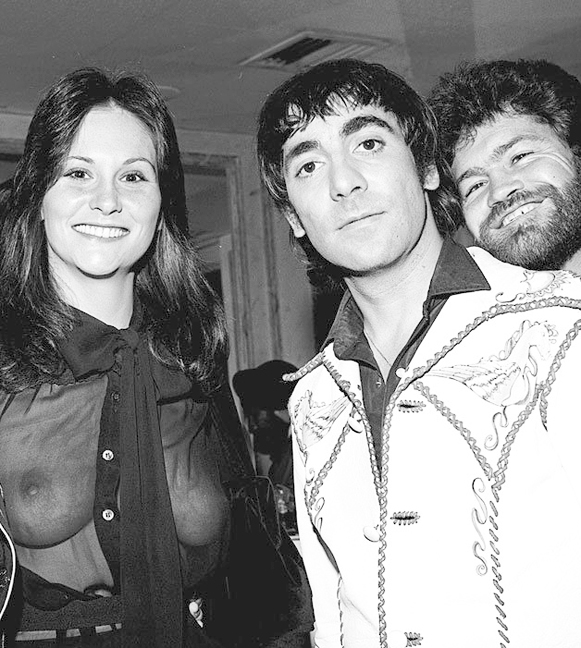 Linda, Keith Moon – drummer from The Who, Micky Dolenz from the The Monkees
Linda, Keith Moon – drummer from The Who, Micky Dolenz from the The Monkees
*
5. Trying Again: Chuck Meets Marilyn Chambers
So, while Linda was trying to make her own way in life and figure out her relationship with David Winters, where was Chuck? Was he waiting in the wings, pining for Linda, and hoping she’d have a change of heart and come running back to him?
Not so much.
As soon as Linda grew close to David Winters, Chuck realized that his grip over his former ingénue was slipping. So what was a guy, who’d dedicated years of his life shaping the persona and professional path of his protégé, supposed to do?
Publisher and provocateur Al Goldstein interviewed Chuck at this time. and asked this very question. Chuck laid out his views:
“I was Linda’s, of course, manager and agent, and sort of over-looker. So I had to keep an eye out on the horizon for who was coming up in the business. And the only person that I could see, that looked like they were gonna come on pretty strong, was Marilyn.”
Marilyn-Chambers-01-1.jpg">Marilyn-Chambers-01-1.jpg" alt="Marilyn Chambers" width="428" height="648">Marilyn Chambers
The ‘Marilyn’ Chuck is referring to is Marilyn Chambers. She’d become a break-out adult star thanks to the film Behind the Green Door (1972), produced by Jim and Artie Mitchell. The Mitchell Brothers had jumped into the porn business head-first in the late 1960s, opening the infamous O’Farrell Theatre in San Francisco’s Tenderloin neighborhood. Marilyn became the personification of their success and a nationally famous figure.
Back to Chuck:
“This was about the time Linda met David Winters and decided she was gonna be a big legitimate actress, dancer, and whatnot. And I could see things happening, so I was talking to Marilyn on the phone, Marilyn knew who I was by reputation. And Linda walked out one day about noon time and I called Marilyn about 1 o’clock and she arrived in Los Angeles… 24 hours later. And I just said, “This is the situation. This is the way I operate.” she said, ‘Fine.’”
Marilyn Chambers had started life as Marilyn Briggs, a 19-year-old aspiring actress originally from a middle-class family. As Marilyn later shared in an interview with journalist Geraldo Rivera, she’d always wanted to perform:
Marilyn: “Well I first started in this business when I was about 15 years old. I started communicating into New York from Westport Connecticut.”
Geraldo: “A very staid, respectable community in Connecticut – a suburb of New York really.”
Marilyn: “Right. And I was with about four modeling agencies. And I did a lot of print work – the Ivory Snow box – when I was about 18 I did that. I did a Clairol commercial, Pepsi generation, that kind of thing. I did a lot of television…television work. And I was in a film called ‘The Owl and the Pussycat’ (1970).”
Geraldo: “With Barbara Streisand…”
Marilyn: “Yeah. And at that time I was going to acting school in New York for about a year and a half. And uh Columbia Pictures sent me out to California to do a publicity tour for ‘The Owl and the Pussycat’. And I really fell in love with California. And I decided to move out there – San Francisco. But to my dismay, San Francisco was kind of a… It was a very hip place but it certainly wasn’t the place for an entertainer to be looking for work. So I read an ad in the newspaper one day, hoping I could find a movie part…
Geraldo: “What did the ad say? This I have to hear.”
Marilyn: “’Now casting for a major motion picture.’ Oh, this is my… this is my spot. So I went down and met the Mitchell Brothers. They explained the whole story to me. And I really like the story. About that time in my life, I really decided that instead of being another starlet around Hollywood, you know, who gets lost in the stampede, I thought this is going to be the ‘in thing’ – you know I really had that feeling that this is the way that films were turning.”
‘Behind the Green Door’ became one of the highest grossing adult movies of the era and Marilyn, motivated and ambitious, was keen to capitalize on the film’s success. Together with Linda Lovelace, Marilyn Chambers was the most famous adult film star of the era.
But whether Chuck approached Marilyn or Marilyn approached Chuck is unclear. Author John Hubner, who profiled the Mitchell Brothers, claimed it was Chuck who pursued Marilyn, reinforcing Chuck’s alpha-male persona. Hubner wrote: “Chuck had approached Marilyn Chambers while he and Linda were still married. After he and Linda split up, Chuck began pursuing Marilyn in earnest. Marilyn finally agreed to meet Chuck while on a trip to New York, and Chuck had a limo waiting for her at the airport. Basically, Chuck convinced Marilyn Chambers that he, better than anyone else in the business, knew how to appeal to the eternal twenty-one-year-old lurking within all men.”
But Marilyn later declared it was actually the other way around, and that it was she who was the one who set her sights on Chuck:
“It was my mission to find Chuck Traynor. I had to find him, had to get this guy. And I wanted him to become my manager because I wanted him to do for me what he did for Linda. My whole life I wanted to be Ann-Margaret, that’s all. I love Ann-Margaret. And that’s who I wanted to be. And I figured Linda was going to get there first. I thought, I’ll be darned if I’m going to let that happen. So I said to Chuck, ‘I really want to meet you.’”
Whomever initiated contact, at this point, as we know, Linda had already started publicly sharing troubling details of her life with Chuck, painting him as cruel and sadistic, a master manipulator. That didn’t deter Marilyn however – she still wanted to meet him, driven by a youthful naiveté that was a combination of ambition and curiosity. During her first meeting with Chuck though, she did look for signs of the abuser that Linda described. This is how she remembered their first encounter:
“Chuck and I got along really well. And I’m thinking, ‘Why are these people saying these horrible things about him? He’s a really nice guy. He’s one of the most intelligent, soft people I’ve ever met in my life. He’s really on the ball. We stayed up all night talking. And he didn’t try to put the move on me at all, which was like “Thank you, Jesus!” He was very much a gentleman.”
So Chuck and Marilyn hit it off from the start, and it didn’t take long for them to agree to form a partnership. Chuck asked his long-time lawyer Phil Mandina to draw up paperwork formalizing the collaboration, and brought it to Marilyn with the expectation that she’d sign then and there. But while Marilyn may have been young, she was no easy mark. She looked it over, made a bunch of red-line edits, and renegotiated her stake in the partnership. Chuck – equal parts irritated and impressed – wasn’t used to this independence from his days with Linda. Nevertheless he signed, and Chambers-Traynor Enterprises was launched.
Just as quickly as Marilyn and Chuck formed a working relationship, they started a romantic one as well. In truth they were both seeing other people at the time: Marilyn was still married to a bag-pipe playing street musician back in San Francisco, and Chuck had started dating Jayne Mansfield’s daughter, Jayne Marie. No matter, from the night they signed their agreement, Marilyn went back to Chuck’s place and moved in.
Now that they had both a business partnership and a romantic relationship, Marilyn made her goals explicit:
“I told Chuck I didn’t want to do erotic films my whole life. I wanted to do a couple of them – and then get out of it. Like I said, I wanted to be Ann-Margaret. I want to be able to make my own decisions, to know exactly where the money’s going, where to put it, how not to get ripped off in taxes by the government. In short, I didn’t want to be a star – I wanted to be a superstar.”
By this time, Marilyn already had another adult feature film under her belt – Resurrection of Eve (1973), another Mitchell Brother’s production.
Chuck agreed with Marilyn: if they wanted her to break into the mainstream, they needed to start diversifying away from the adult industry. And because of his experience with Linda, Chuck had the perfect vehicle in mind: Marilyn should star in her own variety stage show.
To set this up, Chuck needed to secure financing, and for that, he turned to one of his old contacts, Lou Perry aka Lou Peraino – the producer of ‘Deep Throat’ and son of Colombo crime family member Anthony Peraino. Lou was skeptical at first: he wondered if Chuck had another Linda Lovelace on his hands – a woman with a sexual gimmick, sure, but light on talent. But then Marilyn auditioned for Lou by performing a song and dance routine, and he was genuinely impressed, exclaiming “Would you believe that the girl has never had formal training in her life?! This girl has talent!”
Chuck also introduced Marilyn to Sammy Davis Jr., eager to show off Marilyn’s abilities, and see how Sammy could help. Marilyn was understandably nervous about performing in front of such a legendary talent as Sammy, but she needn’t have worried. As she remembered when they went to see him after a performance:
“Sammy came down from a show by cooking and having sex. He was kinky. Sexually, he was into everything. He’d call and say, ‘Come up to the suite after the show, I’m cooking chili.’” The night would inevitably end in an orgy.
Sammy was rumored to have put Marilyn’s latest show together, but when Chuck was later asked by a reporter how much Sammy had been involved, he predictably took credit for it himself. Chuck said:
“My dear friend Sammy Davis Jr. gave me a few pointers, but I was the guy who put this act together.”
Just as he’d done with Linda, Chuck told Marilyn exactly what projects she should take on to increase her marketability. In fact, Chuck went further and told her how she should behave. She remembered his instructions in the following way:
“Chuck wanted to create a fantasy where I was untouchable to the people that I was around, but on screen, he wanted me to be very touchable. He said that any star should be a mystery and a fantasy. That’s why guys want her – because they don’t know that she farts and that she is a regular person. Chuck told me, ‘Always give people what they don’t expect.’”
One example of this was that Chuck insisted that any time Marilyn ordered room service at a hotel, she answer the door naked and offer the attendant oral sex in place of a tip. Chuck said he wanted to “create an image of a totally uninhibited sexual creature who would be happy being anything you wanted her to be.”
By December 1973, Marilyn’s stage show – which Chuck titled ‘Skin ‘n’ Grin’ – was ready for a trial run. With Lou Perry’s help, Chuck landed a three-week engagement at the Capital Theater in Passaic, New Jersey. The show opened with Marilyn, clad in a rhinestone-studded costume, singing covers, including “Satisfaction,” “Let the Good Times Roll,” “Green Door,” “Light My Fire,” and “Johnny B. Goode.” The show also included appearances by adult stars Harry Reems and Marc Stevens.
Unlike Linda’s shows with David Winters, the reviews for Marilyn’s were pretty good. One reviewer wrote:
“Marilyn did not disappoint in her valiant job of singing and dancing. Stepping out of a huge mock-up of an Ivory Snow carton dressed in purity white, she gradually stripped down to bra and tights for the finale, when singing and swinging like an old man’s vision of teenage lust, before she disappeared through a green door.”
The theatrical run ran its course and did well, but as with most productions that Chuck had a hand in, this one wasn’t without its problems. In this case, he ended up suing the theater owners claiming Marilyn wasn’t properly paid for her performances. The owners counter-sued, stating Chambers failed to live up to the publicity terms of her contract. The matter was ultimately settled out of court.
In early 1974, they put on the show again, this time at the Riverboat Restaurant in New York, located at the base of the Empire State Building. The New York reviews weren’t as stellar, with one critic writing, “if she wants to go on working in clubs as a star attraction, I suggest she get herself a trapeze again” – referring to the famous sex scene which was at the center of ‘Behind the Green Door’.
But not everyone was underwhelmed by Marilyn’s talent. When the Riverboat engagement closed, Chuck was contacted by Maynard Sloate, the entertainment director at the Union Plaza hotel in Las Vegas. Sloate was staging a comedy called ‘Mind with the Dirty Man’ that featured a porn-star character, and he was interested in casting Marilyn. In truth, Sloate had contacted Linda Lovelace first, but after being turned down, he opted for the only other porn star he’d heard of.
After some negotiation, Chuck and Marilyn agreed to the play and decided to settle in Las Vegas. They bought a ranch just outside of the city and Marilyn began rehearsing the comedy which would premiere in October 1974. Everyone involved was optimistic though unsure of how the production would be received. After all, this was Vegas – home of the big glitzy shows and it would be difficult to compete with many of them. Maynard Sloate himself was cautious, and only set up a three-month run. Much to everyone’s relief, and thanks in large part to heavy promotion featuring Marilyn, the show was popular from the first night.
Suddenly everything was golden in Chuck and Marilyn’s world. Offers flowed in and lucrative opportunities presented themselves each day. Chuck decided they should publish a tell-all ‘autobiography’ of Marilyn, just as he had done with Linda. And, as with ‘Inside Linda Lovelace’, Chuck had a heavy hand in writing it. In truth, the resulting book, titled Marilyn Chambers, My Story, was a quick and dirty effort just like Linda’s autobiography had been. Predictably Marilyn’s dedication on the first page paid tribute to the eternal Svengali in the shadows:
“To Chuck, my Traynor and constant companion,” it read. “Thanks for making my life so beautiful!”
Meanwhile Chuck was about to sign another contract with Marilyn. In December 1974, Chuck and Marilyn got married in Las Vegas, with Sammy Davis Jr. as best man. Their decision to get married is interesting in light of how Marilyn – or Chuck – ends the book:
“People ask if Chuck and I are going to get married. Sure. Of course not. Definitely. Never. The truth is, we don’t know. Marriage isn’t a big thing for us, and if we do it, it will be for very private reasons and it will be done in a very private way. Right now, we like the way we’re living and have no desire to change it, but who knows how we’ll feel next week? I love Chuck, I love making him happy, love pleasing him… And he loves me. And does it really matter if I’m married? Mrs. Chuck Traynor or not, I’ll always be your girl next door.”
Chuck’s public take on their nuptials was a little less romantic. Asked by ‘Time’ magazine why he’d gone from being married to Linda to marrying Marilyn so quickly, Chuck said: “You gotta trade in your old car when it can’t make the hills.”
To which Marilyn responded: “I just hope I’m never your old car.”
Instead of a honeymoon, Chuck and Marilyn went on a national book tour to promote the book ‘Marilyn Chambers, My Story’. They did make a pit-stop in Canada before they kicked off the tour. They were there to negotiate a deal to co-publish a book with Xaviera Hollander, the sixth in the Happy Hooker’s pulpy paperback series.
This range, breath, and pace of their activities would come to define Chuck and Marilyn’s partnership. There were TV talk-show appearances. More plays like ‘The Last of the Red Hot Lovers’. Stage shows at venues like Caesars Palace. Parts in mainstream films like David Cronenberg’s ‘Rabid’ (more on that later). And a return to adult films, including the ‘Insatiable’ series about an orphaned heiress with a voracious sexual appetite. She sold shares of her body to fans. She posed for men’s magazines including Genesis, Playboy, and Club. She sang with a country band called “Haywire”. She even released a disco song titled ‘Benihana’ to capitalize on the popularity of adult film star Andrea True’s chart topper ‘More, More, More’.
In short Chuck and Marilyn worked hard to maximize their commercial opportunities. And Chuck was doing what he’d always wanted to do with Linda – exploiting his wife’s talents for her benefit – and for his.
But as much as they made hay while the sun shone, the specter of ‘Deep Throat’ still continued to linger – and sometimes it was downright scary.
*
6. The Return of ‘Deep Throat’
On July 7, 1974, ‘Deep Throat’ star Harry Reems was awakened by a knock at the door of his Chelsea apartment in New York. Reems remembered:
“I looked through the peephole and there were three guys holding guns and FBI badges.”
Harry Reems and a collection of mobsters involved in the production or distribution of ‘Deep Throat’ were being indicted in a Memphis federal court for conspiracy to transport obscene material across state lines. The prosecution’s choice of Memphis as a venue was both cynical and creative. Logically since the film was being distributed from New York, and since most of the defendants lived there, New York would have been the natural location for a trial. But to win the case, the government had to show that ‘Deep Throat’ was offensive – and have you ever tried to offend a New Yorker?
Chuck was called as a witness, but Linda, ‘Deep Throat’s star, was not. Along with Gerard Damiano, the film’s director, she was granted immunity in exchange for her testimony behind closed doors.
As for the prosecutor, that was an up-and-coming assistant U.S. attorney named Larry Parrish. He was clear about his position in the interviews he granted before the case went to trial:
“My own personal inclinations are much more strict than the law. From the time I was a little child, I went to church. I rarely missed a Sunday, even in college. I never lost my devotion to Christ or my sincere belief in the Bible and in Scripture. I teach Bible class, mostly to adults. I’m an elder of my church, the First Evangelical Church. If you want to know why I am a prosecutor, you can read Romans 13.”
For those unfamiliar with scripture, that particular Bible verse is a warning to sinners that God has appointed ministers on earth to carry out His wrath against them.
On April 30, 1976, the Memphis jury found all the Deep Throat defendants guilty. A number of the distributors went to jail, including Chuck’s friend and associate, Lou Peraino. Harry Reems immediately appealed, retaining lawyer Alan Dershowitz. To raise money for his defense, Harry was the beneficiary of fundraisers thrown by the likes of Warren Beatty and Jack Nicholson. These famed celebrities claimed Harry’s conviction would have a chilling effect on their profession – and on the First Amendment protection of freedom of speech. Harry’s conviction was finally overturned a year later, though not before Harry had become an alcoholic largely as a result of the stress. Consuming as much as half a gallon of vodka a day and blacking out for months at a time, he contemplated suicide. Harry ultimately was able to free himself of his depression and addiction, but it took years.
Chuck, on the other hand, escaped from the trials unscathed. But he was about to be tried in the court of public opinion.
Harry-Reems-01.jpg">Harry-Reems-01.jpg" alt="Harry Reems" width="648" height="432">Harry Reems, with Jack Nicholson and Warren Beatty
*
7. Ordeal
While Chuck was successfully developing Marilyn Chambers’ career, Linda Lovelace was having difficulty moving on with her life. Her relationship with David Winters had finally ended and she was now broke. She was however owed large sums of money from activities that Winters had contracted for her, and so she was in need of help to collect the money due to her.
On a trip back to Florida to see her parents, Linda spent time with her sister Jean and Jean’s ex-boyfriend, a guy named Larry Marchiano. Linda had met Larry years previously in New York when he was dating Jean.
Linda liked and trusted Larry, so when she found out that Larry was between jobs, Linda asked him to return with her to California to help her recover the money she was owed. Larry liked the idea, and he liked it even more when Linda took him to see Sammy Davis Jr. perform in Miami, and Sammy handed Larry a $5k gift to help Linda out.
So Linda and Larry returned together to L.A. and Larry spent most of 1975 trying to help Linda turn her finances around – with limited success. At the end of the year, Larry accompanied Linda on a national tour to promote ‘Linda Lovelace for President’, and it was on this tour that Linda and Larry’s relationship turned from friendly to romantic. By 1976, the two were married and pregnant. Despite Larry’s efforts however, they were still struggling financially as Linda’s career had stalled, so the couple decided to return to New York and settle on Long Island where Larry could find a regular 9-5 job.
In 1977, Linda gave birth to a son. Her domestic life was happy, and though Larry was able to pick up occasional construction work, for the most part, income was still limited so the family went on public assistance.
Money became such a problem, they hatched an idea: they reached out to a lawyer named Victor Yannacone who had helped them collect some of the money that Linda was owed. They asked Victor if there was an opportunity to sue Chuck and claw back some of the money he’d made off Linda’s back at the expense of her pain and suffering. Yannacone was straight with them: he didn’t think that was likely. He told them he couldn’t see a path to pursue criminal or civil charges, but he had another idea: he suggested that Linda write another autobiography. This time it should be a serious memoir, he said. He argued that Linda could make her case against Chuck to the public. It was a compelling story, and they could earn some money while doing so.
Linda and Larry liked the idea, so Yannacone introduced them to a journalist and author named Mike McGrady. McGrady remembers first hearing the pitch:
“When I heard about the idea, it was the result of her lawyer speaking to my lawyer and saying, “Gee, I know this woman who’s living in great poverty, they’re eating dog food. They don’t have two nickels to rub together. And her name is Linda Lovelace.”
McGrady was no stranger to writing about sex: he’d gained notoriety several years earlier when he orchestrated the writing and publication of a book titled Naked Came The Stranger. The idea for that book was simple: McGrady wanted to exploit and point a finger at America’s obsession with vulgarity, so he pulled together 24 of his Newsday colleagues to each write a sexual vignette that he then collectively published under the alluring author name, Penelope Ashe. Rather than being considered ridiculous however, the book became a huge success, and spent thirteen weeks on the New York Times bestseller list.
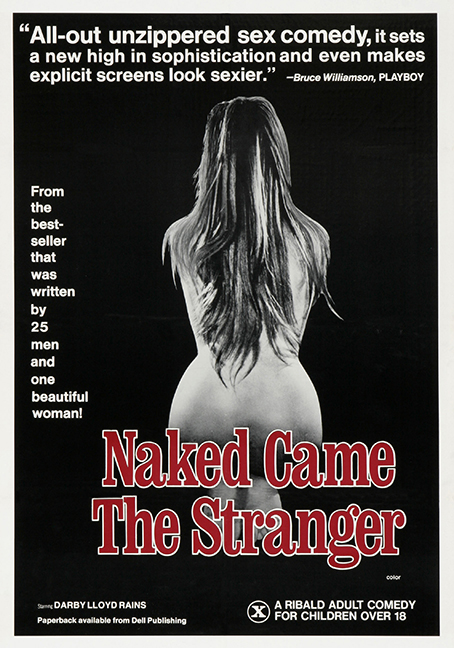 Radley Metzger’s film adaptation of ‘Naked Came The Stranger’
Radley Metzger’s film adaptation of ‘Naked Came The Stranger’
When Yannacone first floated the idea of writing a book with Linda Lovelace, McGrady wasn’t convinced. But like many others, once McGrady met Linda he was taken by her warm and authentic personality. So the two decided to jointly write Linda’s third autobiography and split any income that the book produced.
McGrady said the book was fairly straightforward to write – even if Larry Marchiano was a disruptive presence: Larry insisted on being there all the time, and McGrady had no choice.
If anyone was in any doubt as to the tone the story would have, the book’s title made the book’s content very clear: it was called Ordeal, and the majority of the book’s vitriol was predictably aimed at Chuck. It ended with the following cautionary note:
“How can you identify a Chuck Traynor? The answer: You can’t. It could happen to me and it could happen to you. I knew that God would one day show me the way to get away from Chuck and that’s what kept me going and accepting all the things that had happened. I put my faith in God and got through it.”
Ordeal-01.jpg">Ordeal-01.jpg" alt="Marilyn Chambers" width="454" height="648">
In painful detail, Linda described her abusive relationship with Chuck and how he coerced her into making ‘Deep Throat’ – but she expressed anger against other men in her life too. David Winters was described as someone primarily interested in her bank account, and Linda also apportioned some blame to Sammy Davis Jr., saying he used her and didn’t truly help her when she needed it most.
With the book complete, McGrady needed to find a publisher. He was turned down by over thirty who clearly didn’t have the stomach for a story of sexual violence against a porn star. He finally got some interest from a company called Citadel Press. The Citadel guys liked the story, but didn’t want to commit to publication unless Linda passed a polygraph test first. So a test was hurriedly arranged, and it was administered by a former FBI agent who had extensive experience in the field. Linda passed with flying colors.
Citadel were relieved and declared themselves to be fully onboard. They clearly felt that they had a potential sensation on their hands if they marketed it correctly, and so to prepare for the book’s release, the publisher leaked the contents to gossip columnist Liz Smith in November 1979, who started to whip up salacious stories in the newspapers.
When news of the book’s pending publication reached Chuck, he did two things. Firstly, he got his lawyer Phil Mandina to kick off a libel suit against Linda. It was an unsuccessful tactic: Linda’s attorney, Victor Yannacone countersued on Linda’s behalf seeking significant damages for kidnapping and bondage, so Chuck dropped the idea. Then Chuck decided if he couldn’t beat them, he could join them, so he contacted Mike McGrady to propose that Mike write Chuck’s side of the story. Chuck even had a title for it: ‘Training Women.’ McGrady couldn’t believe Chuck’s brazen attempt, and declined the invitation.
*
8. Chuck (and Marilyn Chambers and the General Public) vs. Linda (and the Feminists)
And so, in January 1980, ‘Ordeal’ was finally published. To help sell the book, Linda went on several TV talk shows to promote it.
Question: “Why would Chuck Traynor always have to involve you with people that he would want to be involved with. Have you ever thought about that – why he couldn’t simply leave you at home?”
Linda: “No. I was an object to him. I was what he considered the most perfect woman. A superfreak, always wanting to do some kind of perverted sex.”
Linda didn’t expect that she’d be met with universal sympathy, but she still had a rude awakening. As she shared stories of her abuse at Chuck’s hands and its role in her porn participation, she was met by victim-blaming masked as skepticism.
Question: “I had always heard that to be hypnotized you had to be willing?”
Question: “Is there something about the way you were raised that made you vulnerable to this?”
Questions: “I still find it very hard to believe that you have become a changed person?”
Question: “I can’t understand how you were forced into it through lust. How the hell did you manage to smile?”
Linda: “I wasn’t forced into it through lust. I was forced into it through daily beatings, physical beatings, physical abuse. It became a choice – smile or die. And I decided to live.”
One particularly dated example of the way Linda was treated occurred on Phil Donahue’s interview show which aired on Valentine’s Day in 1980. Donahue set the tone by calling ‘Ordeal’ “the grimmest book I’ve ever read in my life.” After Donahue interviewed Linda, his audience began aggressively questioning her claims. Donahue summed up their doubts, saying:
“The audience is having a hard time understanding how you could be so helpless. You’re blaming other people and not taking responsibility on your own.”
Linda was disappointed but unsurprised at the audience’s response. She told a journalist:
“I expect people not to believe me. Catholic girl, policeman’s daughter, living in a house where the pin money came from Tupperware parties. The easiest thing for people to do in society when faced with something unpleasant is to say, ‘I just don’t believe it.’”
Some people saw what was happening and weren’t as willing to accept this type of reaction. They sided with Linda, and one of them was renowned feminist and publisher Gloria Steinem who reached out directly to Linda.
Interviewer: How do Linda Lovelace and Gloria Steinem join forces? How do the two of you get together?
Gloria Steinem: I saw Linda on the Phil Donahue show and she was being questioned by Phil – who I think usually is a more sensitive questioner than he was this time – and by the audience with enormous disbelief. And yet she was still being asked what in her background had led her to become essentially a hostage.
Interviewer: What did lead you to become a hostage if we can now ask the question – does it go back to your childhood that you were a susceptible person?
Gloria Steinem: But see now what you’re doing…you’re doing what made me so angry. We don’t say to the hostages in Iran what in your background led you to be in that embassy…
Interviewer: But the situations aren’t nearly comparable, Gloria.
Gloria Steinem: They are. It’s force.
Steinem introduced Linda to fellow feminist Andrea Dworkin who in turn introduced her to Catharine MacKinnon. Dworkin and MacKinnon were founding members of an influential organization called Women Against Pornography. The group believed all pornography exploited and oppressed women, and so they worked to educate the public and lobby politicians about its dangers.
The irony was that when Dworkin and MacKinnon first met Linda, they too questioned her in detail about her version of the story. But their reason was different from the interviews that Linda had gone through: they were keen to see if there was an opportunity to take some kind of legal redress for Linda. Dworkin later recalled it was a difficult first encounter: “I want to tell you, you don’t want the two of us questioning you. It was another ordeal for Linda.”
The two feminists spent a good amount of time with Linda over the next couple of years before deciding to help Linda bring a legal claim against Chuck alleging that he’d violated Linda’s civil rights.
They wanted to start by enlisting Linda in an anti-pornography campaign, believing nothing could add more legitimacy to their cause than the world’s best known porn star denouncing the industry. The problem with this tactic was that Linda hadn’t exactly been an eloquent or staunch anti-pornography crusader so far. Don’t forget, this was Linda in an earlier interview at the height of her fame:
“I don’t think anybody should regulate anything. I don’t believe in censorship…That’s taking away your freedom. That’s taking away your individual right to make up your own mind for things. And the last person that started censorship was Adolph Hitler, and look what happened there.”
Now however Linda had to change her tune, but what’s interesting is that at first she didn’t so much blame pornography but rather, she said her issues were Chuck’s fault. Here’s Linda being interviewed by chat show host, Tom Snyder:
Tom Snyder: “What about some of the people in the pornographic industry? I’ve had them on this program, Gerry Damiano has been on this program, Al Goldstein has been on this program, Hugh Hefner has been on this program, Larry Flint has been here. And they all talk in lofty terms of the First Amendment, the public’s right to see, representing the kind of entertainment that a certain segment of the population wants. And when you sit here and talk about it, it’s very sterile, it’s antiseptic, and it sounds good. Speaking generally, what kind of people are there in the pornographic industry, what kind of values do they have, and what kind of men and women are they?
Linda: “Well, I can only really relate to Chuck Traynor. If he’s an example of the typical pornographic people, I don’t think they really have the right or the mentality to make the decisions of what’s healthy for the public to view.”
Eventually MacKinnon and Dworkin convinced Linda that they needed her support if anti-pornography legislation was going to help other women avoid the abuse Linda had endured.
So Linda changed her position again, and this time, expressed a new more anti-pornography stance:
“Most people in the States or probably even here don’t really know what goes on in pornography. And I felt it very important to take a stand and let people know that pornography was not a victimless crime, and to speak up and set the record straight as to what happened to me.”
The feminists declared themselves happy with Linda’s support.
Andrea Dworkin: Well initially her role was to be an apologist for pornography and to make people believe that women liked it and had a good time in it. And her repudiation of that really tore open a window into the world of pornography that most people had never had before.
Susan Brownmiller: It was amazing to us because you know we had our feminist theory, our feminist analysis, and it’s one thing you know to hear from a feminist who’s saying these women aren’t enjoying this at all – they can’t possibly be, you know? And it’s quite another thing to see such a famous figure of the pornography world come forward and say, “I did not enjoy it. The whole thing was a lie.”
Ultimately however the case that the Women Against Pornography group had hoped to bring against Chuck was shelved when they felt it would be too difficult to win.
Meanwhile, in the face of Linda’s public appearances, a number of women who worked in adult film came forward to defend the industry. Some, like adult star Gloria Leonard, called Linda an “Aaron Burr” who did a “traitorous turn to the adult industry.” Others, like porn film performer and producer Candida Royalle, aimed their anger at Women Against Pornography: “It infuriated me that Women against Pornography would take this deeply troubled, traumatized woman and just basically use her for their movement.”
Everyone will have a different opinion on the views expressed, but at the end of the day, there was no doubt that the controversy was great for Linda’s book sales. ‘Ordeal’ made it to the New York Times bestseller list and provided Linda with some much-needed income. And predictably, the book’s success spurred her and McGrady to write a follow-up autobiography a few years later, this time titled Out of Bondage. McGrady was honest about the reason he got involved again – and it was all related to money: “Because the first book had done so well, it was like when someone does a movie and it makes a hundred million dollars, they want to do a part II. That’s pretty much what happened here.”
If anything, ‘Out of Bondage’ went further than ‘Ordeal’: instead of just focusing on Linda’s abuse at Chuck’s hands, this time she also strongly denounced her participation in the adult industry, a theme reinforced by the fact that Gloria Steinem wrote the new book’s Foreword. But even Steinem’s name couldn’t do much to drive book sales this time. The reading audience recognized it was largely a rehash of her first effort with McGrady, and ‘Out of Bondage’ was only a modest success at best. It seemed like the public had finally tired of Linda’s story.
And what about Chuck? What did he make of the fact that Linda was raking him over the coals in a bestselling book years after they had split up? Chuck viewed most situations in terms of whether he could make money from it, so his first reaction was to book himself and Marilyn into multiple interviews across television and print.
When asked about the fact that Linda was now repudiating the adult film business, Chuck brought up Linda’s pliable nature:
“I have no idea what she said or how she campaigned against porn. I think it was totally ridiculous that she did it. I don’t know who she was trying to please. She was traveling in a different circle, different people. Meeting different people, “oh, now could you do that.” And, you know, particularly when she got in with the women’s libbers – which I think they should all be bent over the London Bridge. But um, I think that’s what the problem was.”
Regarding Linda’s continued allegations that he abused her, Chuck stuck to his usual defense in a pretty vicious interview with Al Goldstein:
“Well I was the dominant figure, she was a submissive figure. So if it reached a point where dominance had to take over then dominance took over. She was pretty dumb. So everything she did she had to be told how to do it and when to do it and why she was doing it. It just kind of rolled along like that.
“If you threaten somebody and you pick up a phone there’s a thing called aggravated assault. Conspiracy to commit aggravated assault. She knew that. Like I said, I never got arrested for anything.”
Al Goldstein: “Chuck, you are famous in so many ways. The real word is infamous. And every time I debate this Page Mellish who’s a feminist, every time I go against say Susan Brownmiller, Andrea Dworkin, Gloria Steinem, all these feminists who salivate at the sight and the thought of a cock or of people fucking and liking it. Your name is used. You are Freddy. You are the boogeyman. You are everything vile and conner to those feminists. Now, I know you think they’re right as I do. The real point is that in Linda Lovelace’s book “Ordeal”, you are held out as a book and wild, as a Nazi, as the bitch of book and wild, as everything vile because you made Linda Lovelace enter the world of pornography. You beat her. You kidnapped her. Would you give us your response to all these charges I’ve heard leveled against you for years now?”
Chuck: “Well, I’m probably guilty, I guess. I don’t know. Her and I got along good until she met a fellow named David Winters, and then David and Linda got along good until she met somebody else, and it just kinda moved from one to the other…”
“Linda of course I guess decided to capitalize. She tried to stay in the business for a long time after her and I broke up, trying to make herself a big porno star. When that didn’t work, I think she just decided to join the other team. And so you know she says what people want to hear and the people that want to believe it believe it. And the ones that don’t want to believe it don’t believe it. And there’s a middle group of people that call me up and say ‘I’m gonna send you my old lady for six months, get her trained.”
Al Goldstein: This is Al Goldstein for Midnight Blue. Chuck Traynor is one of the stand-up guys in the business. Linda Lovelace and her book Ordeal who slams him is full of shit. Linda did what she did ’cause she wanted to, Linda will blame everybody for everything and never take responsibility ’cause she’s a little girl and a dumb cunt. And Chuck Traynor is a real man.”
While Marilyn Chambers never went after Linda as personally as Al Goldstein did, she was on hand to vigorously defend Chuck. After all, she was asked, if Chuck had been so abusive to Linda, surely he must have been abusive to her too?
“For me, it’s been terrific, I wouldn’t be here today if it wasn’t for Chuck. And he’s about the nicest guy, sorry, Chuck to ruin your reputation, [chuckle] that I’ve ever met. And what Linda wrote, horrible things in her book about him. Personally, I’ve never met Linda, so I can’t say too much against her, ’cause that wouldn’t be fair. But from what I know and the people that knew them when they were together, none of it is true.”
So was Marilyn standing by her man because she was being coerced, the same way Linda had been when Deep Throat was released? Or would she too live to regret knowing Chuck?
marries-Marilyn.jpg">marries-Marilyn.jpg" alt="Marilyn Chambers" width="648" height="599">
*
Find out next time on the seventh and final episode of Svengali – The Chuck Traynor Story.
*
The post Svengali – The Chuck Traynor Story: Part 6, The Marilyn Chambers Years, Podcast 136 appeared first on The Rialto Report.
F.M Bradley died last month just a few weeks shy of his 70th birthday.
I can’t say I was surprised – Bradley had been in a nursing home ever since I found him in 2021 after years of looking. He was bedridden, and we had a few false starts before we finally settled down for our interview due to his ill health. But even though he was unable to walk, whenever we’d video chat it was easy to see the handsome, strapping man who’d made hundreds of films and loops back in the 80s.
After our interview, we kept in touch. I’d occasionally send him the Chips Ahoy chunky chocolate chip cookies he loved. He wore an expression on his face more like that of a young man at the beginning of life versus a patient on the precipice of his end. Bradley talked about making an adult film come back when he got out of the care facility, convinced he would in fact get out and get back. He had someone he called his lady friend who visited him regularly even as his Russian roommate blared his TV 24/7. Bradley had his down days, but mostly he was a man of hope – just as he’d been all his life.
I often start a Rialto Report excited to hear how someone felt and what they thought when they got into the adult business, but soon become even more interested in their life now – how they’ve carried their choices and experiences and make sense of them today.
It was no different with F.M. Bradley. We titled his interview ‘Hiding in Plain Sight’ because while nobody seemed to know where he was, Bradley certainly wasn’t trying to hide. In fact he occasionally attended adult events, trying to launch his comeback.
We may not be able to see Bradley now, but we can always remember him. So let’s do that.
-April Hall
The episode running time is 90 minutes. _________________________________________________________________________________
F.M Bradley
Let’s admit something: as much as the so-called golden age of adult film was a glamorous era, where sex movies competed with Hollywood blockbusters in theaters across the country, it wasn’t the most racially diverse workplace for a male performer.
There was Johnnie Keyes, the African American star of Behind the Green Door in the early 1970s. There was Billy Dee, an accomplished mixed-race actor, who became a well-known face in the late 1970s.
And then… that’s about it. Which is striking for a new industry that employed hundreds of people and made millions of dollars.
In the 1980s, this trend continued. Which made someone like Field Marshal Bradley stand out.
The Field Marshal, who went by the name F.M., was a towering presence. He looked like a black superman. A striking figure of strength. He displayed a muscular, cut body that always seemed shiny. He was the number one star of color, when that should have meant a lot more.
Over the years, I’d heard stories about F.M. Bradley. He was the eternal bad boy, living out a wild life. He’d occasionally turned up at conventions saying he was about to make a comeback in the business. He didn’t seem to have a permanent address, and no one had his contact details. Many doubted he was still alive.
And then I heard he’d been spotted – in a convalescent home in Vegas. Struggling with ill-health. He wasn’t even well enough do an interview. But we kept talking over several years, and eventually recorded an interview.
Now this particular convalescent home wasn’t well-equipped for interviews with stars of the X-rated film industry, and so our conversation took place with the TV in the background, and people coming and going. We’d get interrupted constantly – such as when it was time to for F.M. to give his dinner order.
I wanted to know what it had been like to be one of the few male performers of color in the 1980s. Where had he come from, and what was he doing now? And why was this one-time Superman now in a home?
This is April Hall – and this is The Rialto Report. It’s not every day I get to interview a Field Marshal.
FM-Bradley-ACR-8703.jpg" alt="F.M. Bradley" width="648" height="447">
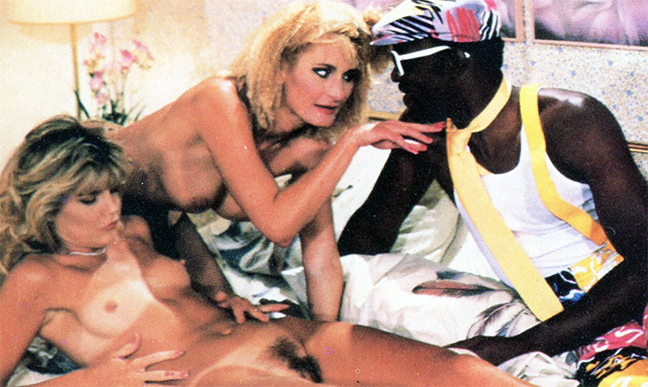
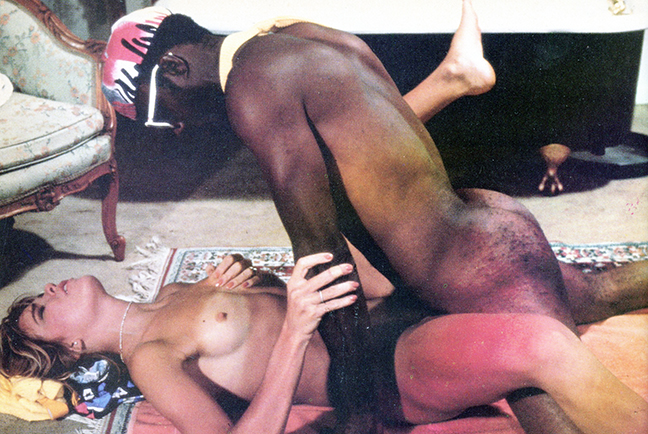
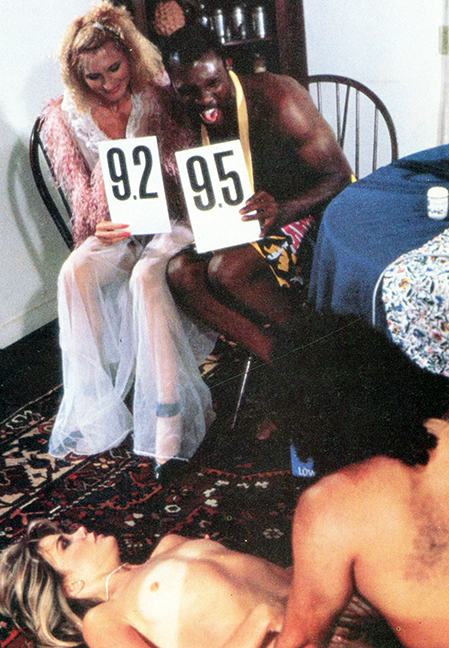
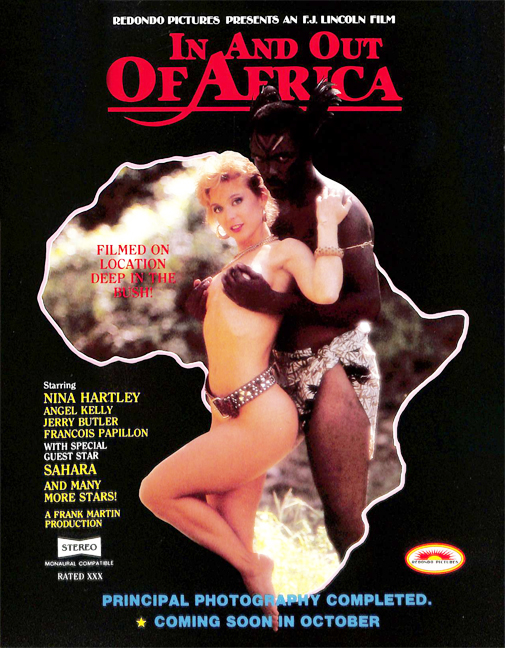
FM-Bradley-4.jpg" alt="" width="393" height="648">
FM-Bradley-Cinema-Blue-1087-01.jpg" alt="" width="437" height="648">
FM-Bradley-Satisfaction-Jackson.jpg" alt="" width="412" height="648">
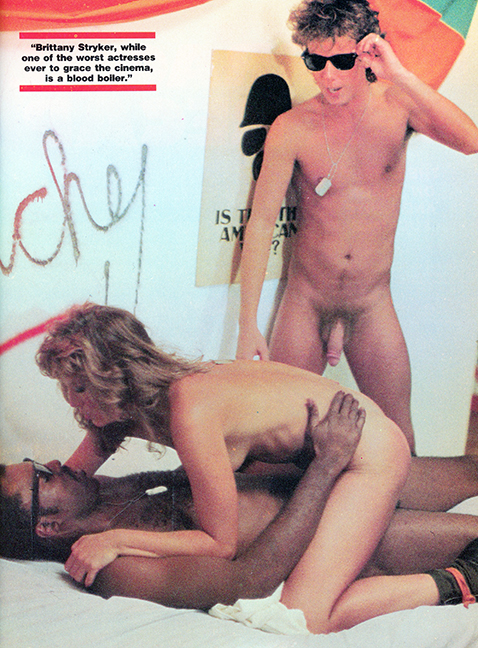
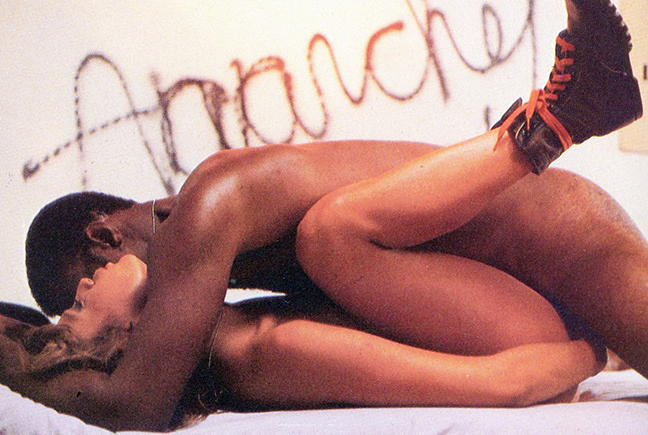
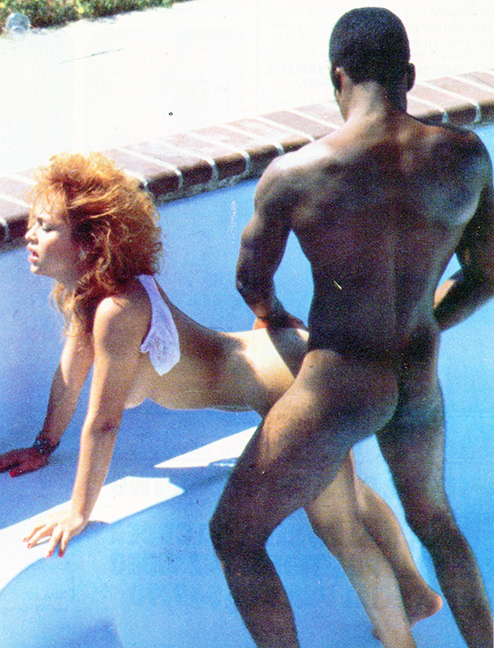
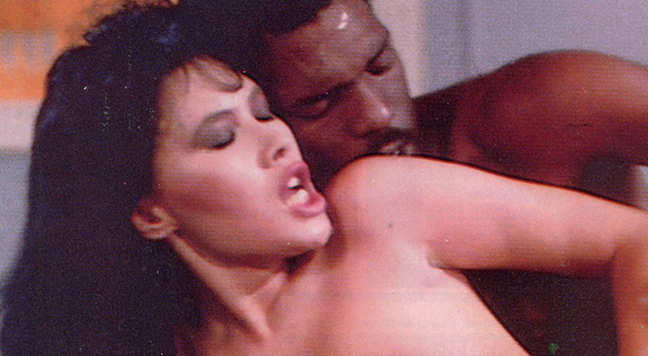
The post F.M. Bradley: Hiding in Plain Sight – Podcast 113 – Reprise appeared first on The Rialto Report.
Michael Findlay was a young New Yorker, fascinated with film and the mechanics behind it.
Julian Marsh was his alter ego, a movie director possessed with a singular twisted vision.
Richard Jennings was a sadistic, deranged movie character, one-eyed, confined to a wheelchair, and hell bent on revenge.
The films Michael Findlay made seemed to be so single-minded, unique, and personal, that they begged the question, how much were these three characters actually the same person? And what role did Roberta, Michael’s wife and partner, play in making the movies?
In the last episode, I spoke to Roberta to find out how her early life shaped her. Was there anything in her background that explained the Flesh trilogy, the black and white 1960s sex and sadism films that they made? I learned of her insular Jewish upbringing, a violent father, pressure to become a concert pianist, and an abusive relationship with a psychologist. Roberta minimized her actual involvement in the films, insisting that any role she had was somewhere between coincidental and non-existent, but questions remained.
So who was Michael Findlay? What shaped him, what was the damage in his past that Roberta referred to, what caused it, and how much of it resulted in the films that he made?
This podcast is 36 minutes long.
—————————————————————————
Someone once said that if you want to reveal the truth, you write fiction. But if you want to tell a lie, you write a biography.
So how do you start to tell someone’s story who you’ve never met and has been dead for almost fifty years? How do you get to know them, understand them, and get inside their aches, drives, and desires?
Start with the basic facts. Establish an overview of a life like a chalk outline of a dead body at a crime scene. A silhouette profile that establishes what is already known.
Michael Findlay was born in 1937 in New York. He made a number of notorious 1960s low-budget movies that combined sex and violence in imaginative and sadistic ways. And he died in 1977 when he was decapitated by a helicopter on the roof of the Pan Am Building in Manhattan – a grotesque end that could have come straight out of one of his films.
After the basic facts, dig deeper into echoes of the past. Chase memories, the architecture of our identity. After all, the life of the dead is placed in the memory of the living. So seek the survivors, anyone who guards recollections that may reveal deeper truths.
In Michael’s case, few people remain who knew him in his formative years, and some of those who still live choose to preserve their silence: many years have passed after all, and for them, the past is a silent setting, a place of reference not a place of residence.
But keep looking, ask enough people, and a story emerges.
*
Michael Findlay was born in Manhattan on August 27, 1937, just a short distance from Roberta, his future wife’s childhood home in the Bronx. In truth, it was a million miles away from her airless, bookish, piano-playing, indoor Jewish upbringing.
Michael was the product of a Celtic union: his father, James Findlay, was a Scot, a tall, good-looking bear of a man, born in Aberdeen in 1900, and product of the local, hard-scrabble shipbuilding yards on the cold, eastern coast of the land. Findlay senior, charming, outgoing, and popular, had little schooling but was keenly intelligent, a reader, and a collector of intellectual ephemera. Later in life, Roberta remembered him polishing off the daily New York Times crossword in under ten minutes, a source of amazement to her as she needed at least thirteen.
James spent his youth traveling the old country in his tartan, avoiding conscription to the Great War, taking hard labor temporary jobs, and dreaming of a better life. In his late teens he ventured over to Ireland, and, in the town of Kilkenny, he met and fell for Ellen Delahanty. Ellen was a strict Catholic girl from a strict Catholic family. The message to James was clear: any form of relationship with her was strictly off the table unless his intentions were serious, honorable, and permanent. James’ love for Ellen left him with no alternative, so in 1922, they were married.
Job opportunities for the newlyweds were scarce, both in Ireland and over the sea in England where “No Irish, No Blacks, No Dogs” would become less a racist preference and more of point-blank threat. In the late 1920s, the young couple were tempted across the ocean to New York lured by the promise of a new life in the Empire City: their timing was dramatically imperfect – they were greeted by the 1929 stock market crash followed by the Great Depression – and James ended up a lowly janitor for a succession of Upper East Side apartment buildings for the rest of his life.
The Findlays settled in an uncomfortable co-op townhouse at the unfashionable end of East 65th St in Manhattan. It was rent-free because James was the building’s super, but the downside were the cramped rooms, barely bigger than closets. Compounding the chronic lack of space, Ellen then gave birth to three tall, strapping sons.
Just like Roberta’s family, the first two came in quick succession: the elder, James (who went the name ‘Bob’ to differentiate him from his father) and Gordon. Let’s cheat and fast forward a lifetime: they came from the same family as Michael, so what happened to them?
Bob, the eldest, is described as “the strangest, craziest member of the family, of any family” by one friend I spoke to. Bob would train as a priest, drop out and marry a quadriplegic, paralyzed in her arms and legs and confined to a wheelchair for life, and he then become the head of a notorious mental institution in Westbury, Long Island. Asked about the place he ran, he would crack, “The only thing that makes me different from the nuts in this place is that I sit behind a desk.” Today, as he approaches his 100th year, he lives in a nursing home. He is unsparingly friendly until asked to discuss Michael or re-visit his family’s early years.
Fast forward through another lifetime: Gordon, the middle brother, would become a brilliant chemist with an accomplished career ahead of him, but he died mysteriously while still in his forties. No one talked about Gordon after that, airbrushed from existence, and long forgotten in today’s world.
Which leaves Michael, born a few years after his brothers, a solitary, virtually only-child: “6’ 2” and still the smallest of the three,” says Roberta. “The runt of the Findlay family. Not my words,” she adds, “that’s what his own family called him.
“And he was damaged too. But whatever that damage was, it happened before we met.”
*
In truth, Roberta knows little about Michael’s early years. She never probed, he never volunteered, and their relationship was based on navigating the dangers of each day. After several months of chasing dead ends, I find someone who did know Michael. Roy is an aging ex-schoolfriend of his, and what’s more he says he remembers Michael well. So I call him, and we meet up.
Roy is a thoughtful, sober, and dignified man, a retired college lecturer in American history. It’s been decades since he stood in front of a class, and he’s frustrated that he’s lost the easy fluency of speech that once informed his classes. Today he speaks carefully and slowly but it’s clear that Roy still remembers Michael well. I complement him on his powers of recollection: “Memories remain crystal clear if you spend a lot of time dwelling on them,” he says.
But Michael died in 1977, I suggest. Why is he still on your mind?
Roy sighs. “I think of the past because most of my life is there. And Michael… he weighs heavily on my heart.”
Roy has brought a faded picture of Michael to show me. Michael as a teenager, looking twelve or thirteen going on 48. He’s wearing an old-man flannel suit that hangs redundantly off his apologetically tall frame. He has kind, self-conscious eyes and is smiling broadly, which surprises me. I realize I haven’t seen many pictures of Michael smiling. I ask Roy if that is how he remembers him?
“Mike was good company, sweet and gentle,” Roy says. “He was a happy-go-lucky kid and sunny, a big heart and a big laugh. He didn’t have a care in the world.
“For years, we were inseparable: we sat next to each other in school, walked home together, and played in the street. It was a typical New York upbringing: we opened fire hydrants on the street in the summer, climbed trees in the park in the fall, and made snowmen on street corners in the winter. Cliches, I know, but true. Sure, we got into trouble, but we were kids having fun.
Roy smiles: “In fact, we were arrested once: we lived near a pharmacy owned by an angry Ukrainian called Bohdan who had a prosthetic plastic arm. He’d lean on his countertop and this false arm would bend like a bow. That fascinated us, and we stared at it for ages. That’s what passed for our TikTok entertainment back in the day, I guess.
“Bohdan was also blind in one eye, and it was covered by a large, black pirate patch. Michael noticed that if you did something on his left side, Bohdan wouldn’t notice it on account of his partial blindness. So we took advantage and swapped around all the product in the store: we’d move the men’s hair pomade to the women’s perfume shelf and so on. One day, a cop saw us and hauled our asses down to the precinct. Michael took it all in his stride, enjoying the experience as if we were on a day trip to the beach. Afterwards, he said, “When you’re thrown in jail, a good friend will try to bail you out. But a best friend will be in the cell next to you saying, ‘Boy, that was fun!'” I think he stole that from the Marx brothers, but it made us laugh. Michael was funny like that. And all his eccentricities and quirks made him amusing and popular in our group of friends.”
I’m intrigued by the mention of eccentricities. I ask Roy if he knew much about what shaped Michael: “The church and his mother shaped him, I know that. We all saw the effect that they had on him.”
I press him: “His parents were sweet and kind. Everyone liked Michael’s father. His mother was fine too but she was religious. Man, was she religious. She was a fierce Irish Catholic. The family had a big portrait of the Pope in their apartment. It hung over their dinner table. She told the boys that the Pope was watching them all the time. Mike believed it too. It freaked him out. I remember him once or twice saying that he’d let the Pope down because of something he’d done.”
How did the religion affect his everyday life? “Ellen wanted all her sons to become priests. Michael’s brother, Gordon, wasn’t interested because he had his eye on being a scientist. But she persuaded the other two, Bob and Michael, that devoting their lives to God was their duty. An absolute duty. She talked about nothing else.”
How did Michael react to that?
“He accepted that the church would be his future. He wanted to please his mom and he did everything with a shaggy dog enthusiasm, happy and clumsy.”
So church was his life?
“Yes. It felt like the only time we were apart was when Michael was in church. My parents weren’t strict like his, so I went to church but not as often as Michael. He spent Sundays in church, Wednesday and Friday evenings in church, and then on other days, he had Bible class, catechism, choir, you name it. There was always something.
What was the family household like?
“They lived in a claustrophobic, cramped, and dark apartment. On top of that, his mother had a couple of sisters who came over from Ireland. They were nuns. And lesbians. Heavy drinkers too. One of them worked in an all-girls private school in Maryland. She always seemed to be drunk. They often stayed in the Findlay’s tiny apartment.
“We thought it was hilarious because they’d both chase Michael around and they’d terrorize him. They’d tell him he was bad and that the Pope was going to get him. He was scared of them, but he was also fascinated. It was the combination of their physical threat and their mysterious sexuality, I guess. He obsessed over them, not understanding how such holy people could act like that. Sometimes it got too much for him, and he was wary of going back to the family apartment.”
What did he do to escape?
“We hid out in the movie theaters. We got to know them all – as well as all the ticket sellers and ushers. They’d see us coming and smile. Even let us in free sometimes.
“That changed his life. He became obsessed with movies. Some days we’d skip school and see four or five different films in a single day. That wasn’t uncommon. The movie theater was our living room, our bedroom, our sanctuary.”
What kind of films did he like best? “Anything. High-brow, low-brow, Michael treated every film the same. He always chose which films we’d see. He’d go to the big theaters and see the Hollywood new releases, and the smaller theaters with the imported subtitled European films. He even went to the downtown movie houses in Chinatown where the films were in Mandarin.
“He had a memory like a database for those films. He read all the movie magazines. Every detail was stored away. I remember once going to see a movie with him that he’d already seen, and I noticed he was already repeating the dialogue back under his breath. He was almost autistic like that. Movies made him happy.
“So I’m thinking back to your original question: Yes, I remember Michael smiling a lot. That was Michael when he was a kid.”
*
It seemed to me that Michael’s childhood up to this point was reasonably typical of a kid growing up in Manhattan in the 1940s and 50s. Sure, there was the pressure to become a priest, an obsessive-compulsive interest in films, and a chaotic, crowded home to deal with, but his parents were caring and kind, he had close friends, and so was it really any more dysfunctional than many other kids in the city at the time?
And then I remember Roy’s comment when I first spoke to him: “Michael still weighs heavily on my heart.”
I email Roy again and ask him what he meant by that. He replies a few days later, and this time his words have a different tone.
“I don’t know how to tell you this,” he writes, “but I wasn’t entirely truthful the other day. That is, all of what I said was true. Our friendship. His family. The Catholic Church. The movies.”
Roy continues haltingly: “I’m going to write you a letter. I’ll explain there. I’d rather not discuss it on the phone. To be honest, I don’t much want to revisit it all. It’s not my story to tell. But your interest in Mike seems serious, and so I feel like you should know. You can disregard what I tell you or use it in any way you want. But after that, I don’t mean to cause offense, but we don’t need to speak again.”
I write back to Roy. I’m not sure I understand.
His response: “It’ll be in the letter. I’ll give you a couple of other names. You can speak to them. But that’s all I can do. I’m sorry. It’s been more painful remembering than I expected.” His words trail into silence.
*
After waiting for weeks, I begin to give up hope that I’ll hear from Roy again. Then his letter arrives.
He writes a polite opening. And then:
“Like I told you, I knew Michael from an early age. He was a happy kid and we were tight. That much is true. At least at the beginning.
“Then one day, Michael seemed subdued and sad. He seemed to have changed overnight. It was unlike him, and his dark mood continued for weeks. It was difficult to ignore, and, if anything, it got worse. It was like I’d lost my old friend. We were young, so I didn’t have the skills to talk to anyone about the transformation that I noticed in him. Eventually one night, I can’t remember where we were, I told him he was no fun anymore. I said he’d become silent and grumpy. I might have said he was boring too. I didn’t mean any harm, but he started to cry. I’d never seen that before. I immediately felt bad for raising it. I didn’t know what to say, so I didn’t say anything at all.
“Nothing changed. A while later, we’d made a date to go to the movies. I watched him walk down the street. I could see him arriving long before he got to me. He was tall for his age. And wiry thin. He wore ill-fitting clothes, probably hand-me-downs from his older brothers, and he appeared completely ill at ease with his lumbering teenage frame. He emanated a profound melancholy. It was like a spell had been cast on him.
“That night, we were sat in the park. He turned away from me so I couldn’t see his face. He started talking. He said that a few months before, he’d been away in upstate New York on a camp arranged by the church. He told me about a priest called T, who was one of the camp counselors. I knew T. He worked at the church we attended in New York. Michael said T started to be kind to him when he was at the camp. Extra kind. He took Michael aside and asked him about school, movies, everyday things like that, anything Michael was interested in. Michael said the priest found ways to be alone with him.
“After a few moments of being quiet, Michael just said he couldn’t understand how a priest, a man of God, someone who had taken sacred vows, would do that. He seemed lost in the moment.
“Michael didn’t say much else after that. He didn’t need to. Even though I was young, way too young to understand, I somehow knew what he was trying to tell me. I just knew. It made me feel uncomfortable. But I never did anything about it. Never told anyone. Never mentioned it to anyone. Never anything. I regret that. I still carry that regret with me all the time.
“After I became more distant from him. Not through my choice. Michael just pulled away. It seemed to me that now that I knew his secret, perhaps he saw me as part of the problem. He started to hang out with other boys. Boys that were older and did different things.
“We still went to see films though not as often as before – but now, the theaters were more than just a refuge from everyday life for him: they replaced his real life. The films we watched had gone from being his escape to become his reality.
“Michael still chose the films we watched, but they were different now. I still remember the movies he obsessed over like it was yesterday: ‘The Postman Always Rings Twice,’ where Michael lusted over Cora Smith’s bare midriff. ‘Red Dust’ where Cary Grant has a sexual affair with a prostitute, Jean Harlow. ‘Ball of Fire’ where Barbara Stanwyck plays a racy burlesque dancer. ‘Safe in Hell’ about a New Orleans hooker who kills the man who forced her into sex work and then fights off a group of lecherous escaped convicts. And instead of talking about the films afterwards, now he seemed embarrassed when they were over.
It wasn’t difficult to see what these films had in common. Michael had become obsessive about sex, and guilty about it too. It seemed to create a conflict inside him that he found hard to manage. It went beyond just a teenage compulsion. He seemed to be consumed with the fact that beautiful, promiscuous, and sexual women – prostitutes and strippers – were in front of him, yet out of his reach. Maybe it something to do with his commitment to the church, I don’t know.
“One moment sticks in my mind: I remember sitting with Michael and some friends in a soda shop. He was swaying in his seat, describing in forensic detail the contours and shape and texture and beauty of Lana Turner’s breasts as they pressed provocatively through her sweater. It was a tender though desperate description. He went on for ages, off in his own world, oblivious to anyone else, caught up the reverie of his lustful description. Everyone found it funny, but looking back, I feel uneasy.
“I only ever had one more conversation with him about what had happened at the camp: I asked him if he ever told his parents. He looked at me with horror. He said, No – he could never become a priest if they found out.
“I asked him if they ever suspected something was wrong? Michael said they’d started sending him to a therapist and prescribed him Valium.
“Why they do that if they didn’t know anything had happened? I wondered. He told me they’d found some of his notebooks in which he’d drawn and written about revenge fantasies. Sketches of guns, arrows, knives, poison, he said. After seeing the sketches, they decided he needed help.
“I told him I was sorry that this incident with the priest had caused such suffering in his life.
“Michael just looked at the ground, and said, “Who said it was just one incident? Who said it was just him?””
*
In 1952, when Michael turned 14, he succumbed to his mother’s wishes and applied to Cathedral College, a seminary at 557-559 West End Avenue on the Upper West Side of Manhattan. It was, as its president, the Very Reverend John Hartigan described, “a very adequate” place for “any boy of good character and intelligence who feels he has a vocation to the diocesan priesthood.”
To be accepted to the college, Michael had to take an examination and present a letter of recommendation from his local church pastor. Neither proved to be a problem, and he was admitted quickly.
The Cathedral College program was based around four years of high school education followed by two years of collegiate studies. Michael wasn’t the first of the Findlay boys to start training to be a priest: by this time, his brother Bob was already attending St. Joseph’s Seminary and College in Yonkers, sometimes referred to as Dunwoodie, and considered the Harvard of American seminaries.
And so, Michael took the first steps of his journey to be a man of the cloth. Each day, he walked across Central Park with a bag of books extolling the virtues of faith, dogma, and most of all, celibacy, the sacred vow of abstinence from all sexual activity.
*
Sal was one of the names that Roy had sent me, so I called him. Turns out he was an older kid that Michael hung out with after Roy faded from his life.
If Roy was serious and sober, every inch the former academic, Sal is all-action and bravado. He’s a livewire: a conversation with him is like a two-dollar trip on the Cyclone, the accident-waiting-to-happen, ancient Coney Island rollercoaster that still stands just down the road from where Sal lives today.
For a start, Sal is louder than a Brooklyn subway car. And hard of hearing too, shouting answers in upper case decibels. At times I wondered if it would be easier for me to open my window and listen to his voice across the city rooftops. He insists his memory is failing: “I’m so old, three things have happened. The first is my memory is shot, and… I can’t remember the other two.”
His daughter had warned me that he was a talker and nostalgic for a time that interested no one anymore. Sal agrees: “If I want to talk with my friends,” he shouts, “I head for the graveyard. I don’t drink to forget… after the life I’ve had, I don’t have the luxury of forgetting. But I do drink.”
“Anyway, you’re calling because of that Flesh movie, right?” Sal says. “I was the guy who drove into Michael with my car in that movie. The accident that caused his character to be paralyzed. That was me! I drove the car in the chase scene!”
I tell him that I had no idea he was involved in any of Michael’s movies – and that I’d love to hear about it. First though, I wonder if he could describe what Michael was like.
“Sure,” bellows Sal. “I was about 17 when we first met. I’m a couple of years older than him – a big deal at that age – but I called him ‘Old Man.’ He quickly became part of our group of guys. What was he like? Lovable, a sweetheart, sometimes a little intense and complicated. All at the same time. Despite his issues, everyone liked him. When I first knew him, he’d just started attending this Catholic seminary on the west side, so it was strange for us to have a wannabe priest in our group.
“Most of all, he was shy. Awkward socially and physically too. He had anxiety attacks. They paralyzed him.
What would trigger them?
“He was afraid of walking on the wrong side of the street, afraid of roaches, afraid of mirrors, afraid of a lot of things. He was more nervous than a long tail cat in a room full of rocking chairs.”
It turns out Sal loves a metaphor. How did he deal with his fears, I ask?
“I know his parents made him go to therapy, he told me that once – but I don’t know if it helped. But he didn’t drink, and took no drugs – unless you count the Valium which he popped all the time.”
I ask Sal if he had any theories as to what caused Michael to have these issues?
“It had to be the Catholics. They got inside his head, and he felt guilty for every bad thought he had. And we all had a lot of bad thoughts at that age!
“But he was funny too: Michael once told me his dad reached over and covered his eyes whenever there was a racy scene on TV… because his dad didn’t want Michael watching him masturbate. That was his humor: dry and full of self-defecation.”
Self-defecation? I suggest to Sal that he means ‘self-deprecation’?
“Yeah, that too,” Sal agrees, perhaps oblivious to the difference.
I ask Sal about Michael’s interests.
Sal barks back immediately: “Michael loved strippers, especially ones with big tits. Blaze Starr, Tempest Storm, all the burlesque queens. Michael adored those girls. He venerated them. He’d make us go anywhere to catch Blaze Starr. Atlantic City, Philly, DC. All over. And then he insisted on hanging around the stage door afterwards, even though he was usually too shy to speak to the girls. He once got Blaze Starr’s autograph and you should have seen his face: he was happier than a midget at a mini skirt convention.”
Where did you all hang out together?
“We liked Times Square because there was always some hustle going on. Michael loved films and so did we, so we were often at the theaters. But we liked to go downtown too. The East Village especially. It was seedy and raw down there. We hung out at places like Rapoport’s or Ratner’s Bake Shop.
“For his eighteenth birthday, we thought it would be funny to take Michael to Club 82. It was a basement nightclub on East Fourth Street, just off the Bowery, back when the Bowery was spikier than a badger’s butt. It was tiny place that was nothing from the outside, but inside… it was wild. It had three shows a night, and the performers were all transvestites, men dressed as women. On top of that, all the wait staff were women dressed as men in tuxes. Not that it was a gay place. The opposite, in fact: it catered solely to straight people. Celebrities loved it: Liz Taylor, Judy Garland, people like that. We only got in because we knew the owner’s daughter. The owner was Anna Genovese, who was married to Vito Genovese – one of the original mob bosses in New York.”
I ask if Mike knew about the place before he first went in?
“No! That was the point.
“It was a smart joint, so we borrowed a jacket and tie for him to wear. We got him inside and the show starts. One of the performers, a big, knockout flamboyant character, came over and sat on Michael’s lap. Michael looked both terrified and happier than a dog with two dicks. Then the performer raised Michael’s hand to her chest, and he obviously felt something there that wasn’t quite right. Suddenly it clicked. He was terrified, mortified, horrified. We thought it was funny, but I don’t think we spoke about the experience after that.”
I asked Sal if Michael had a girlfriend in his teenage years.
“No. I don’t think so. I would’ve known. He was never interested in the girls in his neighborhood. He spent his waking hours dreaming of Lana Turner, dancers, strippers, and hookers. They were his dreams.”
The line went quiet, and then Sal offered a final memory.
“You know, we all went to a whorehouse one evening. I don’t remember whose idea it was, but there we were, and suddenly we found ourselves going in. It was summertime, one of those sweltering New York nights. This place was down on the Lower East Side. A building with lots of rooms, each with bed and a little sink in the corner. I remember, you had to pay for the room and the soap in addition to paying for the woman. Well, we all paired off with the girls and went to different rooms. I finished pretty quickly, and so went outside to sit on the sidewalk. Michael was already there. He looked sad. I said “Old Man… are you ok?” He just shrugged. He said that nothing had happened. He’d given it his best shot, but it didn’t work. Something was broken with him, he said.
*
I thought of the teenage Michael, of the contradictions and confused life he was leading. By day, taking classes in theology, divinity, and spirituality, he prayed, preached, and praised, and took vows of abstinence and purity. By night, he enjoyed a different type of experience. He craved sexual images on the big screen, adored strippers and dancers, and went to a cross-dresser club and a whorehouse.
If life can only be lived forwards, it can only be understood backwards. I’d wanted to understand Michael through the memories of others. But old memories are masters of deceit. Stories fade, adjust, and conform to what we think we remember. What to make about what I had heard?
Is that part of Richard Jennings, his fictional serial killer anti-hero, in Bohdan, the angry one-eyed store owner, or in his quadriplegic sister-in-law confined to a wheelchair? What about the nights inhabited with voluptuous strippers, lesbian aunts, and beautiful cross-dressers, or how about the guilty conflict wrought by religion and sexual frustration? And what to make of the abuse, damage, and violent thoughts of revenge? Did these seeds grow into the themes of his films?
The troubled lives of Michael Findlay and Roberta Hershkowitz were about to collide. Their joint story is about to begin. They had endured difficult childhoods as misfits, abused and confused. Their future films would, in part, expiate their troubles and obsessions. Their work would be different from anything seen before. What effect did they have on each other?
Go to heaven for the climate if you must, but go to hell for the company.
*
0001.png">0001.png" alt="Curse of her Flesh" width="648" height="489">
*
The post Flesh! The Untold Origin of the Findlays and the ‘Flesh Trilogy’, Part 2 – Michael’s story appeared first on The Rialto Report.
Sex and violence have been part of movies since the very beginning.
Ever since Thomas Edison made and exhibited ‘The Kiss’ in 1896, an 18 second clip of a couple embracing, moviegoers have been shocked by onscreen depictions of lust. The outrage over ‘The Kiss’ was understandable: it was one of the first films ever shown commercially to the public, and kissing in public was prosecuted at the time. The Catholic Church knee-jerked instinctively, and said it was a “serious threat to morality and humanity”, and the film was met with the first demand for movie censorship.
Fast forward seventy years, and heaven knows what they would have made of Michael and Roberta Findlay.
The Findlays made a series of low budget films in the 1960s that combined sex with violence in a way that had rarely been seen. Sure, filmmakers like Russ Meyer or Herschel Gordon Lewis had already achieved success with exploitation flicks that mixed fornication with ferocity. But their visions gleefully and comically satirized the genre.
Michael and Roberta were different: theirs was a more shocking, sadistic vision that left an altogether different impression. More than with any of their peers, you find yourself looking beyond their work, instead wondering more about the filmmakers than the films. In short, you start to ask, “What kind of people made these movies?”
Over the last few years, I’ve tracked down and spoken to friends, family members, collaborators… in fact, anyone who knew Michael and Roberta back in the 1960s – including Roberta herself – to dig deeper into who the Findlays really were and where they came from. The new information I found was surprising, unnerving, and sometimes disturbing – and it changed the way I view the films themselves.
This is Part 1 of ‘Flesh: The Untold Origin of the Findlays and the ‘Flesh Trilogy’’ – Roberta’s story.
This podcast is 36 minutes long.
———————————————————————————————-
Roberta Findlay walks into a midtown Manhattan bar.
Unruly dark mop, giant black sunglasses, scowling bad attitude. She looks like Bob Dylan in ‘Don’t Look Back.’ Or a microwaved Anna Wintour.
“I don’t like people,” is her opening gambit. “Especially not those who watch my sex movies. These people are creepy. With deep psychological problems.”
I’m lucky, I guess. I’ve known Roberta for years, and she insists I am one of her two favorite living people. I’m flattered until I learn that Dick Cheney is the other: “I like arrogant men who mistreat me” is her explanation.
Dick Cheney mistreated you? I ask.
“I can dream,” she grunts.
Today Roberta has decided to cement our friendship. She gifts me the copy of ‘Hollywood Babylon’ that sat at the bedside of her long-deceased husband, Michael. I’m strangely moved. This 1959 collection of crime-soaked, sleaze-boiled gossip from Hollywood’s golden age underbelly had been an inspiration to him when he first became a filmmaker in the 1960s. Their film titles bore the evidence: Satan’s Bed (1965), Take Me Naked (1966), The Ultimate Degenerate (1969), and the infamous Flesh trilogy (The Touch of Her Flesh (1967), The Curse of Her Flesh (1968), The Kiss of Her Flesh (1968)). Tormented black-and-white nightmares trading in imaginative, misogynistic violence. Kenneth Anger’s aesthetic updated to a low-rent 1960s New York tenement world.
Their movies found an audience, then as now. For a time, Michael and Roberta reigned supreme in grindhouse theaters as kingpin auteurs of low-budget east coast sex and violence. Their fingerprints were evident in every frame: they produced, directed, wrote, and acted in all their films. Michael even starred – as one-eyed, paraplegic serial killer, Richard Jennings, in the ‘Flesh’ movies.
Except that Roberta now disputes her involvement in these early operas of sadism. I point out that her name, or pseudonym, appears in all the credits. Furthermore, crew lackeys remember her shooting the films, and cast members recall her active involvement. Roberta waves away my persistence.
“I was adrift in that maelstrom. I was underage. I didn’t know what I was doing. I never knew what I was doing. I have no recollection of any involvement. Just leave me alone. I was young. Too young. Underage, in fact. You hear me? Underage.”
Not that Roberta is prudish. She admits to making a string of later hardcore sex films – without Michael – though she is quick to dismiss them: “I deplore anything violent, but sex… I didn’t care. I made the movies for money, and because I liked to shoot as a cameraman. That’s what I liked doing best: being behind the camera, shooting and lighting. That’s where I was happiest in life. I still miss it today.”
But I return to the question at the heart of their 1960s movies. The conundrum of her cinematic union with Michael. What kind of couple would make films that so single-mindedly focused on a such a twisted disturbance of revenge, murder, and sex? Was it merely a cynical commercial tactic? Or did it come from a deeper chamber of the soul?
Roberta is unimpressed by the query. Open-book self-analysis is anathema to her. Questions that probe motivation irritate. Her silent response smacks of annoyance, then defiance. I ask again. And finally, without warning, she opens up.
“What can I tell you? Michael was a troubled and deranged man. A cracked, overgrown man-boy. And I was damaged goods. Product of an isolated, difficult childhood. For a time, we only had one another. So we clung to each other. There was no calm, sensible person in our relationship, and therefore all our problems were amplified: all our scars, fears, obsessions, phobias, and neuroses. And we had a lot of them. We weren’t normal people.”
Let’s talk some more about that, I suggest.
*
When were you born? I start.
“That’s an indiscrete and ungentlemanly question,” comes the reply.
I apologize. How old were you in 1962 then?
“That’s the same question – with a tricky calculation. I can’t do math. And I can never remember my age.”
All the interviews with you, going back to the early 1970s, say you were born in 1948. On December 30th. But I’m not sure that’s correct.
“December 30th? Yes, that’s right.”
But what year?
“Oh, I don’t know. I’ve forgotten over time. Why is this important anyway?”
Because you said that you were underage when Michael and you made your first films. So I want to figure out the timeline.
“Let’s say I was born in 1948 then. And move on.”
Here’s the problem I have with that. I have production records from the first film that you appeared in. Body of a Female. That film was shot in the summer of 1962. You had several nude scenes in it. But that would mean you were only thirteen or fourteen at the time of the shoot.
“I don’t know anything about that. I was underage when the ‘Flesh’ movies were made. That’s all I know. That’s why I know nothing about them. I was underage. Now leave me alone.”
*
Rubeena Hershkowitz (no middle name was necessary as it was already a mouthful, she says) would have been known to her goy friends as Roberta, except that she had no friends. More on that later.
She was born in the Bronx to Hungarian Jewish parents. In an undetermined year.
Moses Aaron Hershkowitz was her father, and a mean villain. “An evil man. He didn’t like anybody,” Roberta says. “And in return, nobody liked him.” What Moses lacked in charm and warmth, he also lacked in humility and generosity. Born into a family in rural Hungary with nine brothers and sisters, he stood out from the wolf pack by his street-smart intelligence and angry belligerence, a combination that did him little good. At Yeshiva, the rabbis beat him regularly for his back-chat and bad attitude.
“He was obstreperous and rebellious,” says Roberta, “as well as a violent agoraphobic who suffered panic attacks in crowds. I saw his first passport photo once: he was very good-looking as a young man, devilishly handsome, with a large mustache. But boy, he was bad.”
Moses dealt with his frustrations by becoming a small-town bruiser, part-time rat-catcher, and quick-fire brawler. When he was twelve, he ran away from home. Roberta remembers family lore about his vanishing act: “Apparently, he did some stuff and had to flee. I don’t know what it was. I have no idea. But that’s the story.” Moses returned home several years later at seventeen, only to be greeted by his mother’s withering contempt: “Oh, look, he’s back. And this time, he’s brought a little suitcase.”
He was also cursed with a spectacular lack of respect for authority. When conscripted into the Hungarian army, Moses shot himself in the foot, literally, to avoid serving. Instead, he shacked up with a local woman, Matilda, and they had two sons, Maximilian and Alexander. But familial responsibilities failed to hold his interest, and at 19, with a feral reputation and one functional foot, he limped away. In the late 1910s, he slipped into neighboring Romania, somehow acquired a passport, and headed north until he reached the German port of Hamburg. There he boarded an ocean liner, The Leviathan, which set sail for New York. He never saw his parents again, disappeared or liquidated by the Nazis in the years that followed.
*
“This isn’t working,” Roberta flatlines.
What do you mean? I reply.
“It’s boring hearing about anyone else’s life. And hearing about their childhood is the worst. When I read a biography, I skip the first 100 pages every time. I’m just not interested.”
I disagree. I’ve read several recent articles about your life. Film magazines, liner essays for film releases. Nearly all are terrible.
“In what way?”
In the most unforgivable way: they’re boring. And your life story deserves better.
“You’re weird.”
Do you want to add anything to that?
“You’re a voyeur. You have a strange interest in things no one else is interested in. I think that you’ve led a perverted life, and your childhood would provide some context for the arrogant person you’ve become.”
Maybe. But I didn’t make films in which strippers are killed by a rose with thorns dipped in poison, by a toxic dart shot into the stomach, or by daggers, buzzsaws, and crossbows. You’re the interesting one.
“I told you I don’t know anything about those movies. I was underage.”
That reminds me: you still haven’t told me how old you are.
*
Newly arrived in New York, Moses, now Americanized to ‘Morris’, kick-started a new life living in a three-to-a-room, crowded tenement on the Lower East Side, where he continued his mercurial, rowdy ways. He took work as a ratcatcher again, but within months of his arrival, was arrested for grand larceny, and after the first three years had assembled a rap sheet as long as a midtown skyscraper.
Roberta describes him in begrudging Tommy-gun prose: “An outsider. A wild man. A Communist. And dangerous. He was as hard as nails and tough as leather. Always a fighter, forever beating people up. If he’d had a gun, he’d have been a serial killer.”
Morris didn’t always find trouble: sometimes it found him. Roberta remembers one time when he was attacked on the street. Morris always went to work at dawn when the subway was empty because of his acute agoraphobia. He was attacked by two muggers. He self-defended, retaliated, and beat the aggressors to a pulp, leaving their unconscious, bloody bodies at the side of the street. He called the cops to report the mugging, but he’d inflicted so much damage on them that the police tried to arrest him instead.
Morris spoke Yiddish, Hungarian, and Romanian, but no English. Somewhere along the line, he ran into a first cousin named Rachel who went by Lillian/Lily. Lily was several years his junior. She’d been born in the same region of Hungary as Morris, but brought over to New York as a baby by her seven brothers and sisters. And, unlike Morris, she spoke English fluently. Morris saw an opportunity: he proposed marriage to her so she could teach him the language. “Good deal for him, I guess” says Roberta with a shrug.
The couple had three children: Janice and Ira in quick succession, followed years later by an afterthought, Roberta: “I was born when my mother was in her forties,” Roberta says, “which was not recommended at the time. Plus my parents were immediate cousins. All very unhealthy. I could’ve been a cretin, an idiot! Maybe I was.”
From an early age, Roberta was horrified by her father and his ways: “He filled me with fear and terror. He used to beat me up regularly starting from when I was very small. And my brother Ira as well. I remember him breaking a chair across my brother’s back, almost splitting him in two. I was scared witless by his hands. Huge hands. He seemed to me to be the strongest man in the world. He had a quick temper and could break anything just by hitting it. The beatings would continue for years.”
Morris’ violent impulses weren’t restricted to his New York family either. When Roberta was six years old, the family were present at a bar mitzvah attended by relatives, and Morris was confronted by the partner he had left behind in Hungary, Matilda, who’d turned up with their two sons, Maximilian and Alexander. Unbeknownst to Morris, they’d all emigrated to the United States and were now living in a studio apartment down by the docks on Maiden Lane.
Roberta remembers: “His sons were grown men by then, and they looked exactly like him. They approached my father and challenged him, saying he’d abandoned all of them in Hungary. They wanted answers. My father just laid them out and continued with the festivities.”
Was Morris ever formally divorced from Matilda?
“I have no idea. I don’t know whether he was married in Hungary and then divorced. Or if he was married to them both at the same time. I don’t even know if he was legally married to my mother. We still don’t know who was married to whom. Like I said, he was a bad man.”
*
So when you were born, I ask again?
“My sister was the oldest, 1930, I think. My brother came next, around 1938. And I’m not going to tell you my year.”
Is that because you can’t remember, or because you don’t want to tell me?
“I thought you said this would be fun? Who’s going to read this? Why does it matter?”
It’s important because we’re trying to set the record straight. Because the year normally quoted doesn’t seem accurate. And because I’m trying to work out how old you were when you met Michael, and how old you were when you made films in the 1960s.
“Let’s say I can’t remember. Or better still, let’s say 1948.”
Let’s say you let me call your brother so I can ask him?”
“No. You’re not going to speak to Ira about this.”
Ok, so what about slipping me some ID with your birthdate on?
“You’re a pervert. Stop torturing me.”
*
The Hershkowitzs lived at 2104 Vyse Avenue, a 26-unit apartment building in a southeast neighborhood of the Bronx called West Farms Square, near 180th St, a popular shopping area. It was also next to the Bronx Zoo: “we could hear the lions roar at night,” remembers Roberta.
It was a six-floor walk-up, and the Hershkowitz family had an apartment on the fourth floor: “It was definitely not a tenement. It was a step-up from that, and it was on a corner and that was considered high class. You’d made it if you had a corner place.”
Roberta was raised in a Jewish cocoon: an exclusively Jewish neighborhood in a home in which her parents spoke Yiddish to each other: “My parents were essentially Jewish peasants. Truly from a shtetl in Hungary. I never met a non-Jew until I was in junior high school. There were a few black kids, but they were children of the janitors of the buildings we lived in. Apart from them, it was all Jews.”
Not that being religiously Jewish was a feature for Roberta: “My mother tried to be a good Jew, but she had no concept of what any of it meant. She thought it had something to do with cooking: on Rosh Hashanah, you bake rugelach, and at Passover, you change the dishes and eat matzo instead of bread. She didn’t have a clue.
“As for me, I never had any interest in religion. I’ve never even been to temple. My mother used to go to synagogue once a year on Yom Kippur but she didn’t know why she was there. My father would take me along so we could stand outside and he could ridicule the whole affair. That made him laugh. He thought the whole thing was ridiculous.”
By then Morris had become a dry cleaner by trade. For years, he made a daily ninety-minute commute to Bay Ridge in Brooklyn, reading The Daily Worker, the firebrand newspaper for the communist party to which he belonged. And his troubles with the law continued. One time he was arrested for not paying his debts. Or rather for half-killing an unpaid debtor who complained.
If her father was colorful, his wife Lily lived her life in black and white: “My mother was a gray individual. A non-entity. She didn’t do or say much. A regular, normal-grade anonymity. Not attractive either. She just wasn’t pretty.
“They said she was good at numbers, whatever that meant, so she found work as a bookkeeper. She had her columns and such, and worked for Maidenform, the retail chain selling underwear and pajamas. I was close to neither of my parents, and they rarely talked to me.”
With siblings much older than her, Roberta felt like an only child. Ignored by her working parents, she was actively resented by her sister who was forced into the caretaker role for the infant: “Janice didn’t like me. She said I’d gotten all the privileges that she hadn’t had because she was born during the depression.”
Like what, I asked? “Like lamb chops. She said that made me the chosen one, the lucky child. I didn’t see it that way. For a start, I didn’t eat so I didn’t care about lamb chops. My mother had to force me to eat. I was never hungry. I weighed nothing. I just drank.”
Ah yes, alcohol. Roberta and I have been meeting up for years, and every evening follows a similar pattern: in short: I eat, and Roberta drinks. Double Jack Daniels on the rocks. Several of them. Her comments start before the first drink ends.
“Eating is cheating.” “Call yourself a man?” “You are nothing but a lily-livered limey.” “When are you going to have a proper drink?”
If this is how Roberta treats one of her favorite living people, I’m grateful not to be on her shitlist.
I ask her if she remembers her first ever drink. “Yes. My father started giving me gin when I was eight years old. He was a drunk – which at that time was unusual for a Jew.”
You’ve continued since then? “Oh yes. I liked it from the start. And I introduced alcohol to the men in my life too. Like Michael. And later Allan Shackleton. And the rest. They all took to drinking in a big way after me.”
I’m sure they did, I whisper.
And when did you start smoking? “When I was twelve. Somebody took me to the roof of my building. I don’t remember who it was. And said, “Here, you want to smoke?” I said, “Okay.””
Wasn’t that a young age to start in those days? “Of course it was. In fact, I got lung cancer a few years ago. I always assure my doctor that I don’t smoke. But I still do.”
I tried to picture a young Roberta. What happy childhood memories did she have? “I can’t think of any. I read a lot. I read before I started kindergarten. Everything came from the library. There were only three bought books in the house. I was in my own frightened world, hungry for knowledge, and keen to escape by getting my hands on books.
Give me an example of a book that left an impression: “I read ‘The Well of Loneliness’ when I was eight. It was one of the three books my parents had. God knows why. It was about lesbianism. It was written in the 1920s and a British court judged it obscene and banned it because it defended “unnatural practices between women.” I read it under the covers at night with a flashlight. I didn’t understand how or why two women would want to be together like that. I didn’t understand it then. I still don’t understand it now.”
But what did a drinking, smoking, pre-pubescent girl do for kicks with her friends, I wondered? “Oh, I had no friends. None. I suffered from agoraphobia just like my father so I was full of anxiety that shut me down. It wasn’t that I didn’t want to make friends. I just didn’t know how to do it. So I didn’t have any friends. I had a girlfriend in junior high school for a week. But that was it. I had no other friends at all. Zero. Zip.
What about boys? “No. I wasn’t interested in any of them. And the girls? I detested them.”
So sex didn’t become a factor? “No. I had no interest.”
*
When she was five, Roberta discovered an all-encompassing activity: playing the piano. A beat-up Sohmer was winched through the Vyse Avenue fourth-floor window, and Roberta was made to start a rigorous schedule of lessons with a ninety-year-old disciplinarian tutor. At first it was a foreign world: no classical music had ever been played in the family apartment. Her only exposure to music had been a small selection of 78s by popular singers like Bing Crosby.
But she was a fast learner. She quickly dispensed with the inane, nursery rhyme tunes put in front of her and moved onto the serious composers. Mozart, Schubert, Rachmaninov. Especially Rachmaninov. For the first time in her life, her parents took notice of her, amazed at her talent: perhaps they had a gifted, talented prodigy in the family, what a mitzvah. With the right teaching, maybe she could achieve fame and, more importantly, fortune. Morris had high hopes: “She was an accident, but perhaps not a mistake,” he said hopefully, even though he barely spoke to her for twenty years.
They bought records to encourage her, and then ordered her to practice more. So she did: “I practiced every day. Hours and hours of practice. I still wasn’t aware of classical music. I just had music put in front of me, so I played whatever it was. I was disciplined and I seemed to do nothing else.”
For Roberta, the activity was as successful as it was joyless: “I was an excellent sight reader and I advanced through the repertoire quickly. I got better and better. But I didn’t realize that you were supposed to enjoy it. It was a chore. I just did what I was told. I played the piano into the night, and never thought of it any other way.”
*
Were you in therapy at all as a child, I ask?
“No. Why? Do you think I’m nuts?” A question answering a question.
You went through a lot in your first ten to fifteen years: a physically violent father, an emotionally absent mother, siblings that were distant, cold, and resentful, debilitating panic attacks caused by agoraphobia, high pressure expectations to become a successful pianist which caused you to practice obsessively for hours each day which you didn’t enjoy, no friends, and you started drinking and smoking from an early age… that’s a heavy burden.
“Well, I did see a therapist when I was a teen. But not in the way that you mean.”
Roberta looks out of the window.
Can you tell me about it, I ask?
*
“I was in high school, thirteen years old. The head of the music department decided I should eventually go to City College like he had. As preparation, he got me to participate in a group called The Friends of Music. It was a nationwide organization, and their purpose was to hold musicals every month. Everyone in the group was musical in one way or another, except for one man who couldn’t play anything. He was just a devotee. His name was B.
“B was in his mid-30s, and he was a child psychologist. He was studying for a PhD. He lived in the Bronx. West. Everybody seemed to live west. Not too far from where I was. He told me later that he joined the group because he was looking for young Jewish girls.
“B wasn’t such a good-looking chap. Totally bald with glasses. Big guy, it seemed to me, but I was even smaller back then. Tiny. He just seemed gigantic. He was married, or rather he had been, but he didn’t talk much to me about his wife.
“He invited me out. We had a brief encounter that day. His bedroom was adorned with blue lights, and he played the Rachmaninoff Second Piano Concerto. I’m a sucker for that. I’ll lie down for anybody who likes Rachmaninoff.
“That was my first sexual experience. I didn’t know how it worked. It was rape technically.
“After that, I had a relationship with him that lasted for two years. Until I was fifteen. Usually in his apartment. He would put on the Rachmaninoff record, and then it would happen. Over a period of many months.
“For two years he was like a boyfriend. He took me out sometimes. He had a car. Music recitals. Museums. Restaurants, like a hamburger joint on Fordham Road in the Bronx. I’d never been to a place like that because my parents never ate out. Once he took me to Jones Beach. I remember I played in the sand while he sat in a chair and watched me. And during this time, he also asked me to take tests for his psychology papers.
“But mostly it was about sex. I was never interested or curious about sex. Or even excited about it. I liked it at times, but I just did what I was told. It wasn’t important to me. I guess I knew the whole thing wasn’t right.
“And he took pictures of all our encounters too – I think they were Polaroids. He showed me the pictures. I have no idea what happened to them after that.
“He once asked me to screw his friend. I didn’t do that… but only because I didn’t show up. I never said no to anyone. I didn’t think I had the right to. I would’ve done whatever he wanted me to.
“B never came to my apartment. But eventually, my parents got news of what was happening. I never found out how they discovered. They tried to confront him. They went to his place and started banging on his door. I was inside, scared to death. They shouted, “We know you’re in there.” but he never opened the door. They did that a couple of times. And when I returned home each time, we never talked about it.
“And then one day, when I was fifteen, he decided I was too old for him. We sat in his Hillman Minx car, and he said, “We have to stop seeing each other.” I cried and cried and cried and cried. I was devastated. I didn’t know else to do.
“I never saw him again after that night.
“Many years later, decades had passed, I was seeing another therapist because of my panic attacks. He told me he knew B, and that B lived close by. Apparently, B had since come out as gay and was now dying of AIDS. That was the last I heard of him.”
*
Roberta’s social dislocation wasn’t helped by an overly-accelerated path through school. In the fourth grade the school authorities decided that her reading level was that of a sixth grader – so they recommended skipping fifth grade. Then in junior high school, her academic aptitude led to a special program called Rapid Advancement – which meant she skipped the eighth grade, going straight from seventh to ninth. Being born on December 30th, she was already the youngest in her year. Long story short: Roberta graduated high school when she was barely fifteen.
Equally swift was her ascent to becoming a concert pianist. She was twelve when she performed her first solo concert – at Carnegie Recital Hall in a competition for the American Music Teacher’s Guild. Other contests followed, including a recital at Town Hall, and then at sixteen, a breakout concert with the New Jersey Symphony Orchestra.
From a distance, it seems like parts of Roberta’s life lurched fast-forward into adulthood long before she stopped being a young girl.
*
Roberta and I meet again. This time I’ve made a break-through. I tell her that I dug through official New York birth records and finally found a record of her birth.
Roberta Hershkowitz. Born in the Bronx. December 30th.
1943.
That’s five years older than the widely quoted birth year of 1948. It means she met Michael, in 1959, aged 16, just after she graduated high school. She was 19 when she appeared in ‘Body of a Female.’ And 23 when she and Michael started making the ‘Flesh’ trilogy. A naïve, damaged, young woman, rather than the underage girl she claims. But now, confronted with the truth of her age, I wonder if that distinction is arbitrary, irrelevant.
Was it mere vanity that has made Roberta hide her real age? Or does she claim to be younger because, in some way, it would absolve her from involvement in the controversial, violent films that she dislikes so much, like the ‘Flesh’ trilogy? Either way, it seems a detail now, and I feel guilty for having pressed her.
Roberta is unimpressed with the news: “That can’t be right,” she insists. “No, no, no. That just won’t do. I don’t know where you get that idea. And I don’t agree.”
I change subject and ask her if her success as a teenage pianist made playing the piano more enjoyable for her: “No.”
Was there at least a piece that you liked playing? “Yeah. There’s a Mozart piano concerto. Number 20 in D-minor. It’s his darkest, most cruel piece. That seems appropriate. And I like that.”
We’re quiet for a while.
Roberta breaks the silence: “I haven’t played the piano in years,” she adds with a shrug.
I say I’d like to hear that Mozart concerto.
That evening, in her apartment, she plays it. And the dark, cruel music of Roberta Hershkowitz’ piano fills the New York night sky one more time.
*
The post Flesh! The Untold Origin of the Findlays and the ‘Flesh Trilogy’, Part 1 – Roberta’s story appeared first on The Rialto Report.
In the first part of The Rialto Report‘s conversation with Lisa Cintrice, we heard about her colorful upbringing, from a mobster father, to becoming pregnant as a teen, and then a shotgun wedding to the brother of a notorious New York strip club manager.
All of a sudden, she found herself at the heart of the New York adult film business, and what’s more, starring in a movie, The Starmaker (1982), while fielding offers to appear in many others. There was only one problem: Lisa had already signed up to join the army and was about to be conscripted, and the army wasn’t interested in letting her go easily. A desperate situation called for a desperate measure.
Lisa’s time in porn had highs and lows, living with Fred Lincoln and Tiffany Clark, partying with Jamie Gillis at the Hellfire club, and bumping into Richard Dreyfuss at Plato’s Retreat. But it also brought with it a drug habit that risked her life. As a result, Lisa did the only thing she could to survive: she fled New York and hid for over 30 years, terrified of having her past exposed. Trouble was, during that time, she got a recurring part in the TV series, ‘Star Trek: Voyager’ – a franchise well-known for its obsessive and curious fans. To make matters worse, the internet happened – and suddenly her adult films were available to a whole new generation.
And then in 2015, The Rialto Report tracked Lisa down and contacted her for an article about her life – not realizing how she’d done everything to hide her porn past from prying eyes for several decades. Lisa panicked: this was her worst fear, and it risked collapsing her personal, family, and professional life.
Fast forward to the present day, and Lisa is now ready to talk about it all in this candid and personal interview. She’s even decided to write a book.
The second part of her life is even wilder than the first. This is concluding part of Lisa’s story.
This episode running time is 56 minutes.
————————————————————————————————————
Lisa Cintrice – Her XXX life
Stag-4-82-04.jpg">Stag-4-82-04.jpg" alt="Lisa Cintrice" width="611" height="648">
Lisa-Cintrice-Stag-Inside-1.jpg">Lisa-Cintrice-Stag-Inside-1.jpg" alt="Lisa Cintrice" width="648" height="425">
Porn-Stars-05-82-03a.jpg">Porn-Stars-05-82-03a.jpg" alt="Lisa Cintrice" width="331" height="648">
LisaCintrice-Men-09-82-01.jpeg">LisaCintrice-Men-09-82-01.jpeg" alt="Lisa Cintrice" width="484" height="648">
Lisa-Cintrice-Sardis.jpeg">Lisa-Cintrice-Sardis.jpeg" alt="Lisa Cintrice" width="436" height="648">
Lisa-and-Sparky.jpg">Lisa-and-Sparky.jpg" alt="Sparky Vasc" width="379" height="648">Lisa, with Sparky Vasc
Lisa-Cintrice-03.jpg">Lisa-Cintrice-03.jpg" alt="Lisa Cintrice" width="434" height="648">
Cintrice-01.jpg">Cintrice-01.jpg" alt="Lisa Cintrice" width="431" height="648">
Sex-Stars-82-01a.jpg">Sex-Stars-82-01a.jpg" alt="Lisa Cintrice" width="648" height="406">Lisa, with Ken Yontz and Larry Levenson
Sex-Stars-82-02.jpg">Sex-Stars-82-02.jpg" alt="Lisa Cintrice" width="648" height="440">Lisa, with Rob Jeremy, Lisa B, Marc Stevens and others
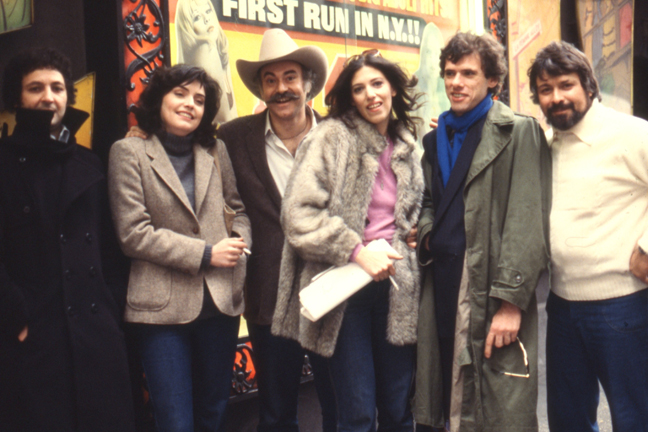 Lisa, with Marc Valentine, Colette Connor, Richard Milher, Roy Stuart and Ron Feilen
Lisa, with Marc Valentine, Colette Connor, Richard Milher, Roy Stuart and Ron Feilen
Centerfold-Fever-77d.jpg">Centerfold-Fever-77d.jpg" alt="Samantha Fox" width="648" height="445">Lisa with Samantha Fox and Bobby Astyr
Milner-shot-1.jpeg">Milner-shot-1.jpeg" alt="Harry Reems" width="648" height="481">Lisa, Harry Reems and others
LisaCintrice-Mag.jpg">LisaCintrice-Mag.jpg" alt="Lisa Cintrice" width="432" height="648">
cintrice-Mascara-a.jpg">cintrice-Mascara-a.jpg" alt="Mascara" width="648" height="349">Lisa and Ken Yontz, Mascara (1983)
Lisa-Cintrice-Blue-Dress.jpg">Lisa-Cintrice-Blue-Dress.jpg" alt="Lisa Cintrice" width="428" height="648">
*
Lisa Cintrice – After XXX
Lisa-Cintrice-Son.jpg">Lisa-Cintrice-Son.jpg" alt="Lisa Cintrice" width="638" height="648">
and-Son.jpg">and-Son.jpg" alt="Lisa Cintrice" width="416" height="648">
Lisa-Cintrice-Later-Family.jpg">Lisa-Cintrice-Later-Family.jpg" alt="Lisa Cintrice" width="648" height="486">
Lisa-Cintrice-Rebel.jpg">Lisa-Cintrice-Rebel.jpg" alt="Lisa Cintrice" width="486" height="648">
Lisa-Cintrice-Skinhead.jpg">Lisa-Cintrice-Skinhead.jpg" alt="Lisa Cintrice" width="648" height="515">
Lisa-Cintrice-Blonde.jpg">Lisa-Cintrice-Blonde.jpg" alt="Lisa Cintrice" width="648" height="486">
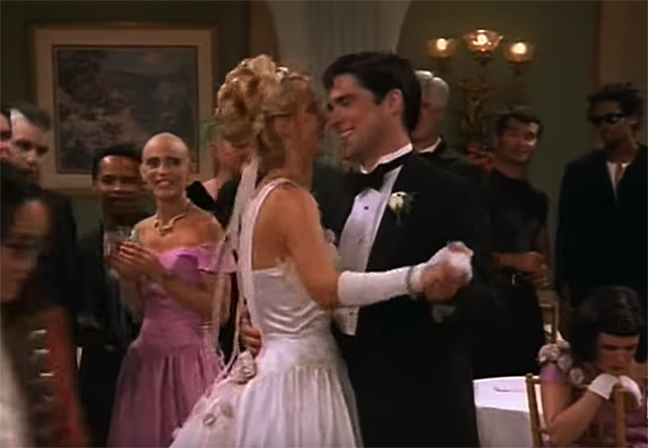 Lisa in pink in ‘Dharma and Greg’
Lisa in pink in ‘Dharma and Greg’
*
The post Lisa Cintrice: Not Being Afraid, Part 2 – Podcast 133 appeared first on The Rialto Report.
Lisa Cintrice had a colorful life: for a start, her father was a New York mobster who was related to the most famous Italian priest of all time, Padre Pio, a man so terrified of God that he manifested stigmata, the same wounds in his hands and feet that Jesus suffered when he was nailed to the cross.
And for much of her adult life, Lisa was afraid too – largely because of her career in adult film. In actual fact, she appeared in only a handful of movies in 1981 and 82. But what made her career particularly notable was that when she started, she’d already signed up to serve in the armed forces and was about to be deployed. She changed her mind at the last minute, choosing instead to make sex films, but getting out of the army contract wasn’t easy. And the way that she dealt with the problem was novel and controversial, and received a splash of publicity in the New York tabloids of the early 80s, when she turned up at the army recruitment center in – where else, Times Square – and promptly stripped off for the many newspaper photographers in attendance.
Lisa’s time in porn had highs and lows, living with Fred Lincoln and Tiffany Clark, partying with Jamie Gillis at the Hellfire club, and bumping into Richard Dreyfuss at Plato’s Retreat. But it also brought with it a drug habit that risked her life. As a result, Lisa did the only thing she could to survive: she fled New York and hid for over 30 years, terrified of having her past exposed. Trouble was, during that time, she got a recurring part in the TV series, Star Trek: Voyager – a franchise well-known for its obsessive and curious fans. To make matters worse, the internet happened – and suddenly her adult films were available to a whole new generation.
And then in 2015, The Rialto Report tracked Lisa down and contacted her for an article about her life – not realizing how she’d done everything to hide her porn past from prying eyes for several decades. Lisa panicked: this was her worst fear, and it risked collapsing her personal, family, and professional life.
Fast forward to the present day, and Lisa is now ready to talk about it all in this candid and personal interview. She’s even decided to write a book.
This is part 1 of Lisa’s story.
This episode running time is 62 minutes.
————————————————————————————————————
Lisa Cintrice
Cintrice-Young.jpg" alt="Lisa Cintrice" width="648" height="473">Little Lisa celebrating Christmas
Cintrice-Young-2.jpg" alt="Lisa Cintrice" width="501" height="648">Lisa with her mom and brother
Centrice-wedding.jpg" alt="Lisa's Wedding" width="635" height="648">Lisa’s wedding day
Centrice-father-wedding.jpg" alt="Lisa's wedding" width="648" height="620">Lisa’s father walks her down the aisle
Centrice-first-husband.jpg" alt="Lisa and her husband" width="434" height="648">Lisa and her husband
2.jpg">2.jpg" alt="Lisa Cintrice" width="611" height="648">Lisa in her first photo layout
1.jpg">1.jpg" alt="Lisa Cintrice" width="469" height="648">
Levenson.jpg">Levenson.jpg" alt="Ken Yontz" width="648" height="486">Ken Yontz and Larry Levenson, with Lisa
Stag-4-82-02.jpg" alt="" width="430" height="648">Lisa in The Starmaker
Adult-Cinema-3-82-031-1.jpg">Adult-Cinema-3-82-031-1.jpg" alt="Starmaker" width="648" height="485">
Lisa-Cintrice-Starmaker.png">Lisa-Cintrice-Starmaker.png" alt="Lisa Cintrice" width="648" height="519">
Lisa-Cintrice-Sardis2-1.jpeg">Lisa-Cintrice-Sardis2-1.jpeg" alt="Lisa Cintrice" width="433" height="648">
Lisa-Cintrice-Adult-Cinema-Cover.jpg">Lisa-Cintrice-Adult-Cinema-Cover.jpg" alt="Lisa Cintrice" width="491" height="648">
*
The post Lisa Cintrice: Not Being Afraid, Part 1 – Podcast 132 appeared first on The Rialto Report.
Seventy is no age to die. Especially not for a man as decent and good as Harvey Cohen. But last week, Harvey, who used to be the adult film star known as Herschel Savage, passed away in his home in Los Angeles.
Despite his performing pseudonym, Harvey was a gentle, sweet man, who’d chosen his nom de porn in an attempt to combine the nerdy New York Jewish self that he was with that of the sexual stud he pretended to be.
Over the years, I saw him frequently – we’d eat out at Musso and Frank’s on Hollywood Boulevard. Often, he was by himself, sometimes with his best friend and fellow porn veteran, Paul Thomas. Outwardly he looked great, in fact I always thought he looked better than he did back in the 1970s and 80s. But in other respects, time hadn’t been kind to him. He’d developed a series of health complaints, and last year suffered a serious heart attack – something he was keen to keep hidden from all but his closest friends. He was always entertaining, repeating George Carlin’s routine on the language of aging: you become 21, turn 30, push 40, but you reach 50, make it to 60, if you’re lucky you hit 70.
In fact, Herschel was 70 when he died. He’d struggled financially as well, and always berated himself for not being motivated to do something with his life.
The heart attack had been a wake-up call. “I need to get creative with how I earn some money,” he said. “Life is difficult when you’re poor. Not to mention boring.” He talked about a new one-man show that he was working on titled “Rich Man, Porn Man,” but in truth, he was struggling to make things happen anymore.
I interviewed Herschel for this Rialto Report podcast almost exactly 10 years ago to the day. Neither of us really knew what we were doing. I was still new to the podcast game, and Herschel wasn’t used to being asked personal questions about his life. And, as it turned out, it got us both into a little trouble. Herschel more trouble than me.
You see, Herschel had been interviewed by a Harvard University student a few months before for a project that a student been doing for her degree course. Turns out, Herschel and she had become friendly and had started a relationship. She’d found Herschel to be far from the coarse, crude, misogynistic porn star she’d expected to encounter, but rather an intelligent, cultured, and sensitive man – who’d practiced Buddhism for the previous forty years.
And then we did the Rialto Report interview that you’re about to hear: in it, Herschel is frank, unfiltered, and brutally honest about his life and thoughts on the adult film business. When his new girlfriend listened to it, she was shocked. She called him as soon as she heard it and expressed how upset and disappointed she was. This wasn’t the Herschel she knew, she said. I didn’t want Herschel to suffer as a result of having done an interview with me, so I bought him an air ticket to visit his girlfriend so he could have the chance to explain and repair the relationship. It was to no avail: Herschel took the flight, but no amount of sweet talking could fix the situation, and they split shortly afterwards. Not one of The Rialto Report’s proudest moments.
Over the last few years, I would hear from Herschel on a daily basis. He would send news articles to me on WhatsApp, declaring he was my news and literary concierge. He would often add a comment about why he wanted me to read the article.
Ten days ago, Herschel unexpectedly sent me photos. Tens of them. From all stages of his life from when he was a boy through to recent pictures. “You can use these on The Rialto Report soon,” he said.
The last article I received from him was on the day before he passed: “I want you to read every word of this,” he wrote next to a link. The article was entitled: “How to life a long and happy life.”
Rest in Peace, Harvey.
———————————————————————
Photos sent by Herschel Savage to The Rialto Report last week:
fe990814-358e-4f81-b09b-641e7d3244fd.jpg">fe990814-358e-4f81-b09b-641e7d3244fd.jpg" alt="Herschel Savage" width="648" height="343">
3fa14916-ffdf-41f7-93f2-3f03f0a69fba.jpg">3fa14916-ffdf-41f7-93f2-3f03f0a69fba.jpg" alt="Herschel Savage" width="648" height="648">
1a9944ec-b173-44c8-8149-d45a445318fc.jpg">1a9944ec-b173-44c8-8149-d45a445318fc.jpg" alt="Herschel Savage" width="648" height="429">
4daab12b-7d79-4c71-a376-a71ef734a9aa.jpg">4daab12b-7d79-4c71-a376-a71ef734a9aa.jpg" alt="Herschel Savage" width="636" height="648">
fd47182a-49c9-47e2-a827-bfdb19a67268.jpg">fd47182a-49c9-47e2-a827-bfdb19a67268.jpg" alt="Paul Thomas" width="648" height="557">
2022-03-27-23.42.11.jpg">2022-03-27-23.42.11.jpg" alt="Paul Thomas" width="648" height="484">
34f254de-847e-455b-9ec0-b0a1f6d25e23.jpg">34f254de-847e-455b-9ec0-b0a1f6d25e23.jpg" alt="Paul Thomas" width="544" height="648">
7dd66e08-7fe1-4eb9-ba94-1bdb1b432029.jpg">7dd66e08-7fe1-4eb9-ba94-1bdb1b432029.jpg" alt="Richard Pacheco" width="648" height="486">
d2058585-c8fb-4e49-b1a4-da2ee66f28ce.jpg">d2058585-c8fb-4e49-b1a4-da2ee66f28ce.jpg" alt="Herschel Savage" width="648" height="432">
a7e34269-4b52-45b8-a0f1-f186bc7f70c9.jpg">a7e34269-4b52-45b8-a0f1-f186bc7f70c9.jpg" alt="Ron Jeremy" width="648" height="484">
0372358f-23dc-4aea-be5d-621ae040407a.jpg">0372358f-23dc-4aea-be5d-621ae040407a.jpg" alt="Christy Canyon" width="648" height="648">
60908f44-2b02-44e8-adc2-644656d9187c.jpg">60908f44-2b02-44e8-adc2-644656d9187c.jpg" alt="Herschel Savage" width="648" height="484">
2012-08-08-13.03.14.jpg">2012-08-08-13.03.14.jpg" alt="Ginger Lynn" width="550" height="648">
2007eac7-2ddd-4a30-81a1-aac02b9dfd70.jpg">2007eac7-2ddd-4a30-81a1-aac02b9dfd70.jpg" alt="Christy Canyon" width="486" height="648">
77b5ab7e-accb-40dc-a44b-b9515b9c3e26.jpg">77b5ab7e-accb-40dc-a44b-b9515b9c3e26.jpg" alt="Herschel Savage" width="365" height="648">
81c2ef40-bdef-4c1f-bd79-1aab492881bc.jpg">81c2ef40-bdef-4c1f-bd79-1aab492881bc.jpg" alt="Herschel Savage" width="648" height="486">
1bb7b389-6604-496b-926f-ca9d8a3e6c14.jpg">1bb7b389-6604-496b-926f-ca9d8a3e6c14.jpg" alt="Leslie Winston" width="486" height="648">
fec0d34c-5ef7-4279-9095-7c39e1bd20ab.jpg">fec0d34c-5ef7-4279-9095-7c39e1bd20ab.jpg" alt="Herschel Savage" width="648" height="486">
ba00877d-f04e-419c-8a10-36066ef8ea6d.jpg">ba00877d-f04e-419c-8a10-36066ef8ea6d.jpg" alt="Herschel Savage" width="648" height="405">
b49601b4-953b-4484-bfe6-3f1618bd2861.jpg">b49601b4-953b-4484-bfe6-3f1618bd2861.jpg" alt="Herschel Savage" width="648" height="306">
ae3707cd-1d68-4233-8d25-07a054480a56.jpg">ae3707cd-1d68-4233-8d25-07a054480a56.jpg" alt="Herschel Savage" width="648" height="433">
1272a72a-ae1c-4f08-81d8-2a5962e94301.jpg">1272a72a-ae1c-4f08-81d8-2a5962e94301.jpg" alt="Herschel Savage" width="648" height="486">
42106c3e-27f5-46a2-93e9-94b1f395d7cf.jpg">42106c3e-27f5-46a2-93e9-94b1f395d7cf.jpg" alt="Herschel Savage" width="486" height="648">
59ddb54e-1de4-4182-a5fd-8d95893e229c.jpg">59ddb54e-1de4-4182-a5fd-8d95893e229c.jpg" alt="Herschel Savage" width="648" height="486">
adee10de-5f66-43e5-82c7-757a78075ab0.jpg">adee10de-5f66-43e5-82c7-757a78075ab0.jpg" alt="Herschel Savage" width="648" height="579">
52997123-513b-45f7-8a16-84a1eb5f98f3.jpg">52997123-513b-45f7-8a16-84a1eb5f98f3.jpg" alt="Herschel Savage" width="648" height="625">
2012-09-09-18.56.37.jpg">2012-09-09-18.56.37.jpg" alt="Herschel Savage" width="486" height="648">
d8204358-9cd9-4a3f-8832-199caadf4e20.jpg">d8204358-9cd9-4a3f-8832-199caadf4e20.jpg" alt="Herschel Savage" width="648" height="486">
*
The post R.I.P. Herschel Savage (1952 – 2023) appeared first on The Rialto Report.
This podcast could use a review! Have anything to say about it? Share your thoughts using the button below.
Submit Review
